All Summer Beauty
Fuchsia ‘All Summer Beauty’ (De Cooker, 2013) originates from the crossing ‘Remembering Claire’ x {(‘Checkerboard’ x ‘Machu Picchu’) x (‘Checkerboard’ x ‘Machu Picchu’)}. It is a vigorous seedling from 2008, which cannot deny its ancestry. Fuchsia ‘All Summer Beauty’ is a trailing fuchsia, making long branches, and performs at best as an older plant, 3-5 plants in a basket. In the first year, proper shaping of the young plant is somewhat difficult, so some patience is required. Overwintering does not cause any problems and regrowth starts early. Without pinching, flowering starts already early to mid June; pinching once or twice adds however to a better shaped plant. The cultivar’s name is derived from the fact that it flowers incessantly all summer through. Heat and sun are not a problem. Best performance however if not exposed to direct sunlight for the whole day long. This fuchsia never disappoints, whatever the weather.
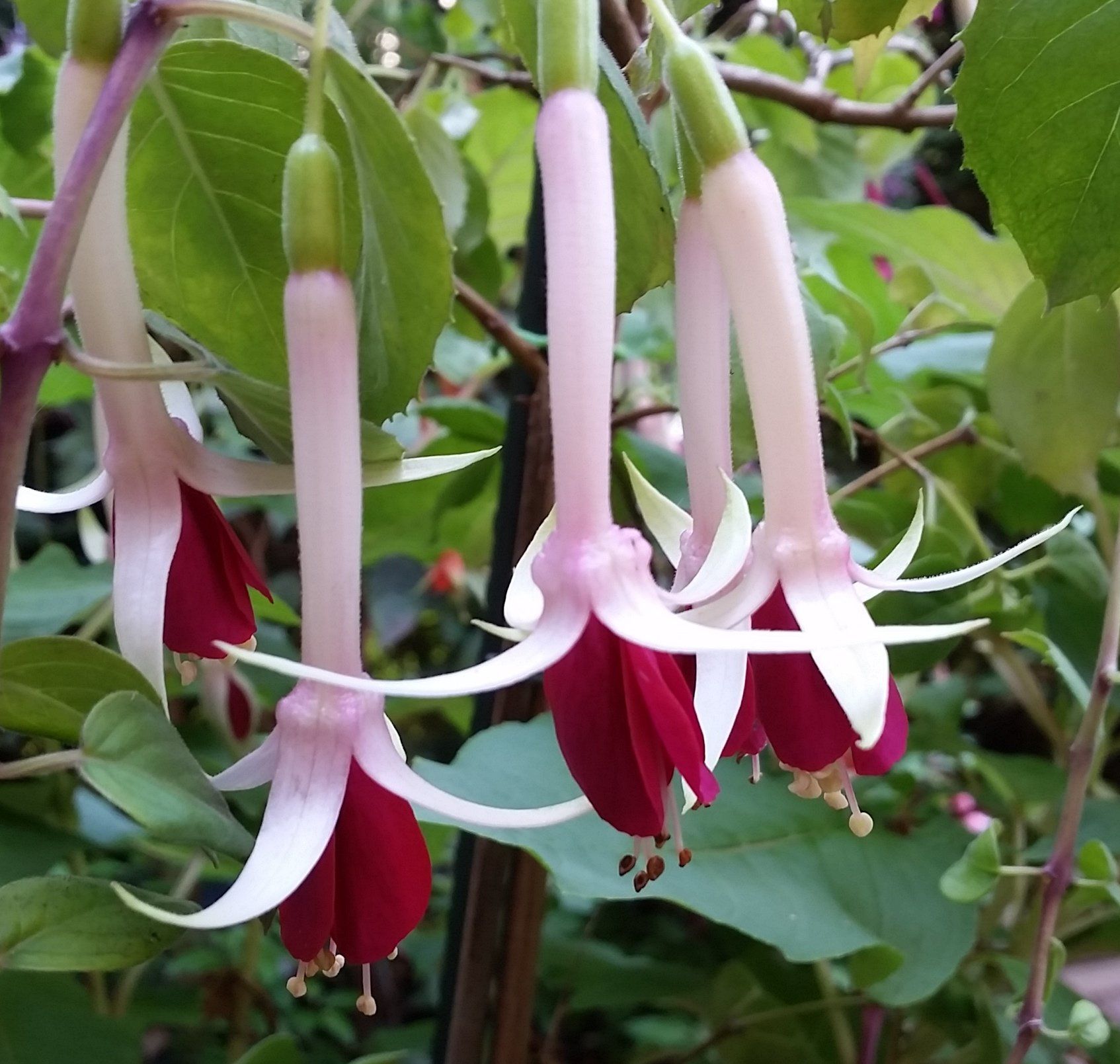
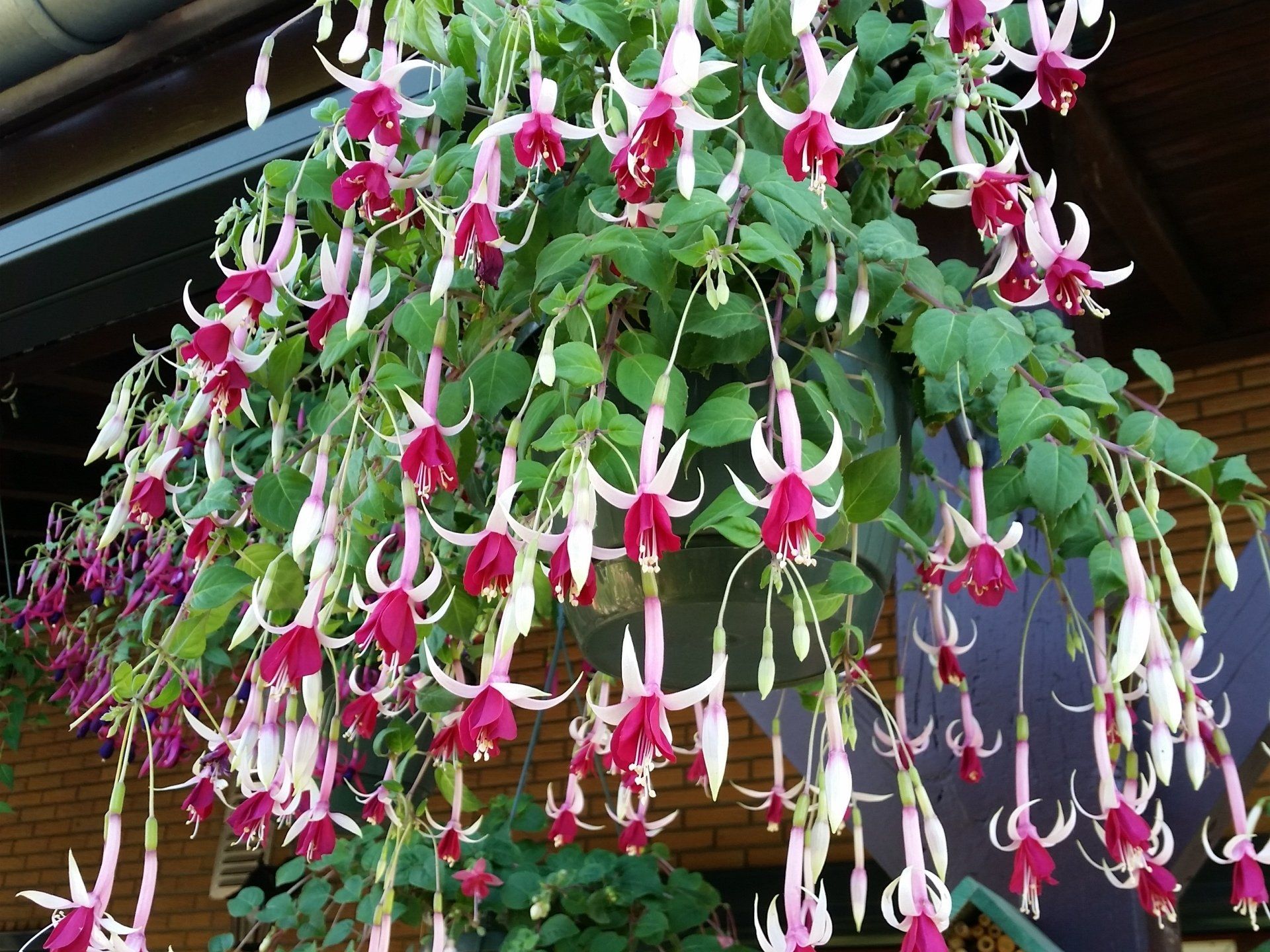
Awake Sweet Love
Fuchsia ‘Awake Sweet Love’ (De Cooker, 2011) is a seedling from the year 2003, originating from the crossing ‘Roger de Cooker’ x (('Checkerboard' x 'Machu Picchu') x ('Checkerboard' x 'Machu Picchu')). It is a semi-trailing variety and has a soft light pink, triphylla-shaped flower. Best colour is obtained if grown in a light, but shaded area. If protected from direct sunlight, the flowers become even nearly white. It can be grown from cuttings or as as an older plant, but growing it as a standard will be somewhat disappointing. Best results are obtained if grown from cuttings taken in January/February, 5 – 10 cuttings in a basket or container. The cuttings should be pinched twice or even three times, and protected from botrytis. Flowering is then from the end of June, continuously until the end of the season.
The fuchsia ‘Awake Sweet Love’ is named after a song of the famous 16th century British lutenist John Dowland.
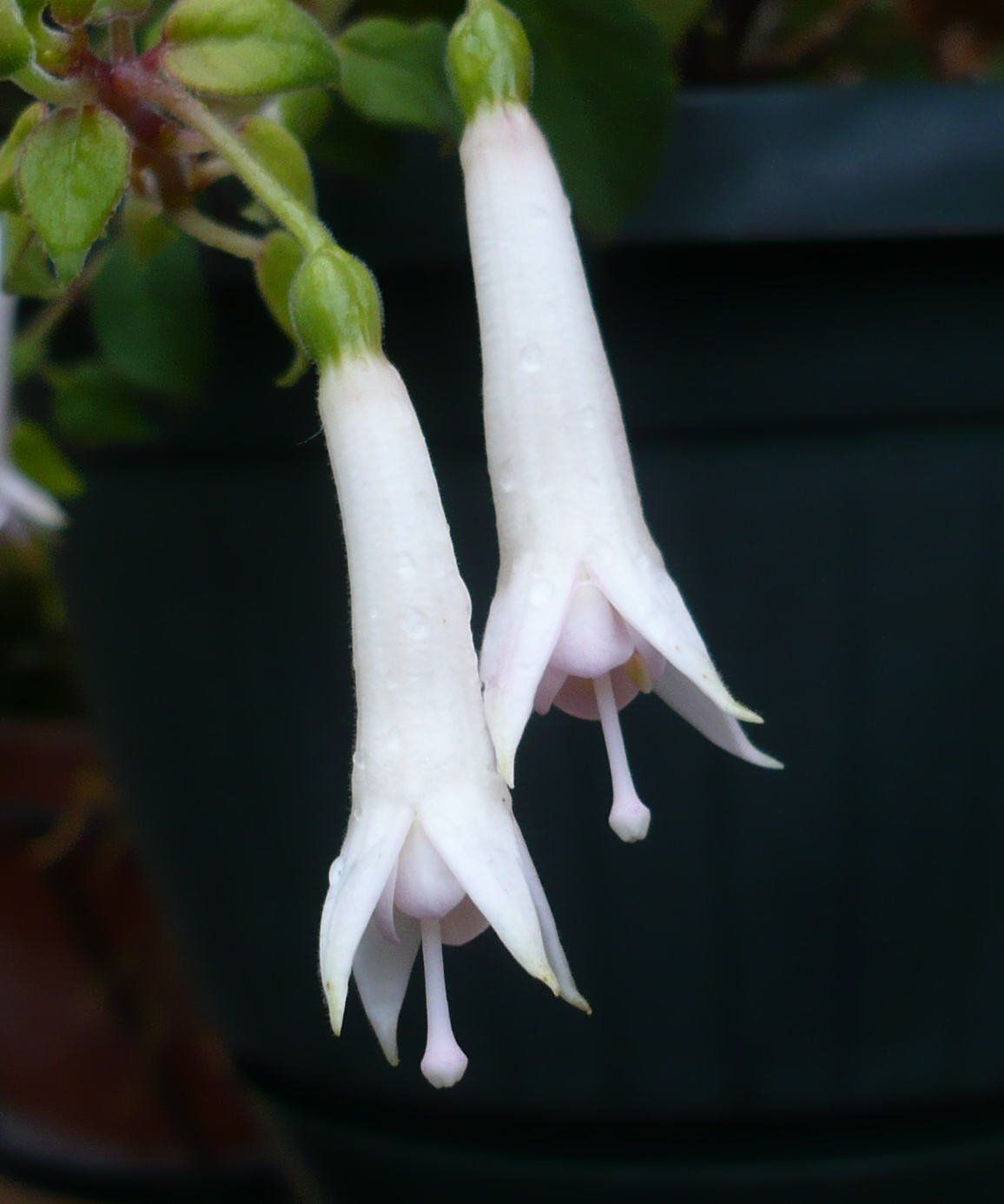
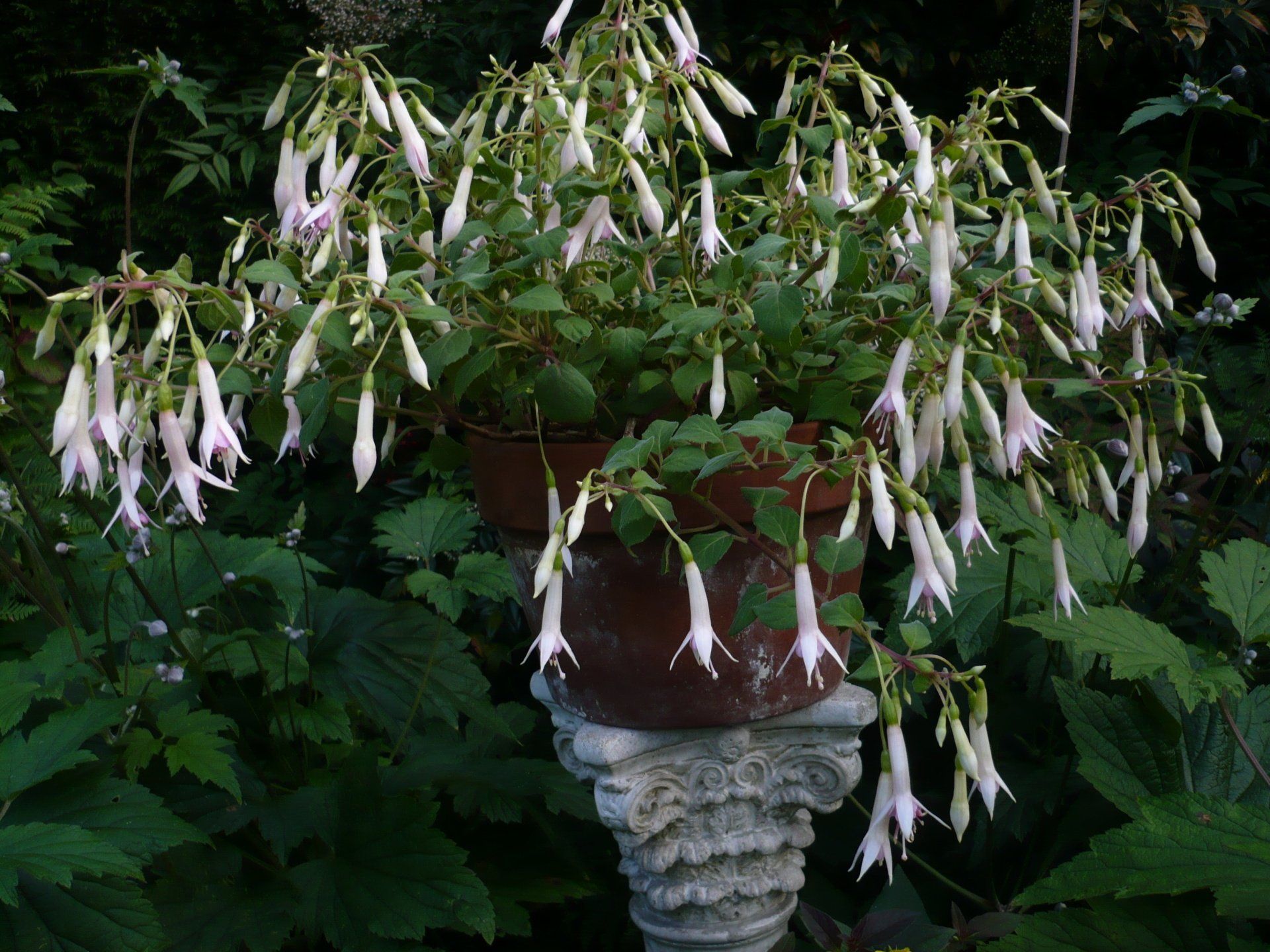
Babs Bellefleur
Fuchsia ‘Babs Bellefleur’ (De Cooker, 2023) originates from the crossing ‘Our Ophelia’ x F. fulgens ‘Grandiflora’. It is easy to grow and flowers profusely throughout the season. It makes its blooms on large terminal racemes and can be grown as a trailing plant in a basket or as a small standard.
Fuchsia ‘Babs Bellefleur’ is named after Babs Bellefleur, the Counselor and Problem Solver of our local Fuchsia Society ’Limburgs Belleke’. For this, she has a special column in our Society Magazine.
‘Babs Bellefleur’ can be grown from young cuttings, several cuttings in a basket. To get flowers early in the season, an early start is then recommended. If grown as an older plant and pruned in October it can be overwintered in the cold greenhouse without any problems.

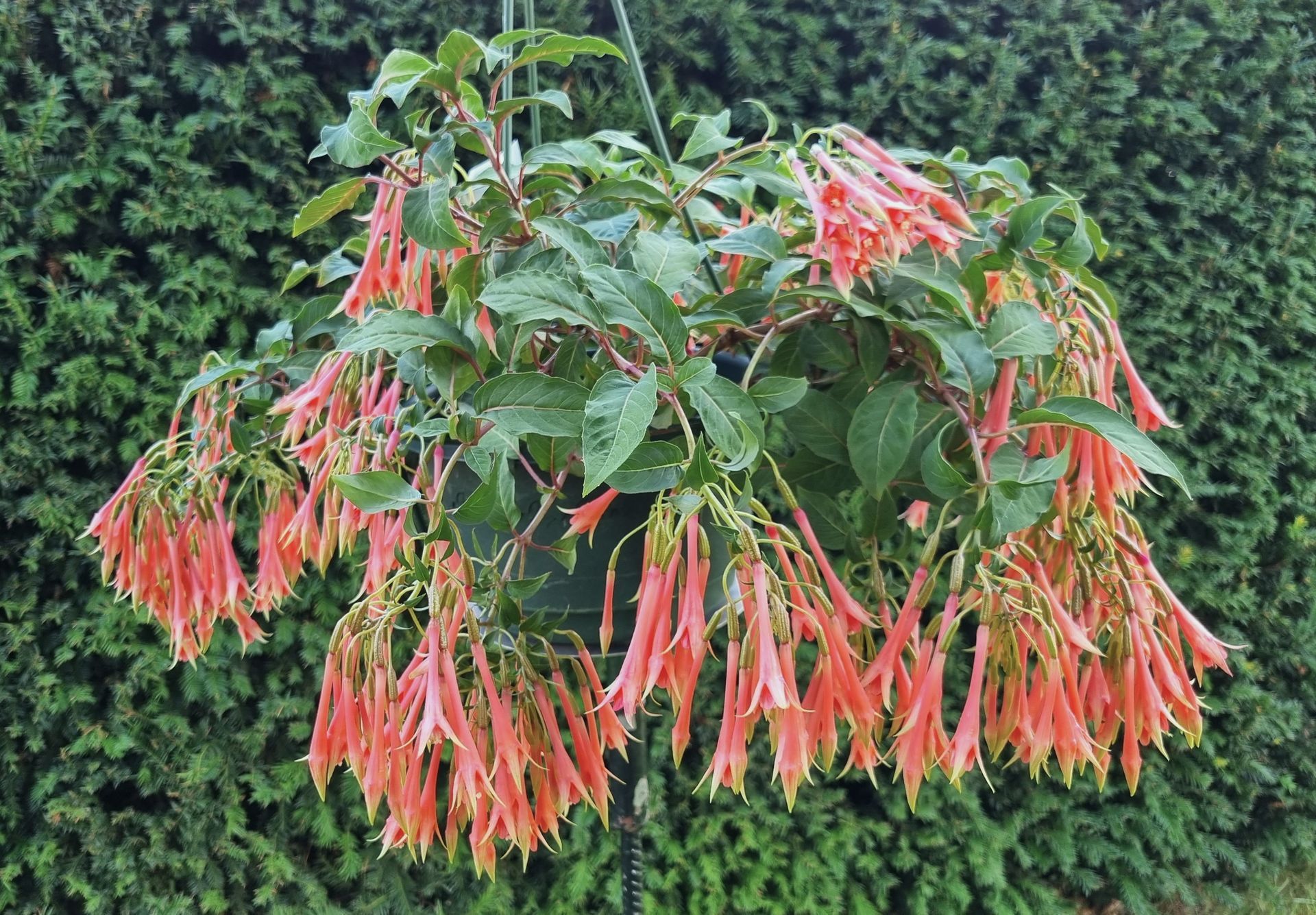
Belle de Limbourg
Fuchsia 'Belle de Limbourg' (De Cooker, 1991) is one of the first new fuchsias I grew. The seed was collected from a picked berry and sown in 1989. In the first year it refused to produce flowers, but I kept it anyway because I had only few seedlings. Its parentage is 'Suzanna' x Unknown.
The name 'Belle de Limbourg' is inspired by 'Belle de Spa' and 'Belle de Lisse' and, obviously, by the province of Limburg.
It can be grown as a bush or small standard and performs well as an older plant or grown from young cuttings. Overwintering in the cold greenhouse is without any problems.
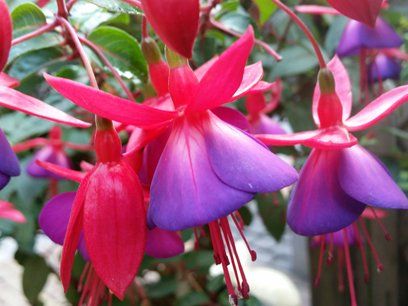
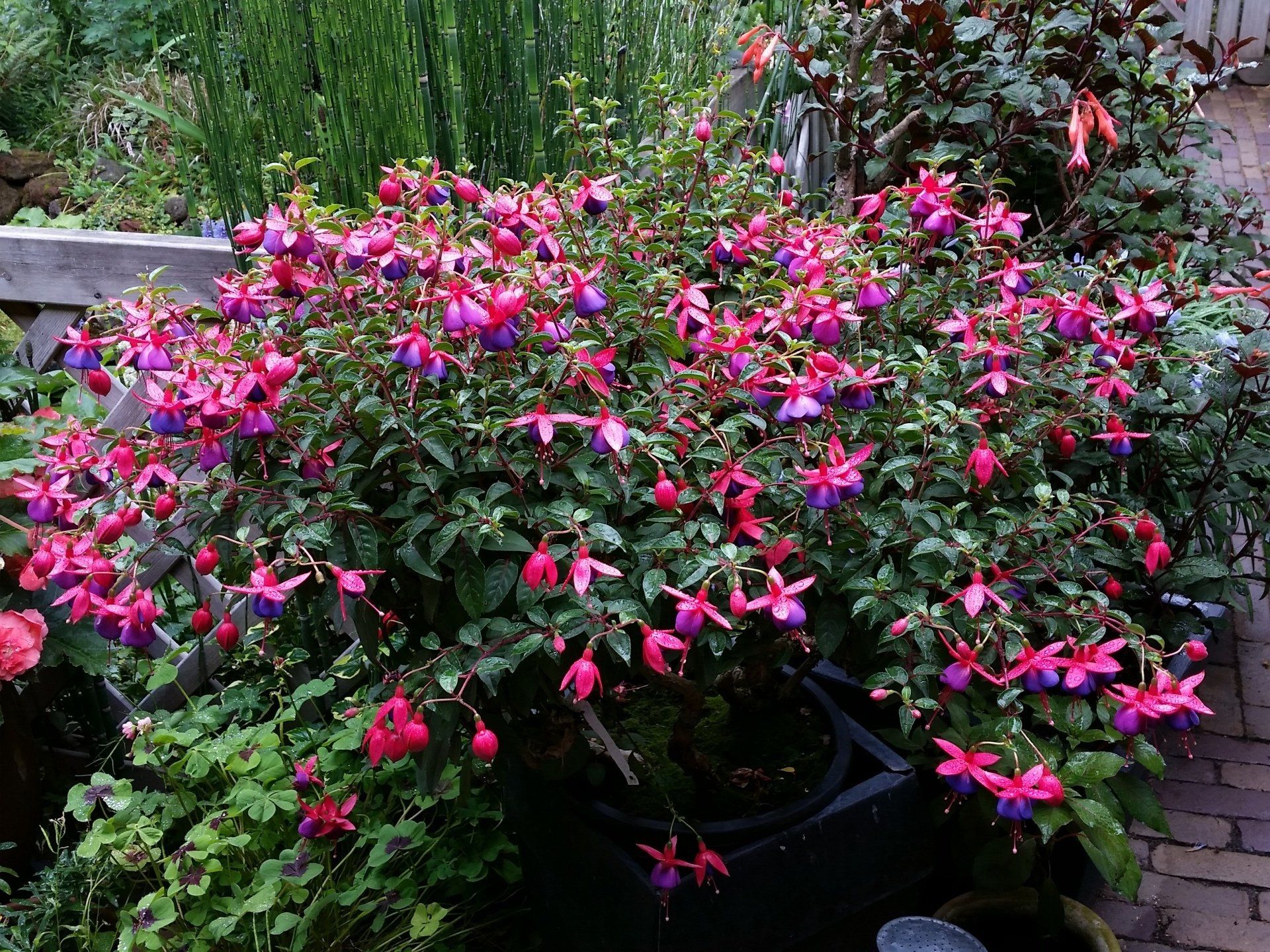
Blue Rebel
Fuchsia 'Blue Rebel' De Cooker, 1993) originates from the crossing 'Elisabeth Honorine' x 'Impudence'. It is a semi-trailing variety, that prefers to be grown in dappled shade. Prefers not too high temperatures in the summer season.
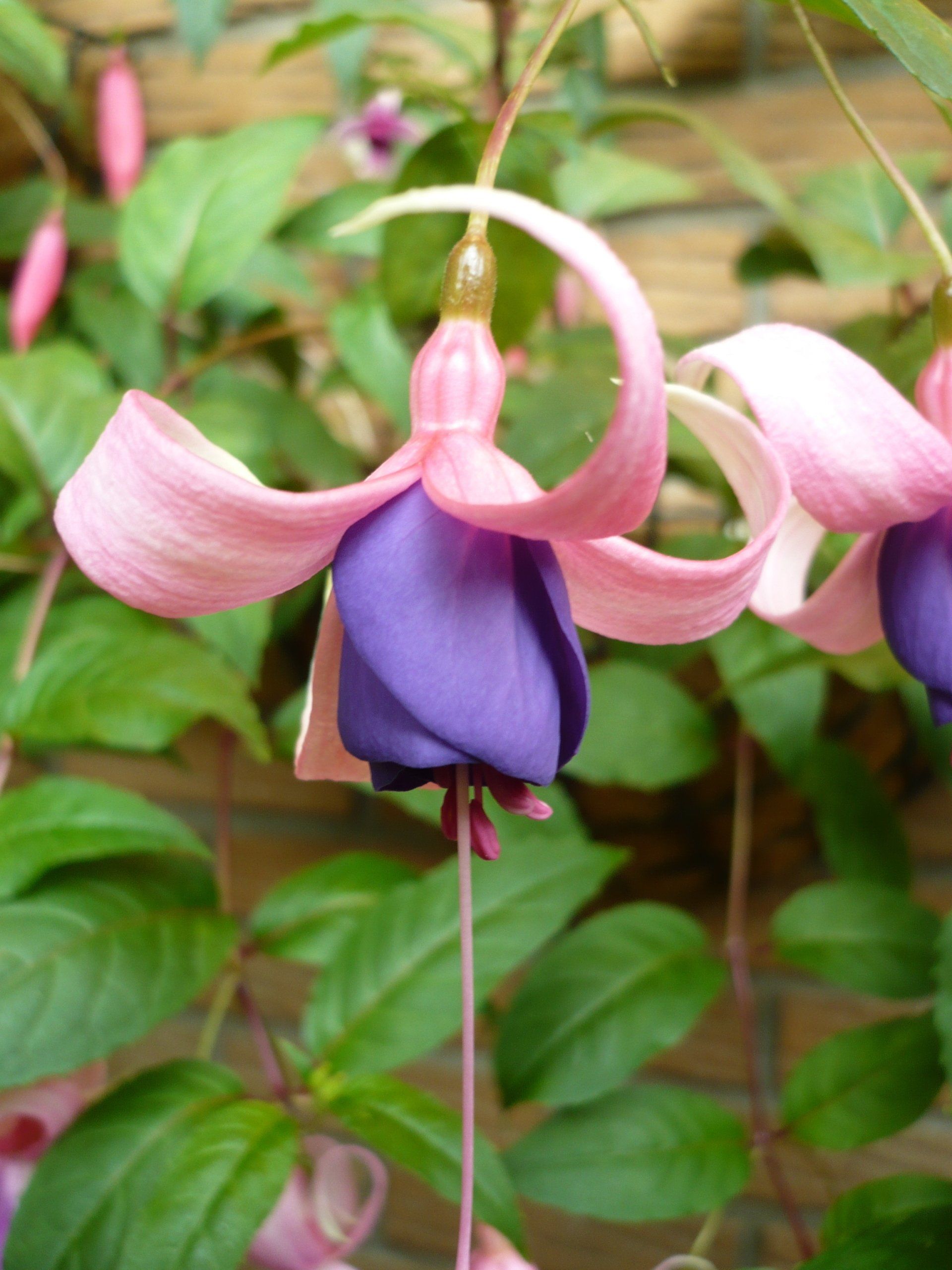
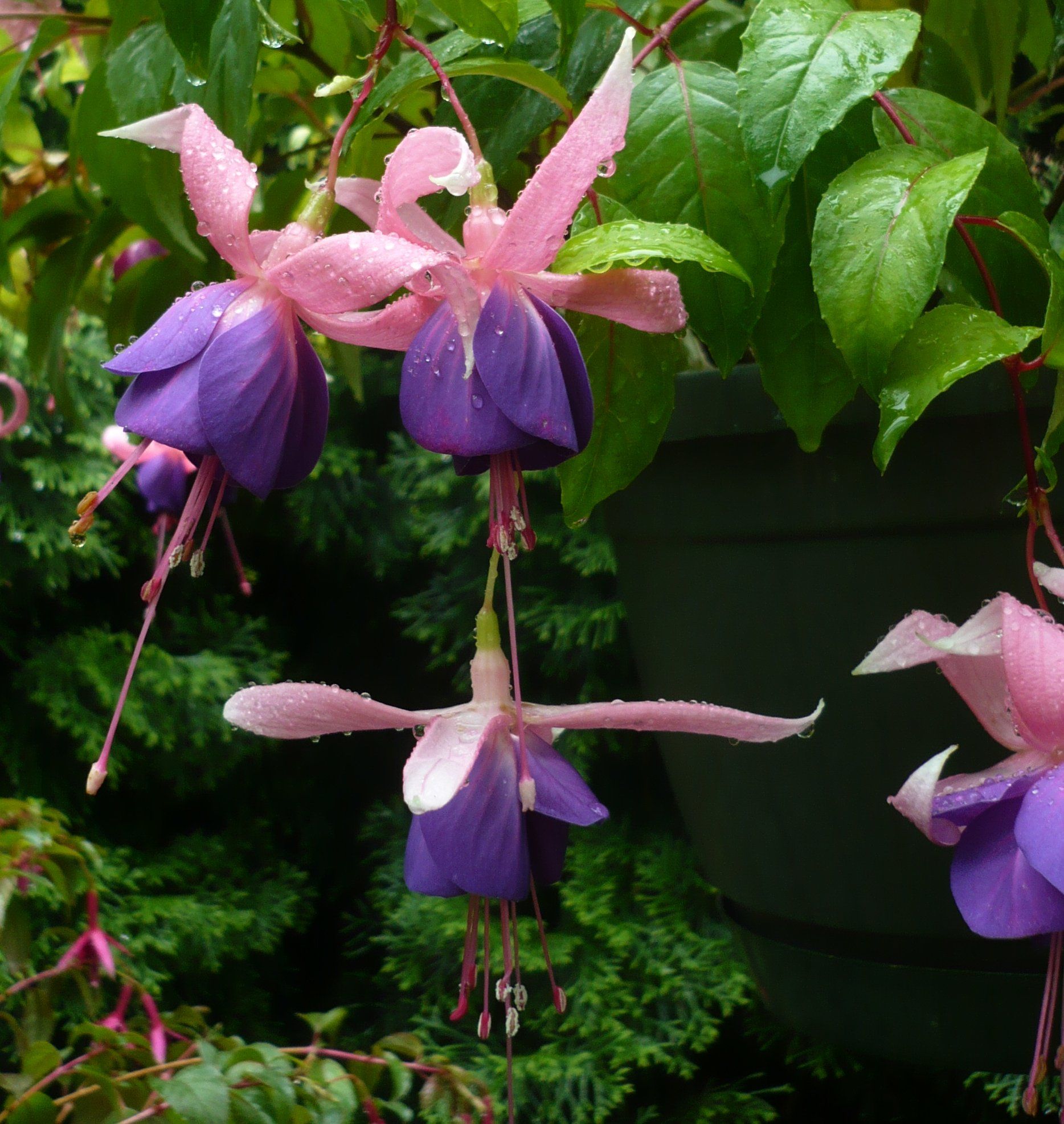
Butterfly Dance
Fuchsia ‘Butterfly Dance’ (De Cooker, 2010) is a trailing triphylla hybrid cultivar, originating from the crossing (Göttingen x Our Ted) x (Göttingen x Our Ted). It has attractive dark green/brown foliage. The flower is characterised by its spoonbill petals. It should not be pinched, or at least only once early in the season, otherwise it will start flowering rather late. It grows without any problems and performs well both as a young or as an older plant.
Fuchsia ‘Butterfly Dance’ is named after a after a part of the semi-opera The Prophetess, a composition of the well-known British composer Henry Purcell (late 16th century).

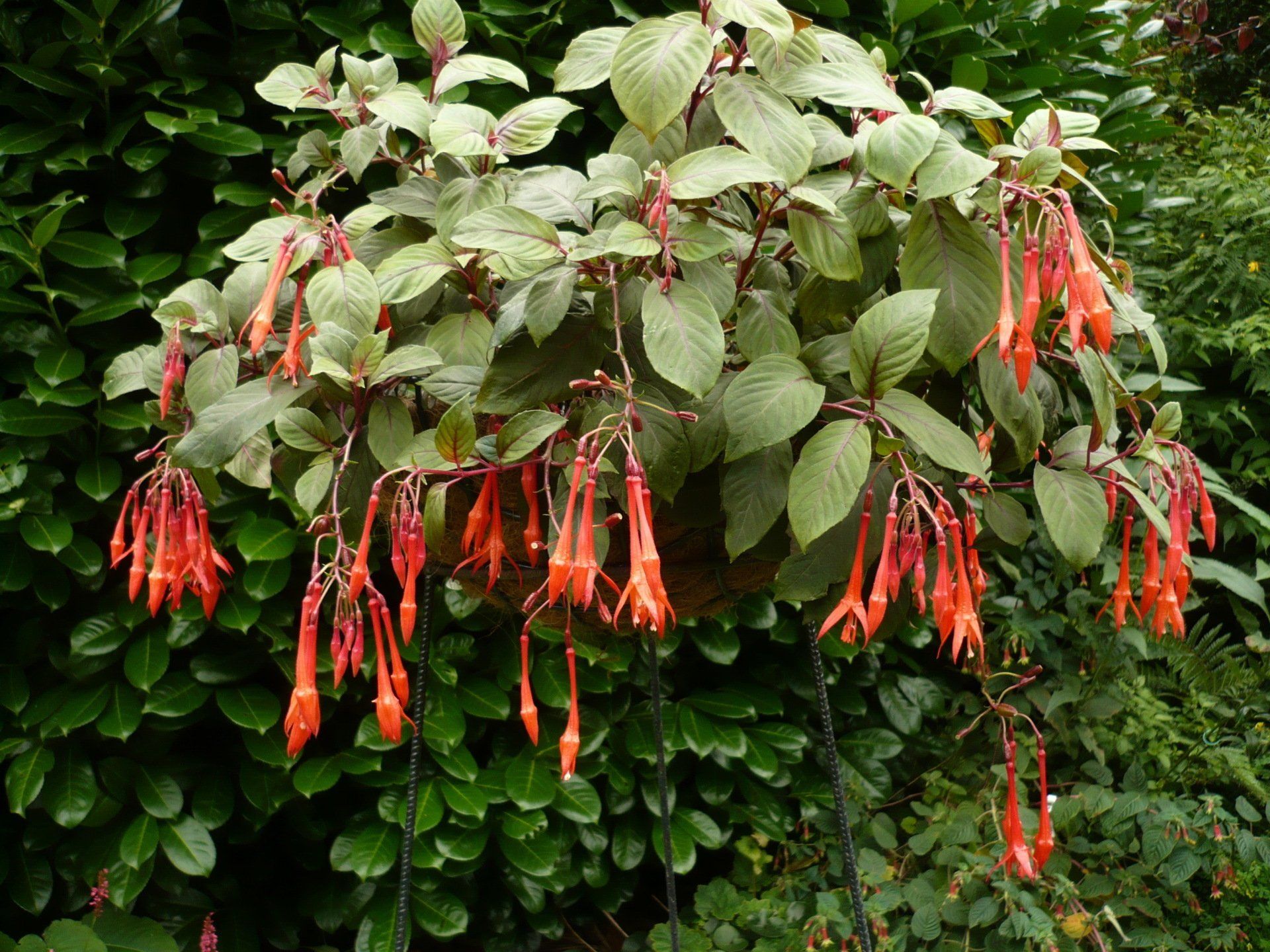
Candy Ball
Fuchsia ‘Candy Ball’ (De Cooker, 2015) is a triphylla hybrid cultivar originating from the crossing Fuchsia triphylla ‘HvdP’ x (‘Playboy x Unknown’.
It is best grown as a bush or semi-trailing plant in a somewhat sheltered position, in any case in filtered light at high temperatures during summer. It can be grown from young cuttings or as an older plant. Overwintering is without any problems.
The cultivar's name ‘Candy Ball’ reflects the bright shining pink colour of the flowers, in combination with the tube being shaped like a small round to oval ball.
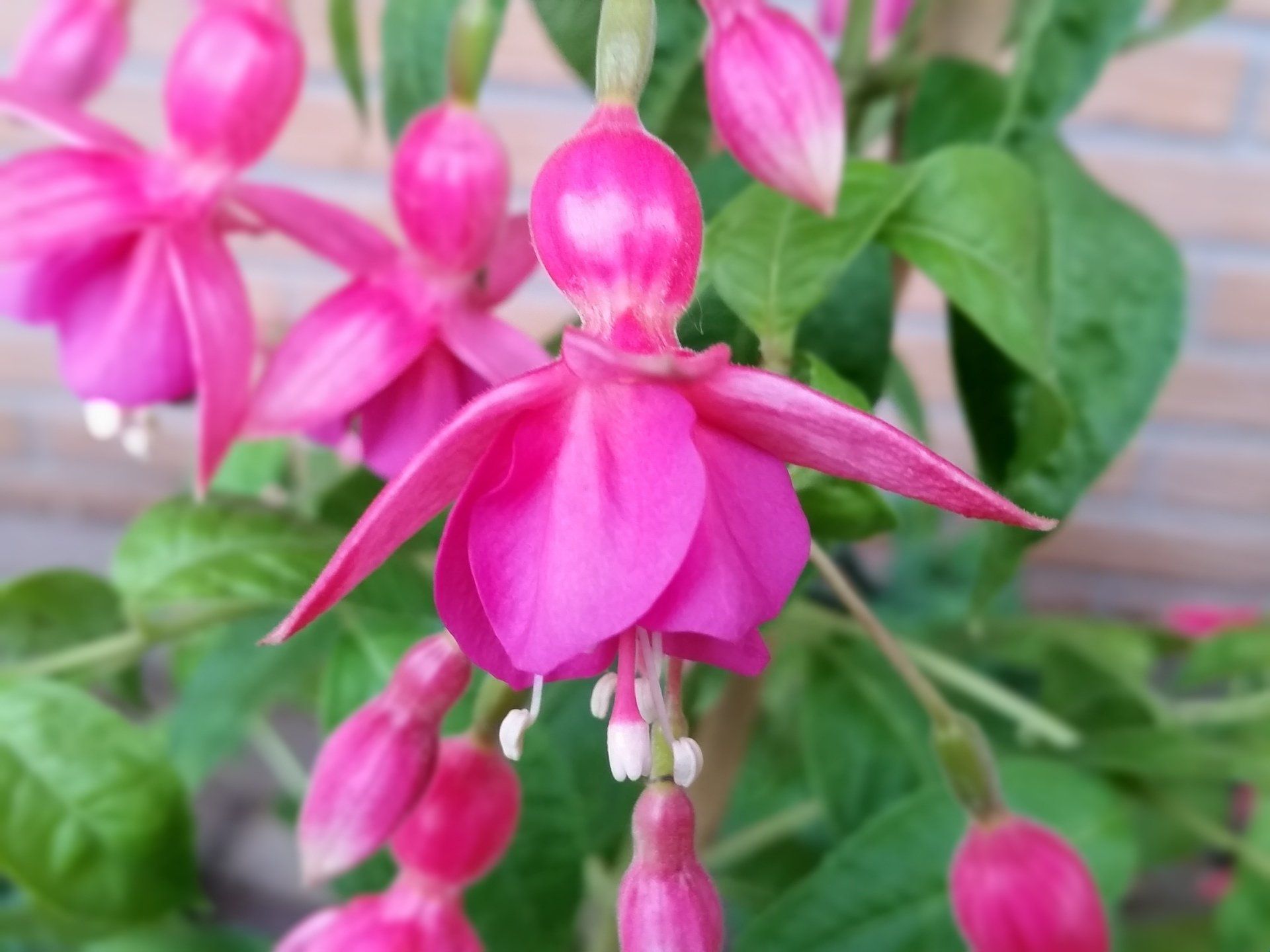

Claire Marie McManus
Triphylla Fuchsia ‘Claire Marie McManus’ (De Cooker, 2020) originates from the crossing Göttingen’ x ‘Our Ted’) x F. fulgens ‘Grandiflora’. It stems from the same series of crossings in 2014 from which the mini-triphyllas ’Silence Is Golden’ and ’Skyward Dwarf’ also originated.
Fuchsia ‘Claire Marie McManus’ has been named after British fuchsia enthusiast Mr. Keith McManus’ youngest daughter, who sadly passed away in 2002 only a few months after Keith also lost his wife.
Fuchsia ‘Claire Marie McManus’ is a healthy, strong cultivar with interesting dark green foliage and a wealth of pink triphylla flowers all summer through.
It tolerates sun and high temperatures, but prefers filtered light during part of the day. It can best be grown as a bush fuchsia or (although not being a real mini-triphylla) relatively small standard.
If left unpinched after proper shaping of the plant for a couple of years, it will flower from early June till the end of the season with large racemes. Overwintering in the cold greenhouse does not cause any problems.
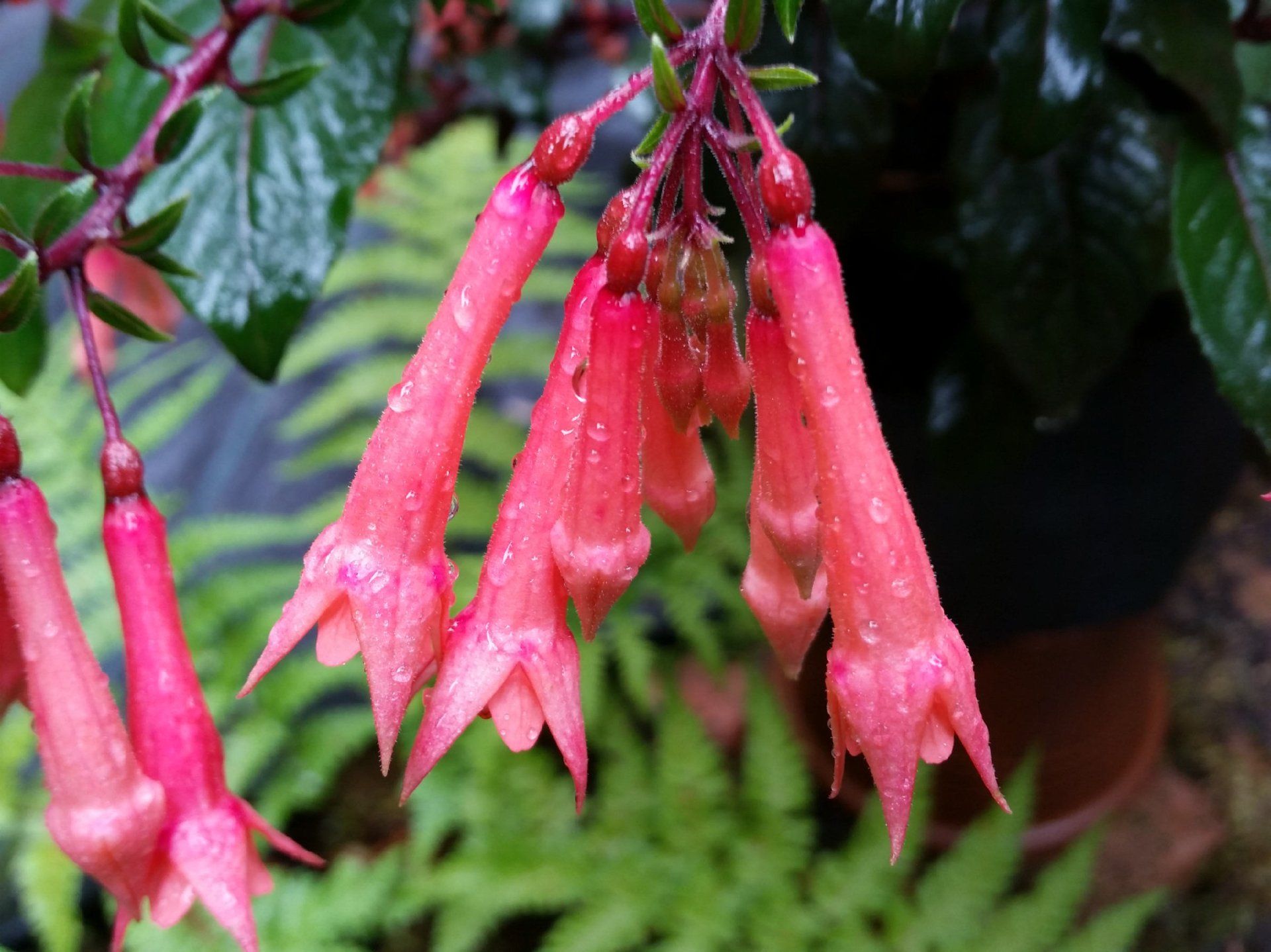
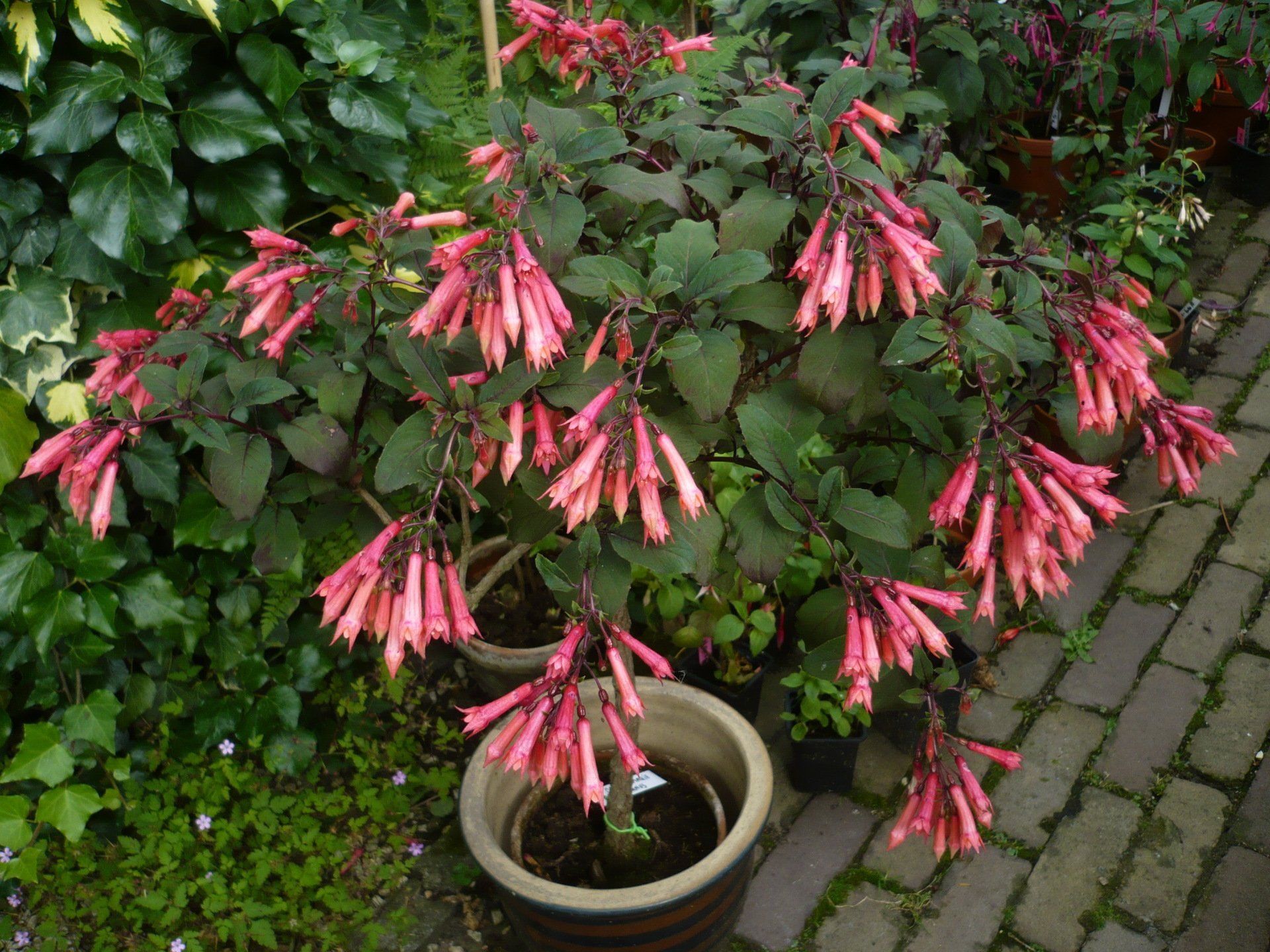
Delicate Blue
Semi-trailing Fuchsia ‘Delicate Blue’ (De Cooker, 1994) originates from the crossing {'Zulu Queen' x ('Elsie Mitchell' x
F. magellanica ‘Alba’)} x ('Checkerboard' x 'Machu Picchu').
It can be grown as a bush or semi-trailing fuchsia.
'Delicate Blue' is a hardy variety, so overwintering does not cause any problems.
The name ‘Delicate Blue ’ is one of a series together with 'Delicate White' (De Cooker, 1994) and 'Delicate Purple' (De Cooker, 2004).
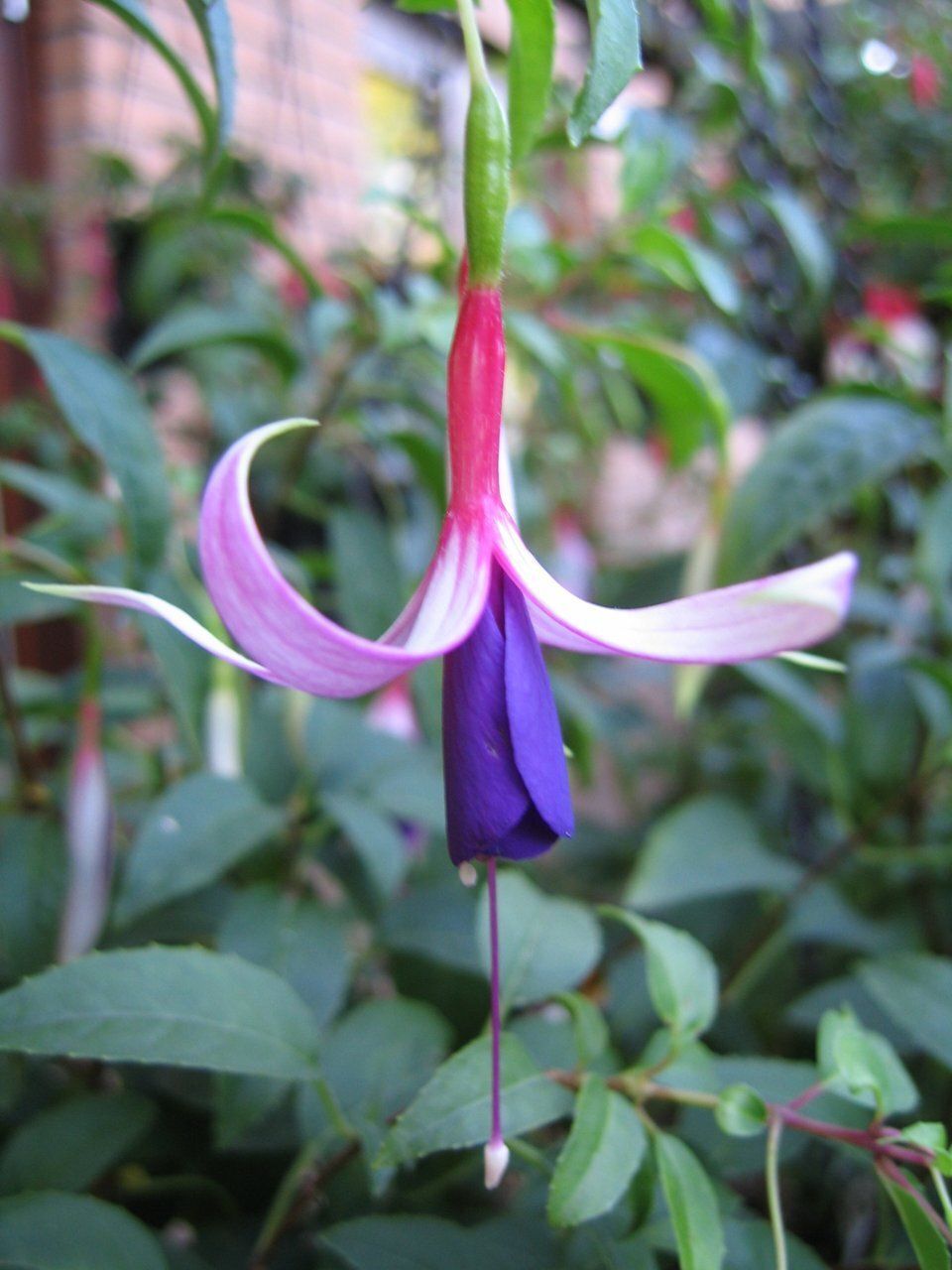
Delicate Purple
Trailing fuchsia ‘Delicate Purple’ (De Cooker, 2004) originates from the crossing 'Delicate Blue' x 'Wilson’s Pearls'. Growth of this strong cultivar is without any problems, both as an older plant or from new cuttings. It flowers abundantly with deep purple single flowers, which are at their best in the evening light of the August/September sun.
The name ‘Delicate Purple’ is one of a series together with 'Delicate White' (De Cooker, 1994) and 'Delicate Blue' (De Cooker, 1994).
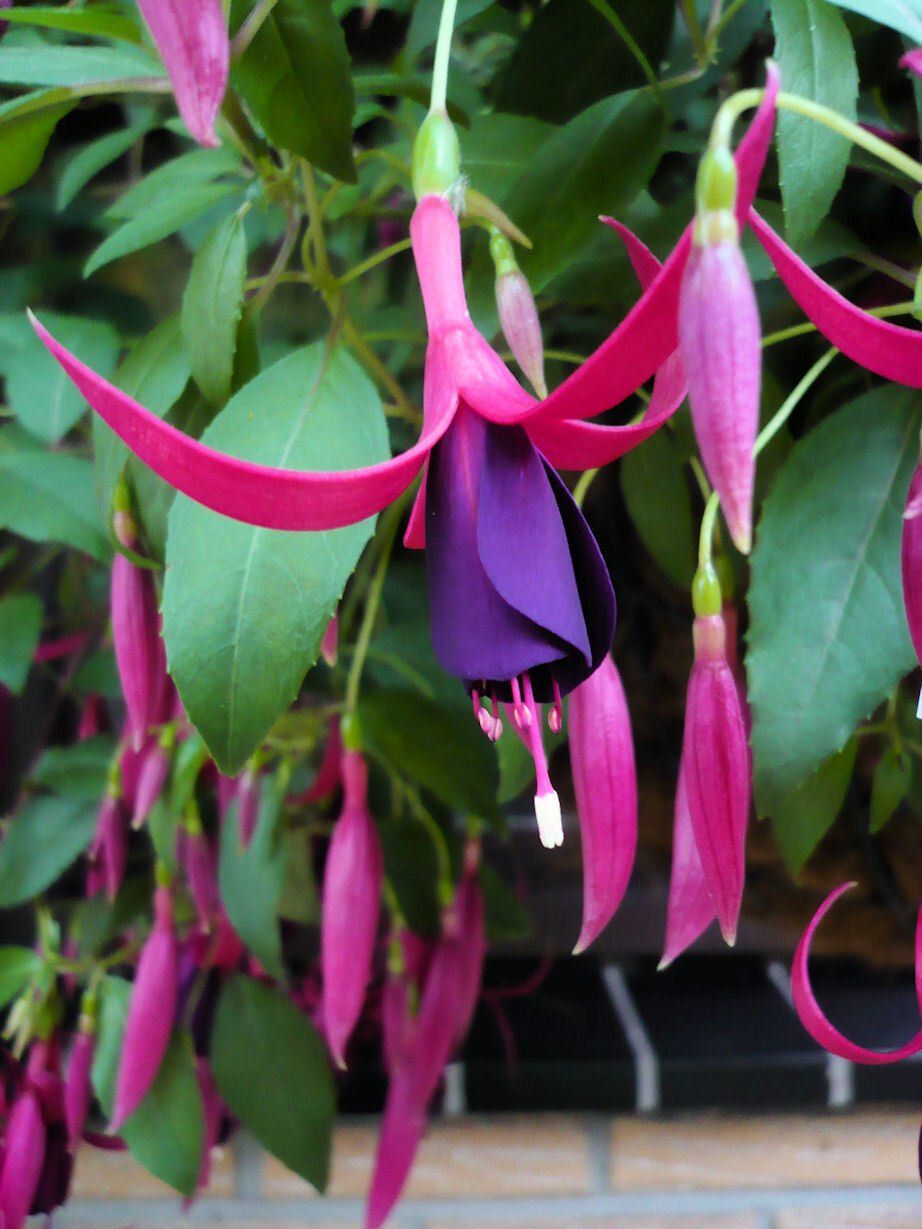
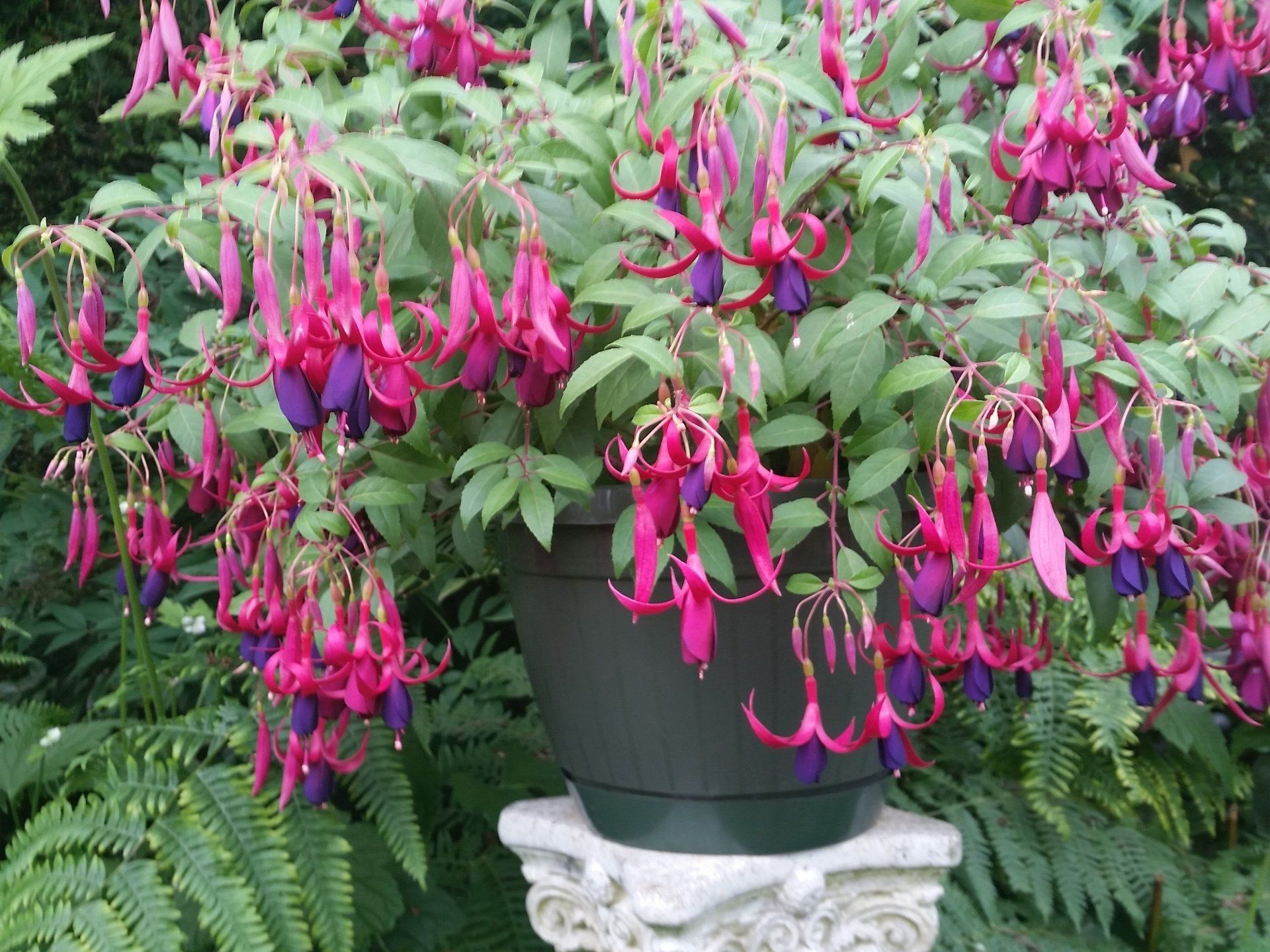
Delicate White
Fuchsia ‘Delicate White’ (De Cooker, 1994) originates from crossing (('Elsie Mitchell' x F. magellanica ‘Alba’) x F. procumbens) x self. It can be grown as a bush or a standard.
It has inherited its winter hardiness from F. magellanica ‘Alba’.
The name ‘Delicate White’ is one of a series together with 'Delicate Purple' (De Cooker, 2004) and 'Delicate Blue' (De Cooker, 1994).
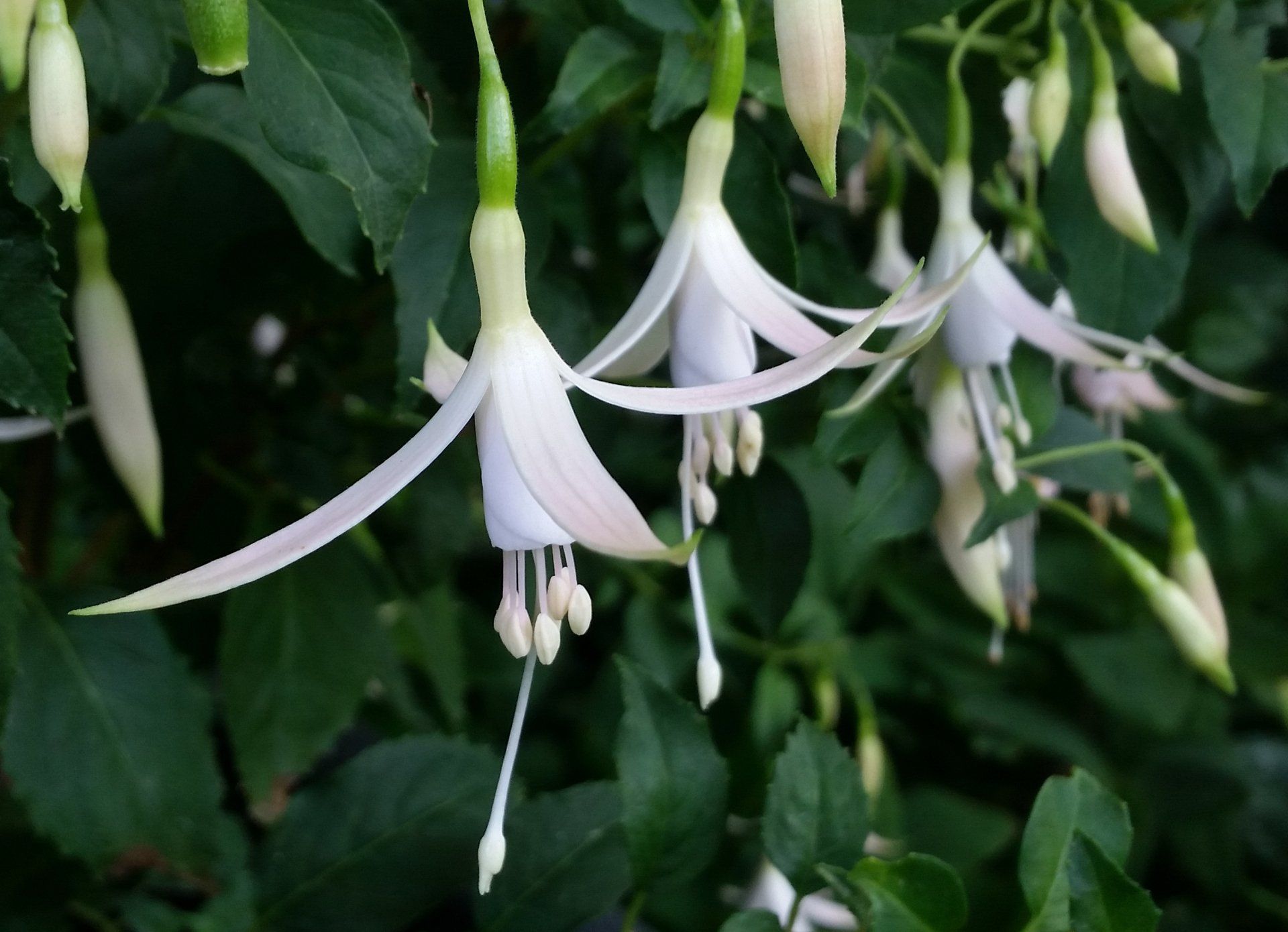
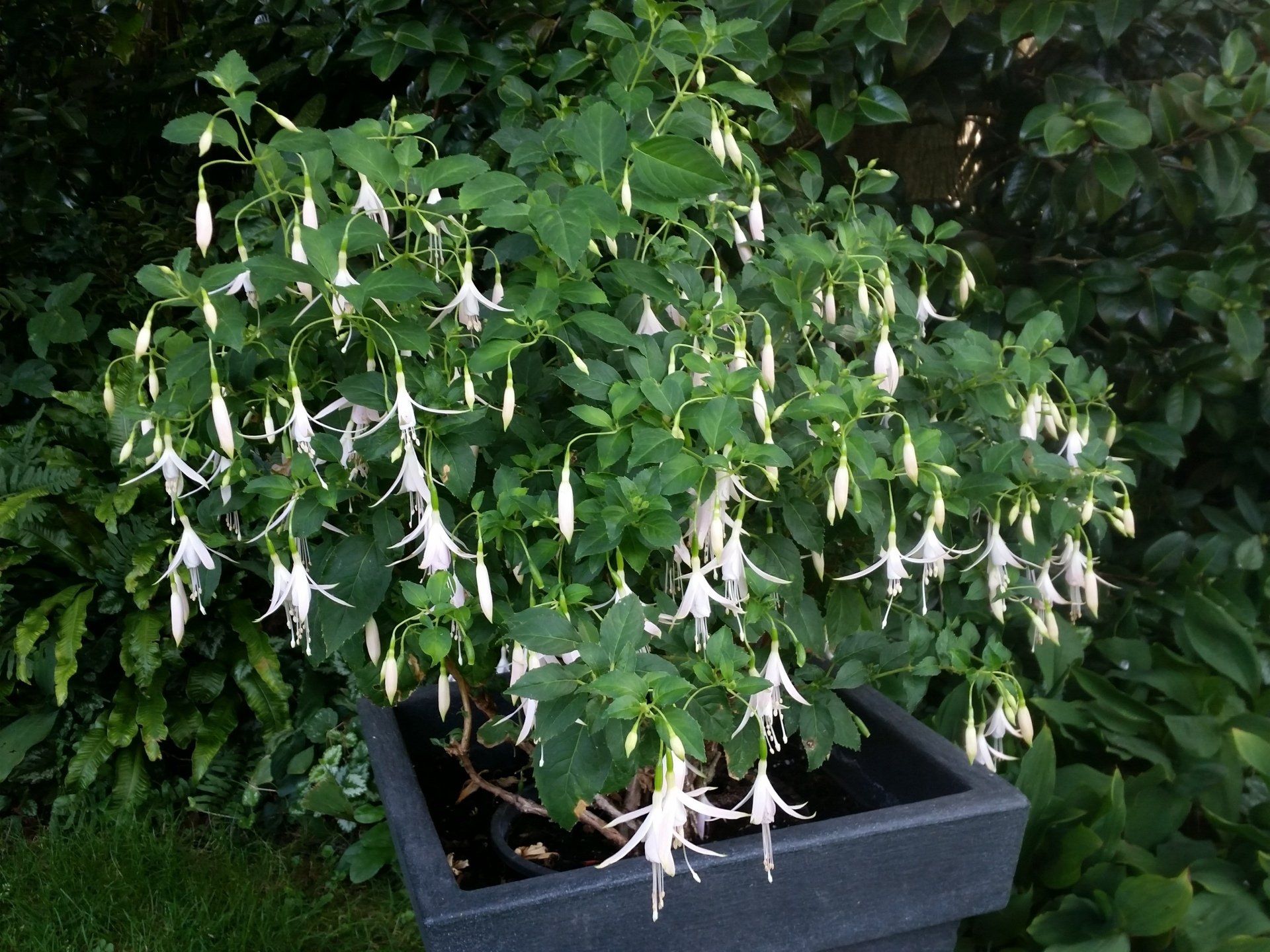
Double Glow
Fuchsia ‘Double Glow’ (De Cooker, 2018) is a tetraploid F. fulgens var. miniata . Its background is described in The Fuchsia Breeders Initiative, Issue 7, July 2016, p. 17.
The name of this cultivar speaks for itself. ‘Double’ is based on the four sets of chromosomes (2n = 44), which is twice the number of chromosomes of the diploid species. ‘Glow’ has been derived from fulgens, which means shiny.
The cultivar has some male and female fertility, but it has so far never been used successfully in Fuchsia hybridization.
Growing this cultivar as a well shaped plant will be difficult. ‘Double Glow’ is more a kind of curiosity than it will ever develop into a nice show plant. Nevertheless, its appearance amidst other fuchsias can be impressive because of the long shiny tube of the blooms, up to about 10 cm. At high temperatures and in full sun the tube gets a little shorter and will develop a pale orange hue.
Flowers appearing early in the season will not be at their best. Normally, best blooms having long tubes and a real double corolla are obtained at higher temperatures later in the season. Frequently, several blooms have five sepals.
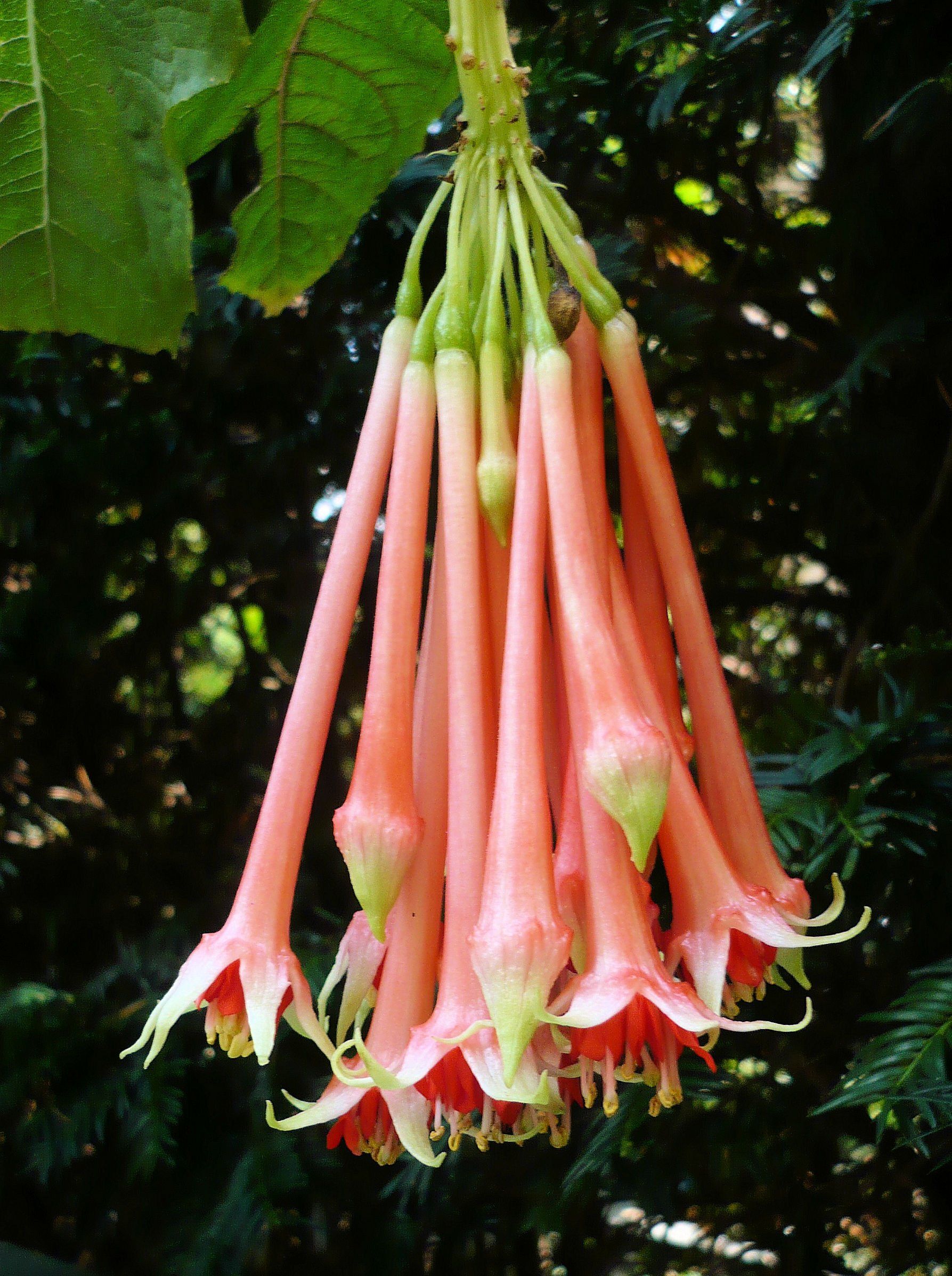
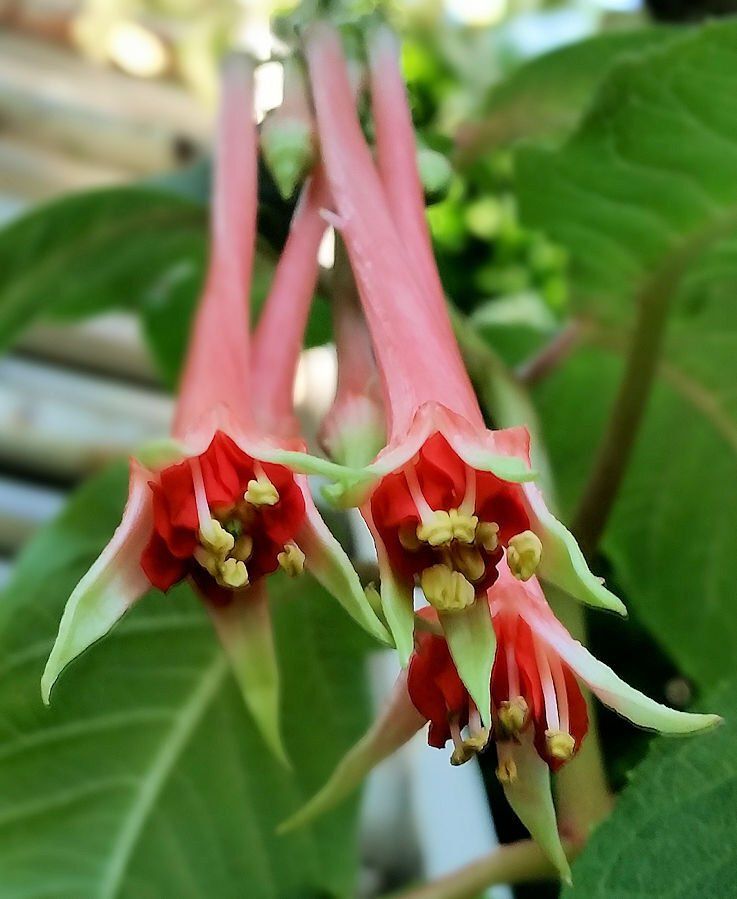
Fancy Dress
Bicolour triphylla Fuchsia ‘Fancy Dress’ (De Cooker, 2020) originates from the crossing ‘Pangea’ x ‘Purcellian Grace’.
It can be grown as a bush or relatively small standard. The bicolour blooms have a bright orange tube and pale pink corolla. The clear stripe on the corolla adds to its attractiveness.
Flowers are produced all summer through. It tolerates sun and high temperatures, and even during severe heat waves it had excellent performance. Overwintering in the cold greenhouse does not cause any problems.
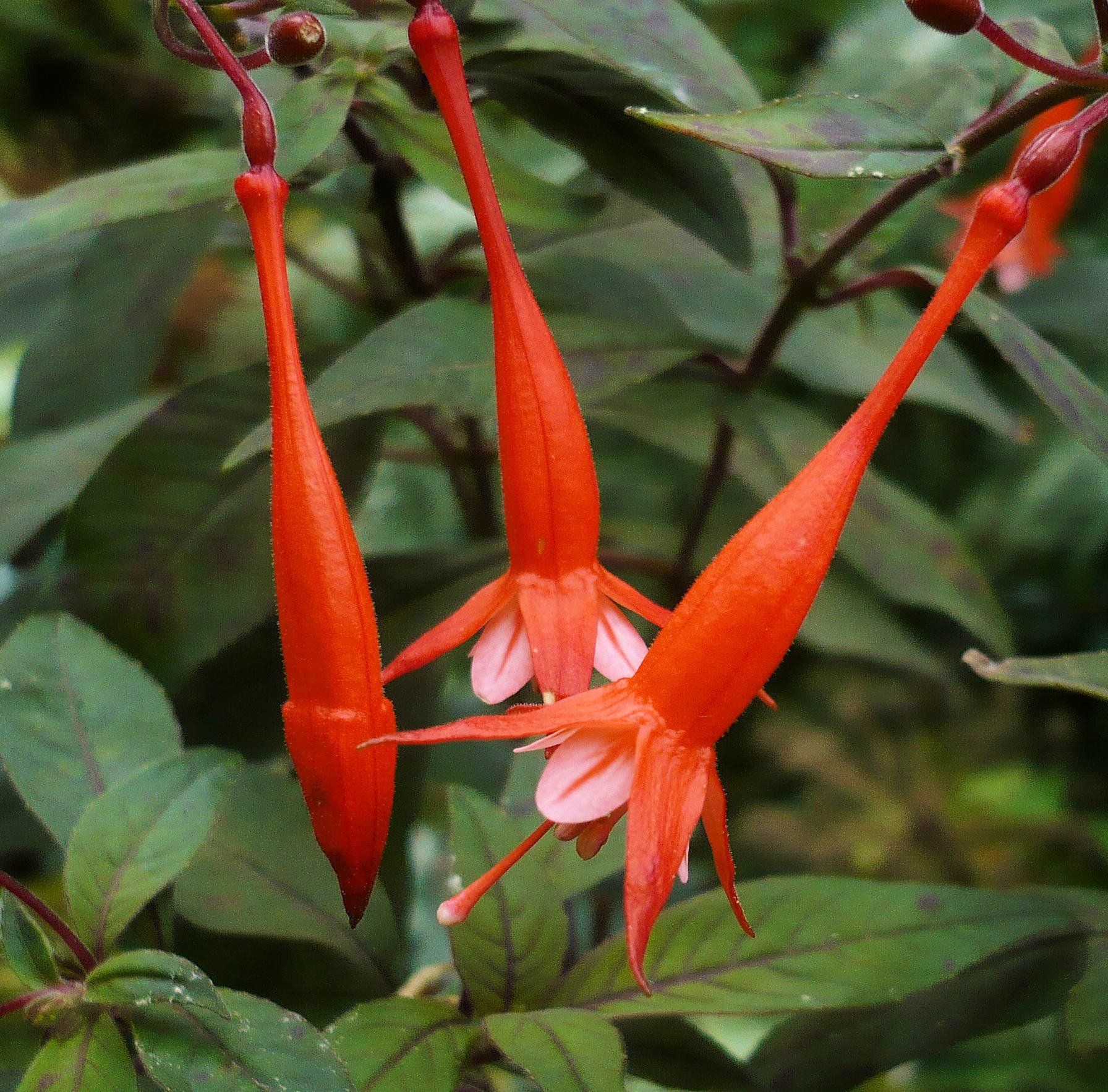
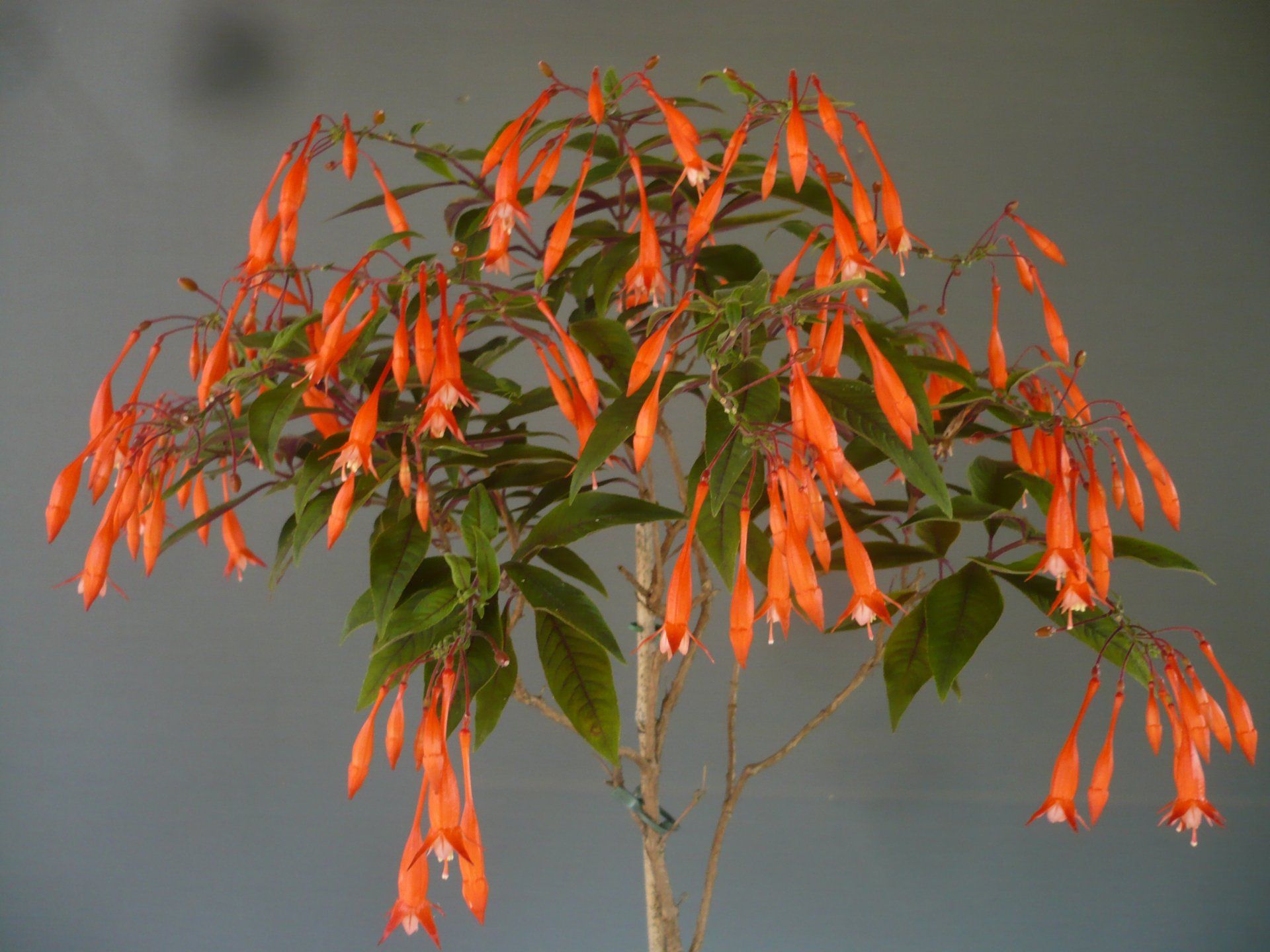
Forever Blue
Fuchsia 'Forever Blue' (De Cooker, 1993) originates from the crossing 'Elisabeth Honorine' x 'Wilson's Pearls'. The cultivar is a rather late flowering, semi- trailing fuchsia.
It doesn't really feel blue, but the name refers to the colour that lasts for a fairly long time.
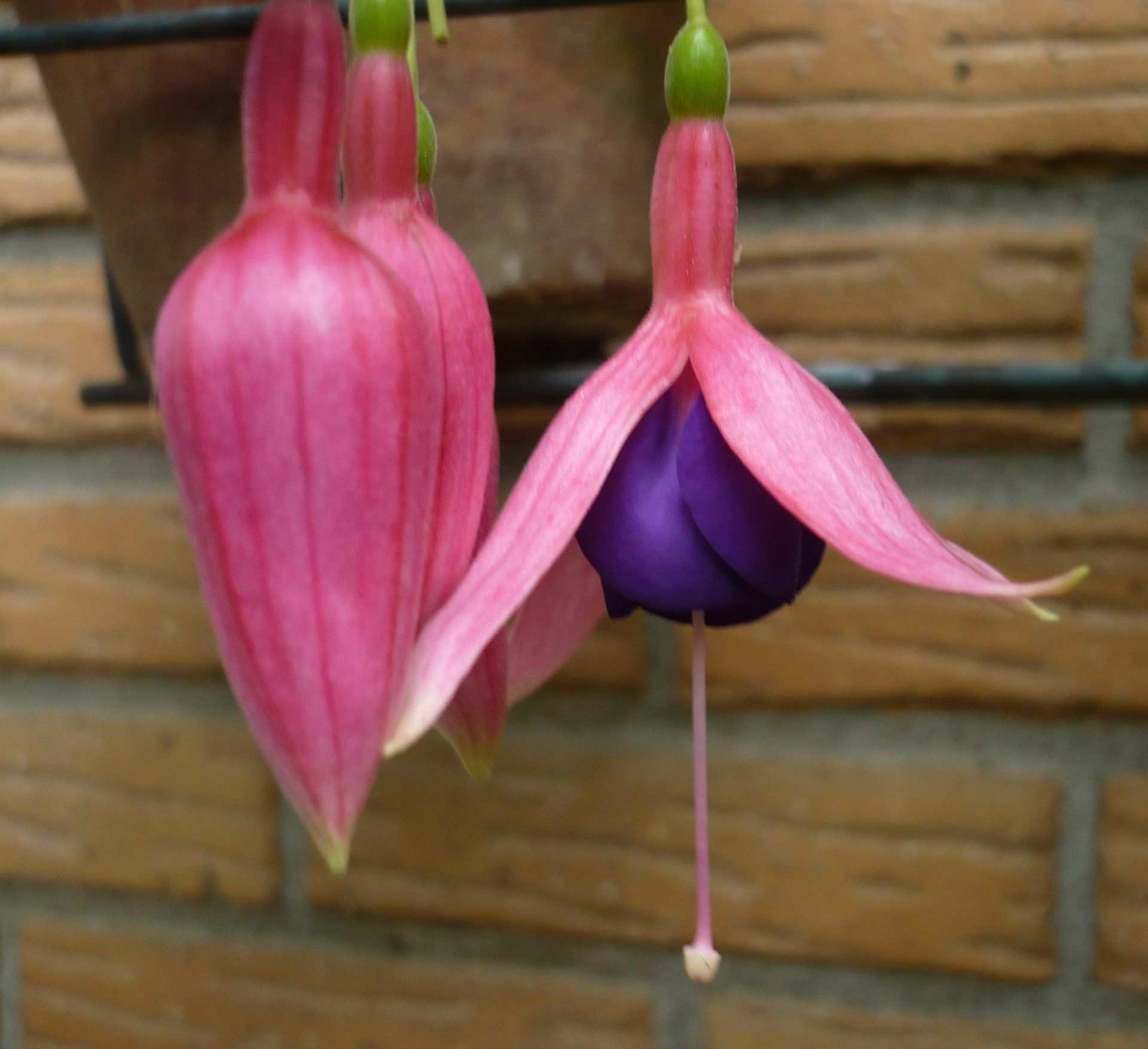
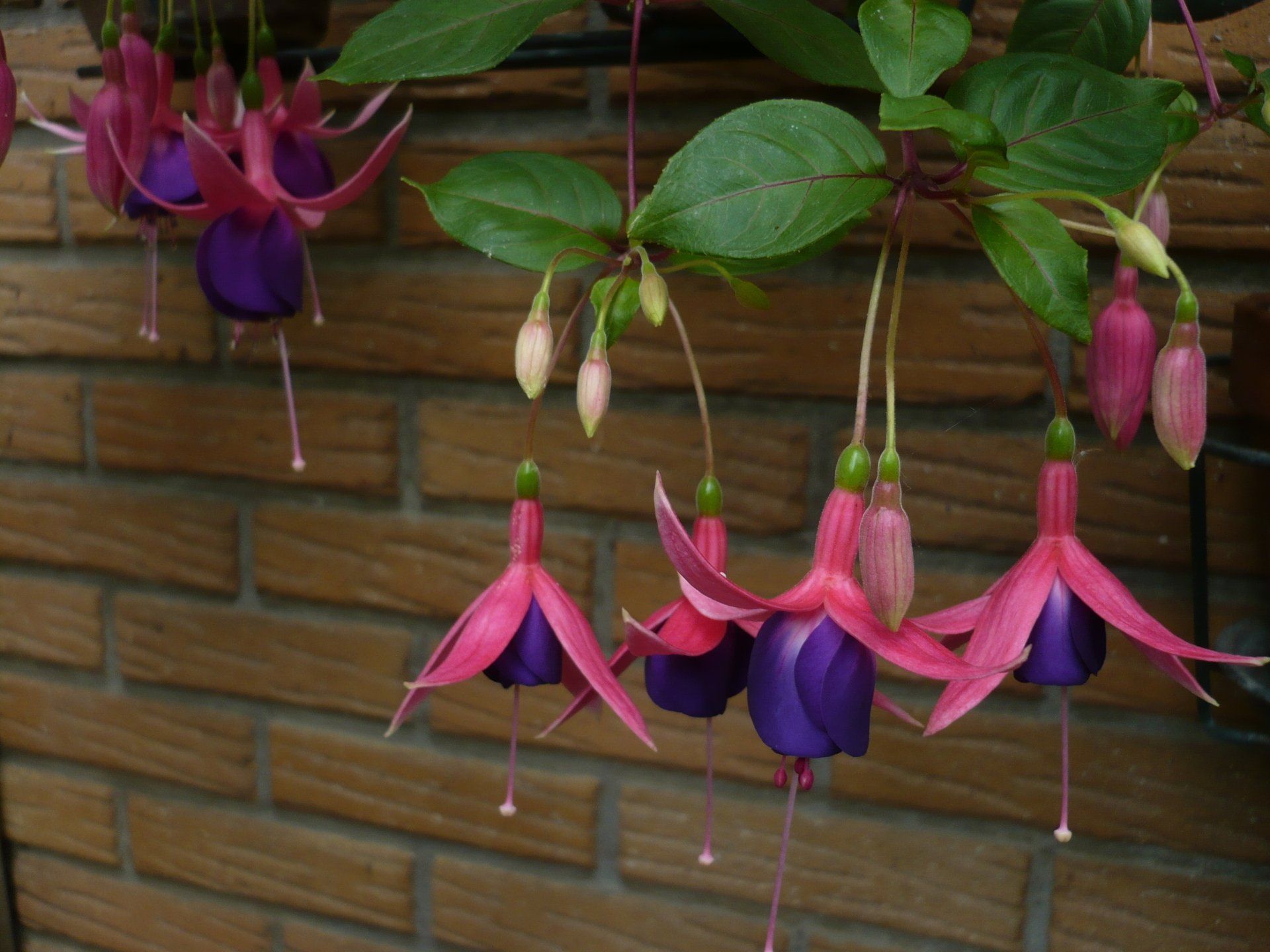
Frozen Tears
Fuchsia 'Frozen Tears' (De Cooker, 1992) originates from the crossing 'Checkerboard' x 'Wilson's Pearls'. The cultivar is a real trailing fuchsia, making branches up to 1 meter.
'Frozen Tears' is very floriferous and self-branching, which makes pinching not really necessary.
In the early nineties of last century I have used 'Checkerboard' frequently as a crossing partner. It had excellent fertility as the female parent, and made berries the size of a small plum. In later years follow-up crosses were much less successful for reasons that are still unclear.
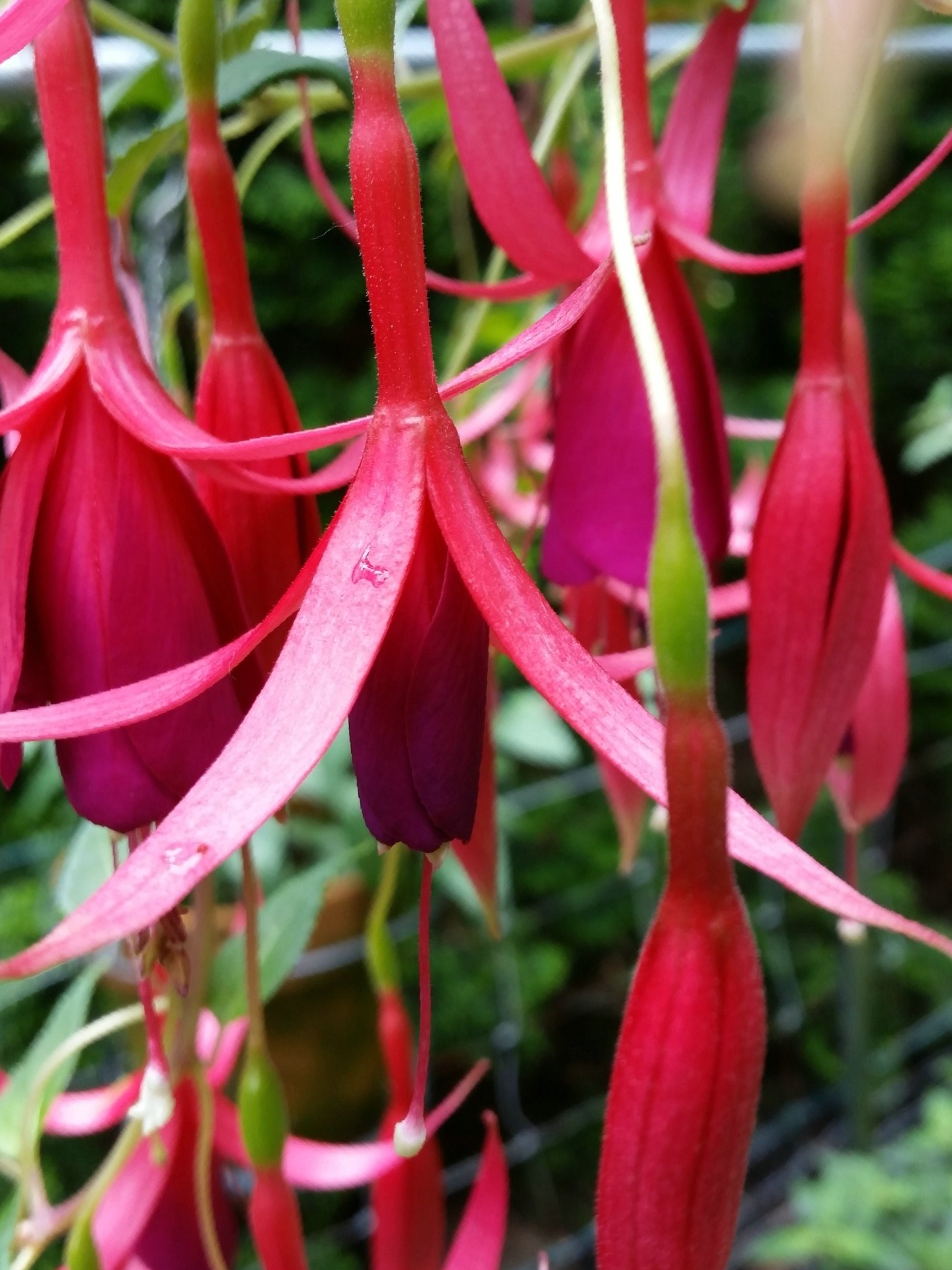
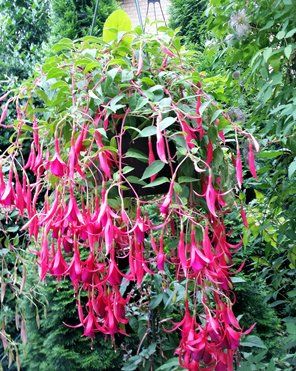
Hail Bright Cecilia
Fuchsia 'Hail Bright Cecilia' (De Cooker, 2023) originates from the crossing ‘Strike The Viol’ x F. triphylla ‘PB7760#7’. As such, this Fuchsia cultivar is part of the ‘Göttingen’ x ‘Our Ted’, i.e., the Purcellian triphylla series. That is why it has been given an appropriate name, befitting Henry Purcell.
‘Hail Bright Cecilia’, also known as ‘Ode to St. Cecilia’, was composed by Henry Purcell to a text by the Irishman Nicholas Brady in 1692 in honour of the feast day of Saint Cecilia, patron saint of musicians.
It can be grown as a relatively small standard or as a bush, from young cuttings or as an older plant. If grown as an older plant and pruned in October it can be overwintered in the cold greenhouse without any problems.
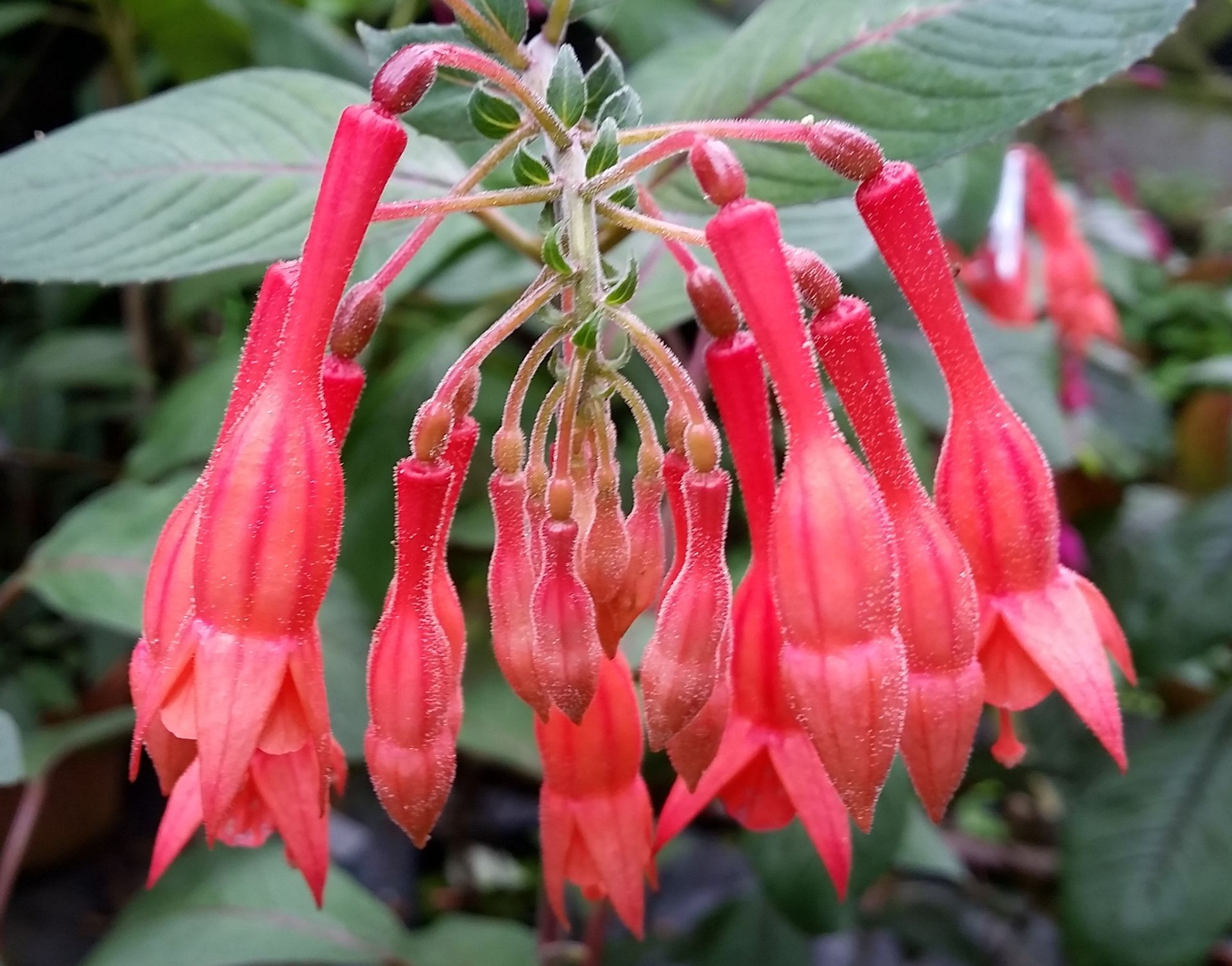

Hard and Crispy
Triphylla Fuchsia ‘Hard And Crispy’ (De Cooker, 2020) originates from the crossing (‘Göttingen’ x ‘Our Ted’) x ((‘Göttingen’ x ‘Our Ted’) x (‘Göttingen’ x ‘Our Ted’)).
This cultivar takes its name from its thick and hard, dark green leaves and crispy flowers. Its rather unusual appearance could be caused by having a hexaploid (and possibly aneuploid?) genome.
Its value is primarily in its attractive foliage which mixes well with other fuchsia types. Flowering is late, often only from September onwards. If left unpinched, also at the end of July/early August flowers will be produced.
Fuchsia ’Hard and Crispy’ is a strong healthy plant which tolerates high temperatures and sun, but prefers to be grown in filtered light during part of the day. It can best be grown as a bush fuchsia, preferably unpinched from autumn cuttings if flowers are required by August.
It can be overwintered in the cold greenhouse without any problems.
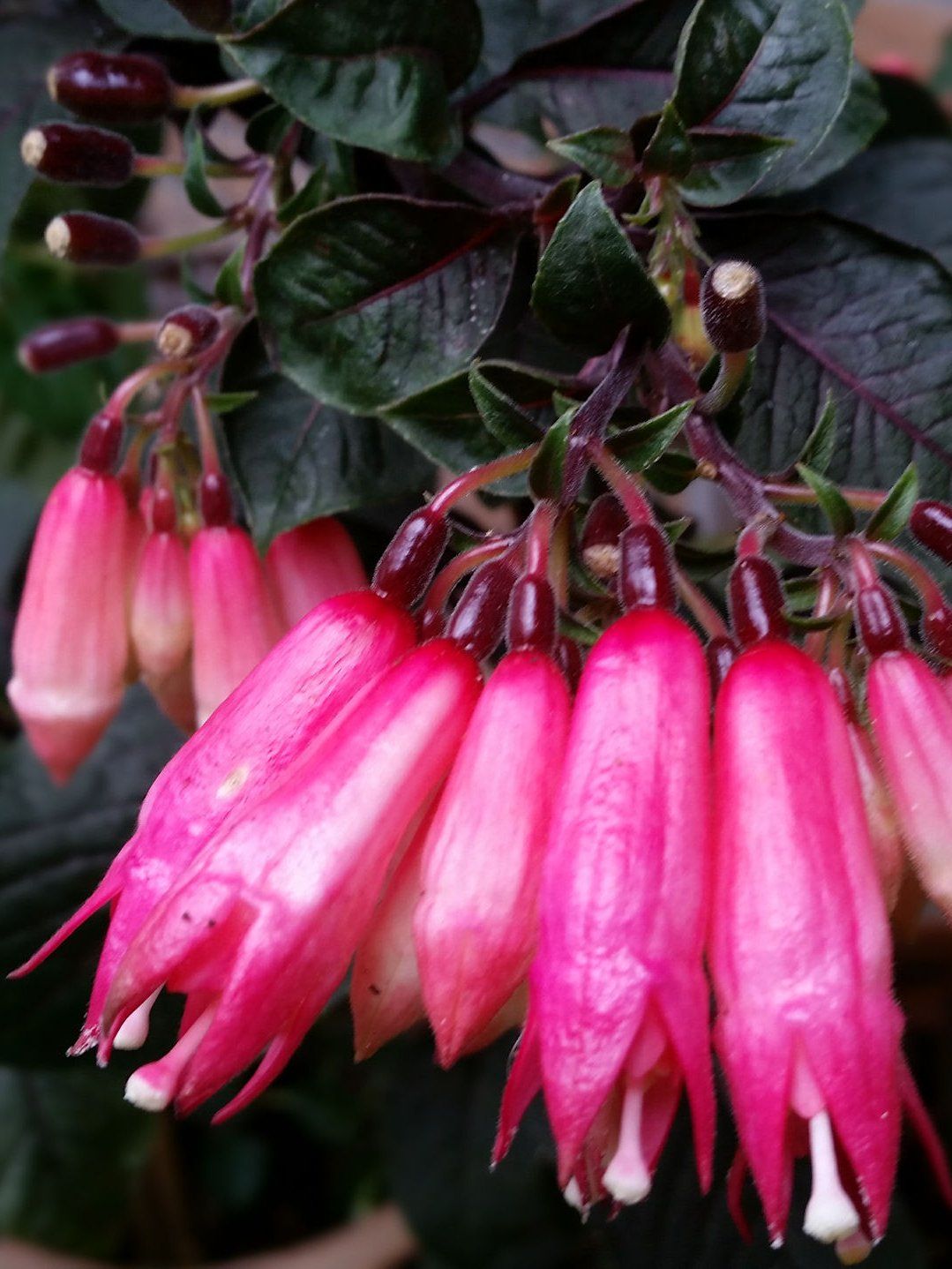
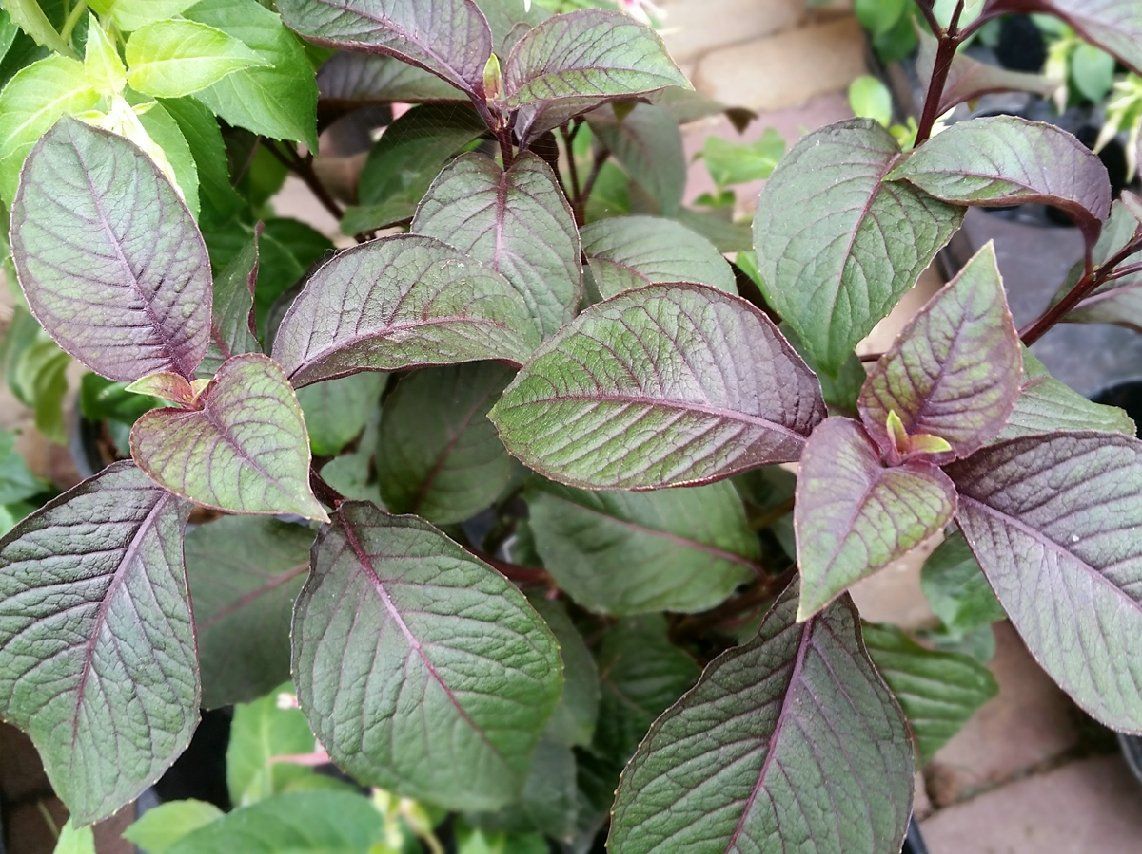
Her Majesty’s Crown
Fuchsia ‘Her Majesty’s Crown’ (De Cooker, 2013) is a triphylla type seedling from 2010, originating from the crossing {(‘Göttingen’ x ’Our Ted’) x Unknown} x tetraploid F. fulgens. From the flower it appears that the tetraploid F. fulgens has a very pronounced influence on the phenotype of the progeny. ‘Her Majesty’s Crown’ is a vigorous grower, with an excellent root system. The flowers are produced in many big racemes. They have a shining bright orange colour, almost luminous in the garden.It can be grown as a bush, a standard or as a semi-trailing fuchsia. It has excellent heat resistance, however at temperatures above 30 oC the foliage could be slightly damaged if exposed to direct sunlight. Overwintering is without any problems. The name ‘Her Majesty’s Crown’ was inspired by the Diamond Jubilee of Queen Elizabeth II of the UK in 2012. Turned upside down, the petals and sepals make a clear crown.
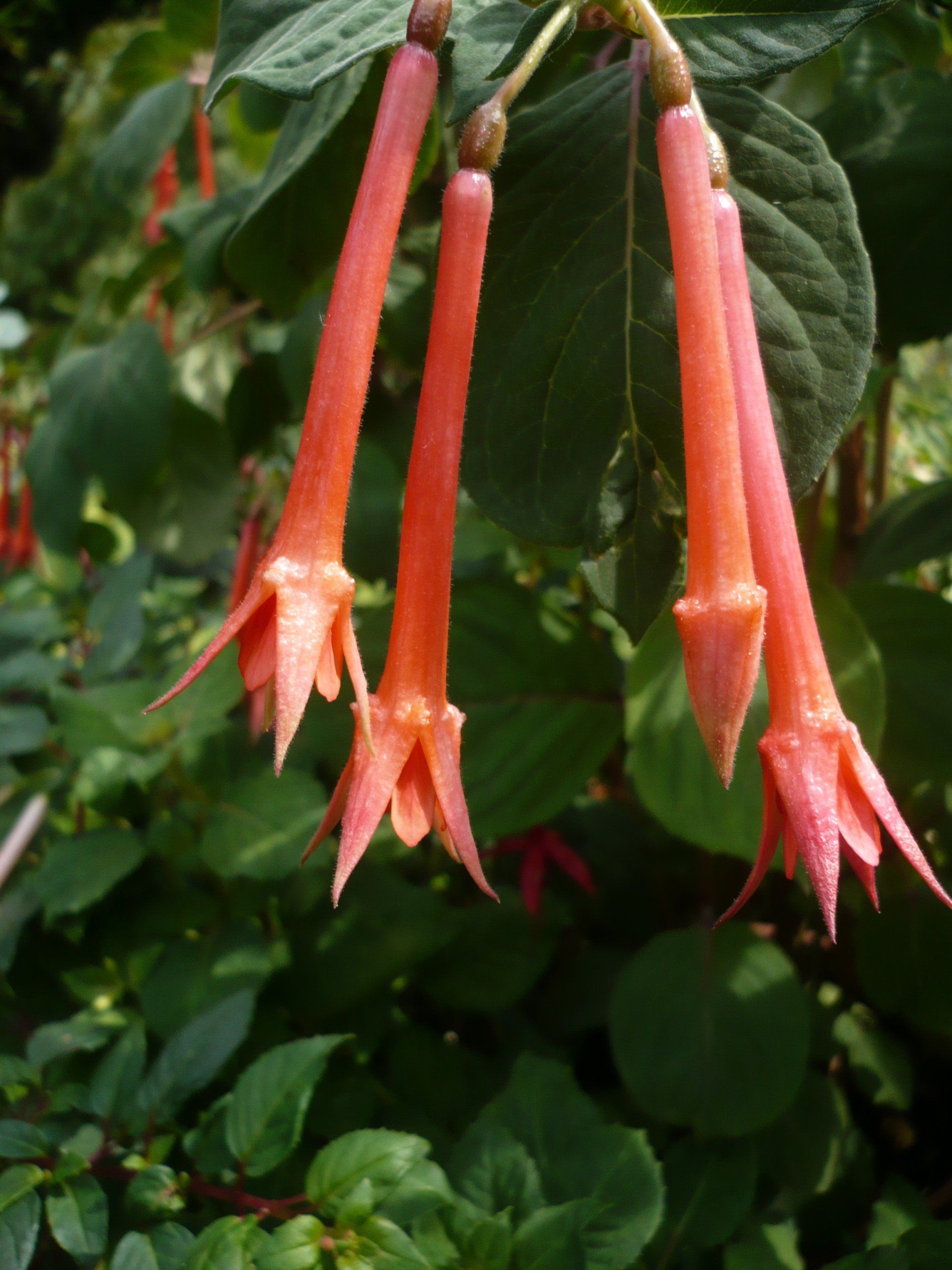
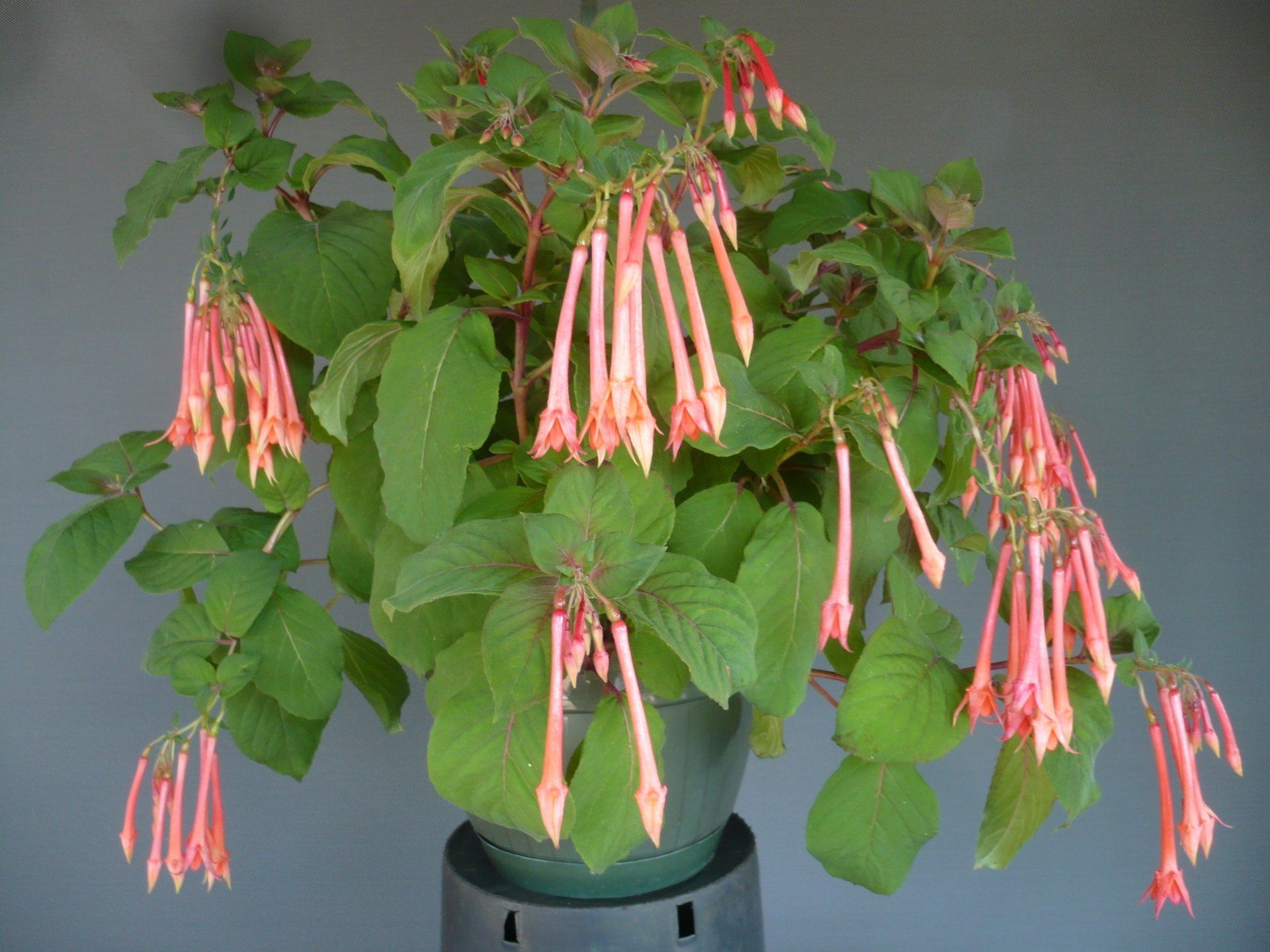
Icicles Chandelier
Fuchsia 'Icicles Chandelier' (De Cooker, 2015) originates from the crossing {[‘Winter Charm’ x (‘Delicate White’ x ‘Stanley Cash’)] x (’Göttingen’ x ‘Our Ted’)} x 'Jaspers Indestructible'.
This cultivar is a self branching, vigorous and floriferous variety. Flowers are produced in large racemes which make a massive display. It is best grown as a semi trailing bush in a somewhat sheltered position in filtered light, although it tolerates high temperatures and some sun. Overwintering is without any problems.
The cultivar’s name: ‘Icicles Chandelier’ reflects the shape and colour of its flowers, hanging down in a chandelier like icicles at the gutter on a bright winter’s day.
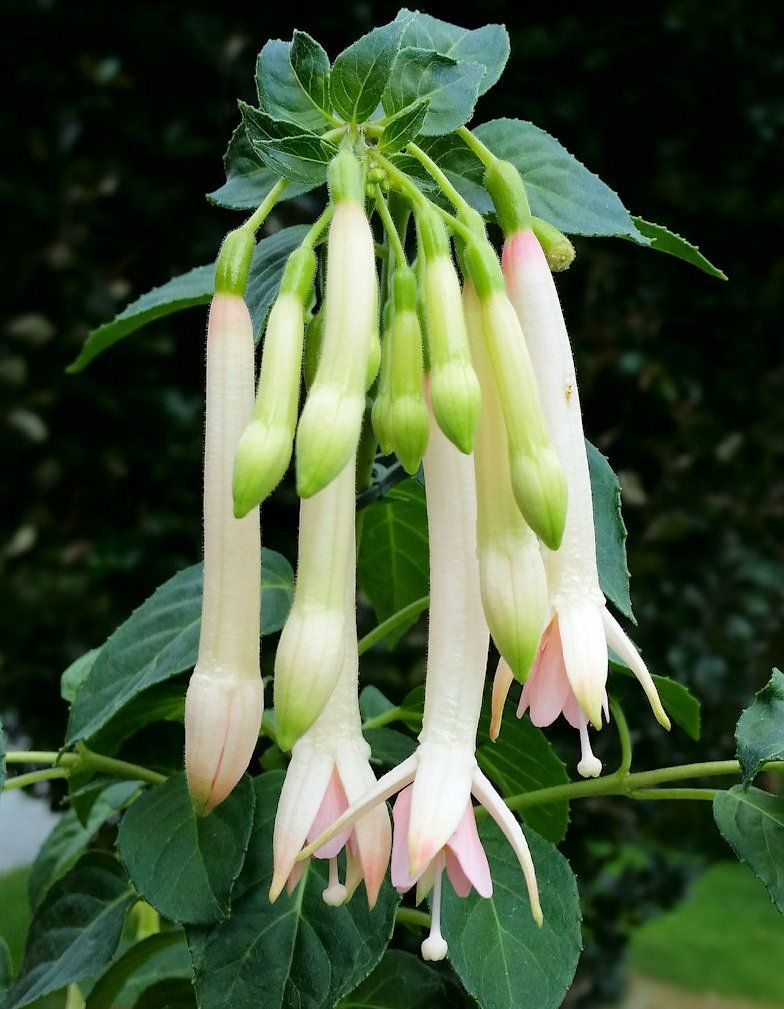
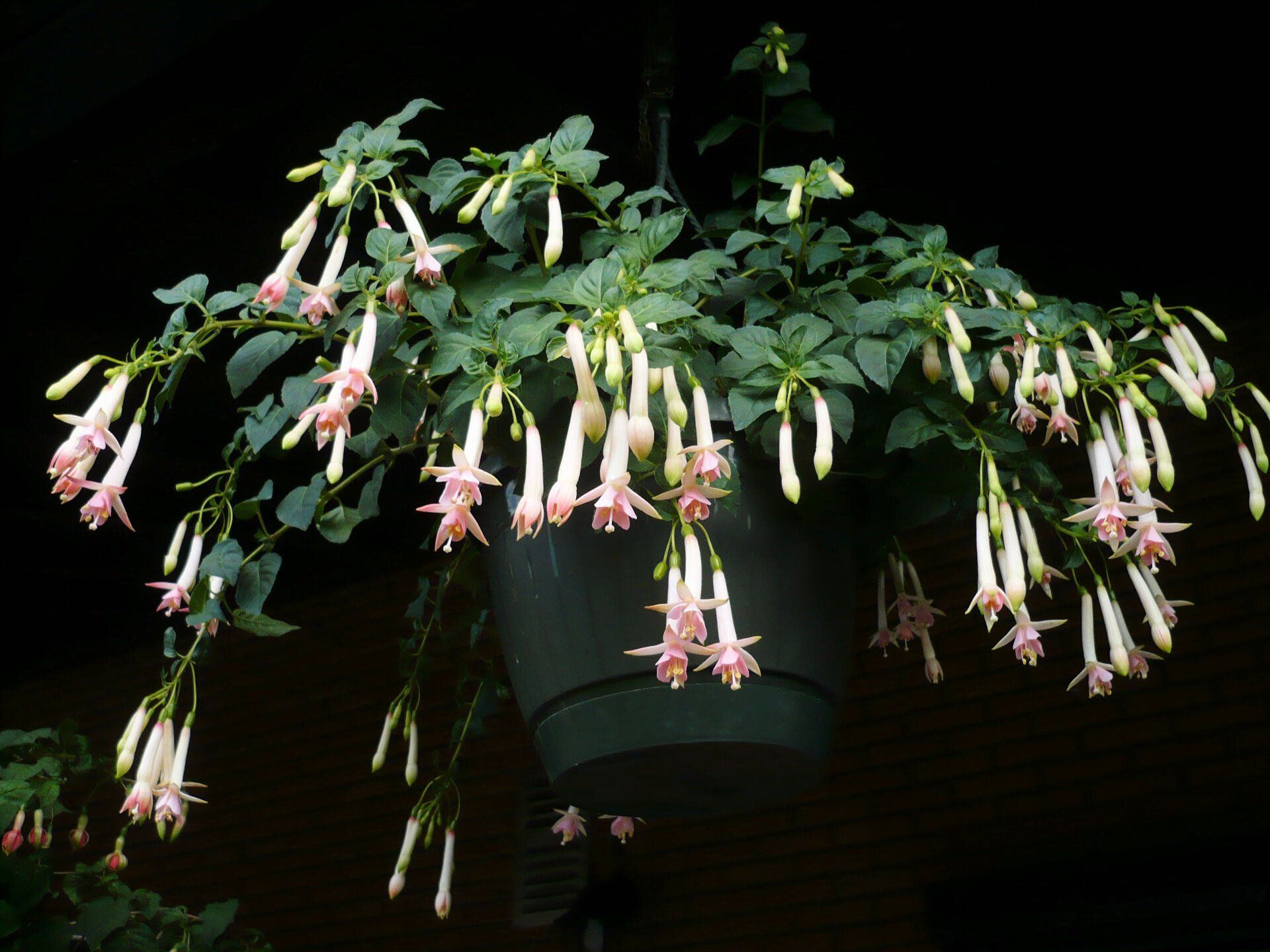
Icy Tears
Fuchsia 'Icy Tears' (De Cooker, 2019) has originated as a sport from Fuchsia ‘Frozen Tears’ in 2016.
Fuchsia ‘Frozen Tears’ itself was introduced in 1993 (AFS registered in 2011). 'Frozen Tears' is a floriferous cultivar with single to semi-double reddish/purple blooms. It makes long (up to 1 meter) trailing branches. ’Icy Tears’ has similar growth properties as ‘Frozen Tears’.
The sport has been tested since 2016 as regards growth and sporting back to the original plant. The latter has indeed happened once.
The plant is easy to grow and overwintering is no problem. It can be grown as an older plant, but best results are obtained when starting from autumn cuttings.
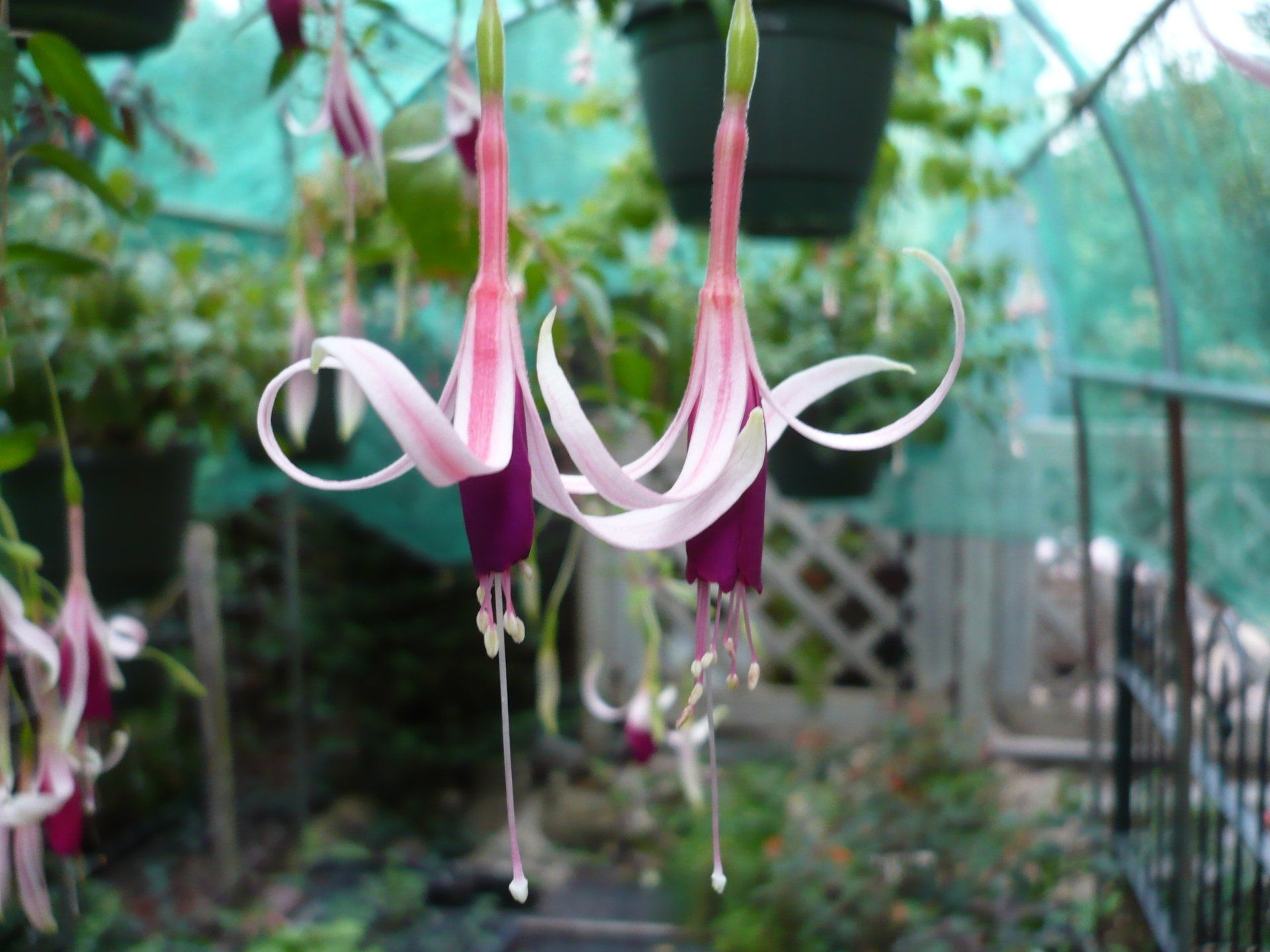
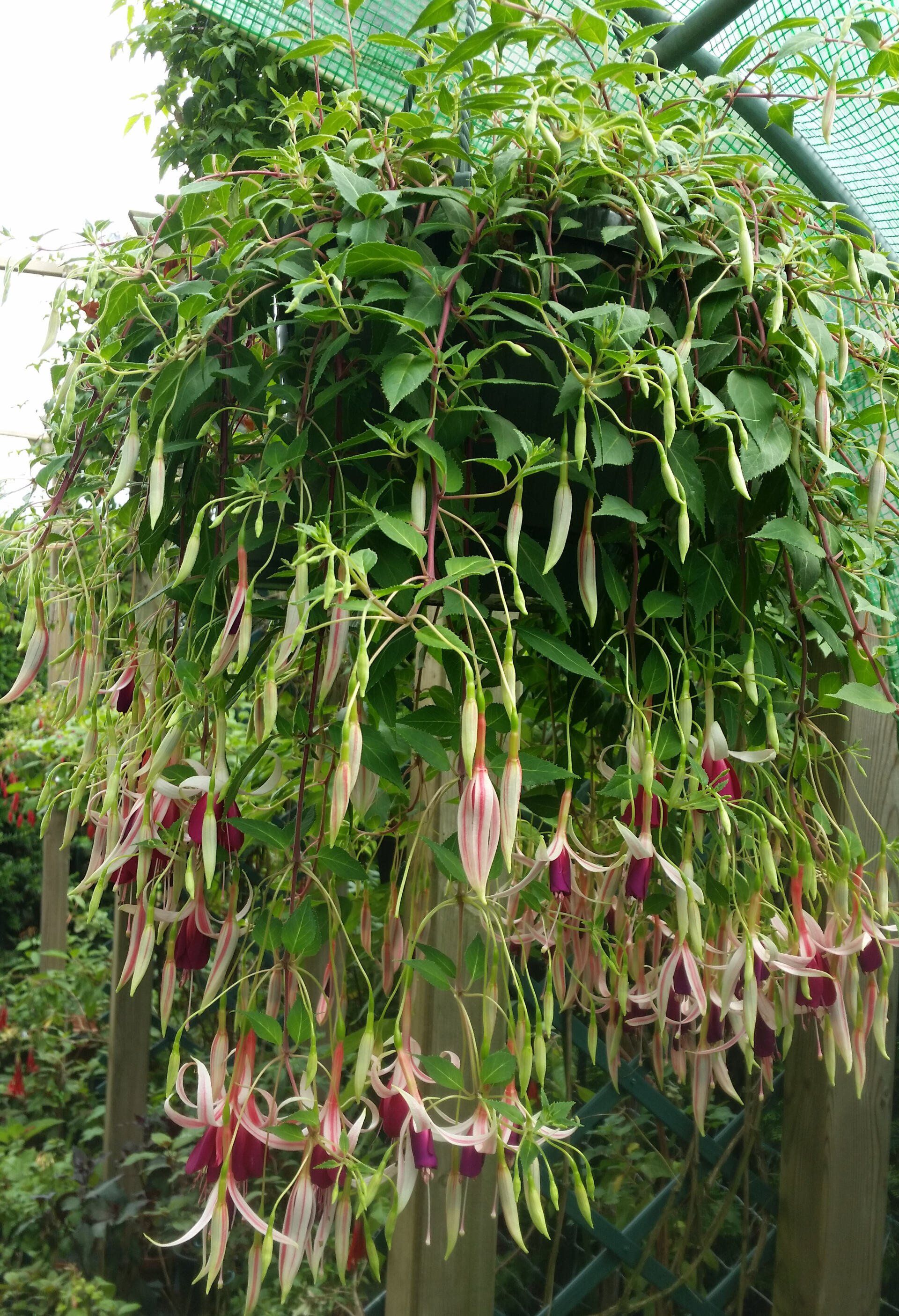
Jac Damen
Fuchsia ‘Jac Damen’ (De Cooker, 2002, AFS 7647) originates from the crossing ’Sparkling Whisper’ x ’Aurora Superba’. This Fuchsia is named after a beloved neighbour and Fuchsia friend: Jac Damen, who had an enormous collection of Fuchsias. This collection was often used in the author’s hybridization work for ‘borrowing’ pollen for making certain specific crossings. Shortly after the introduction of this Fuchsia, Mr. Jac Damen sadly passed away.
‘Jac Damen’ is a vigorously growing, floriferously flowering trailing fuchsia that needs a lot of space. Colour of the flowers is a bright orange. Flowering starts early, and continues until the end of the season. It has an excellent performance as an older plant, three cuttings in a basket. Overwintering does not cause any problems. Pruned is advised at the end of October at 1-5 cm above ground level. Twice or even three times times pinching of the young shoots at the start of the season is an absolute must to obtain a well developed plant.
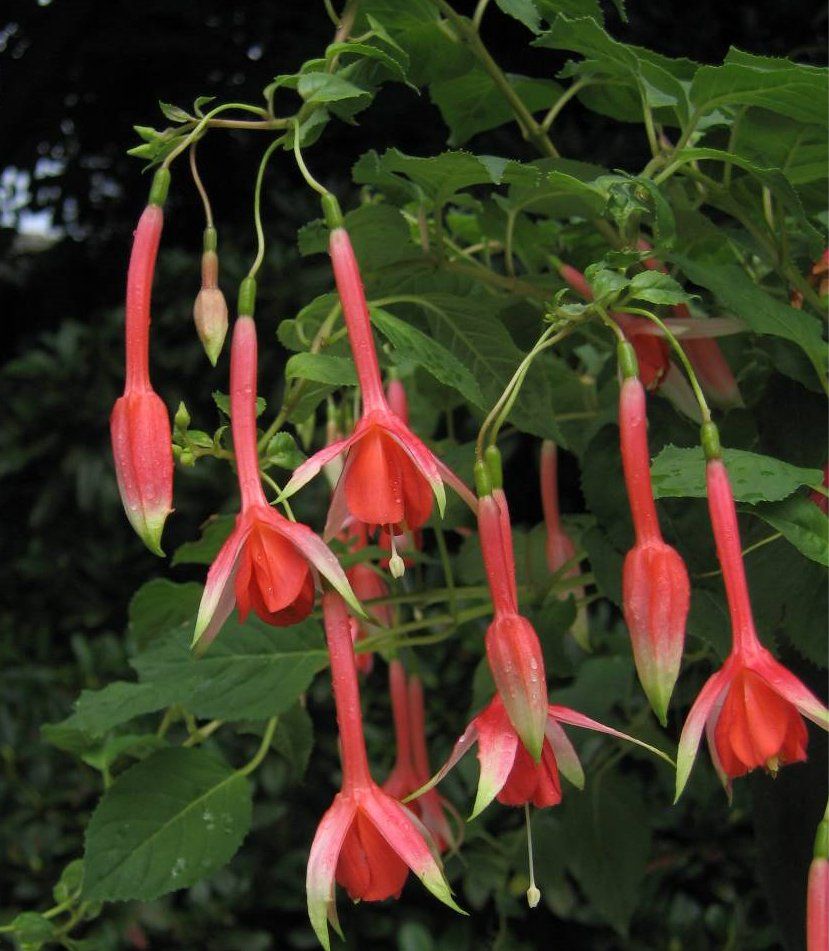
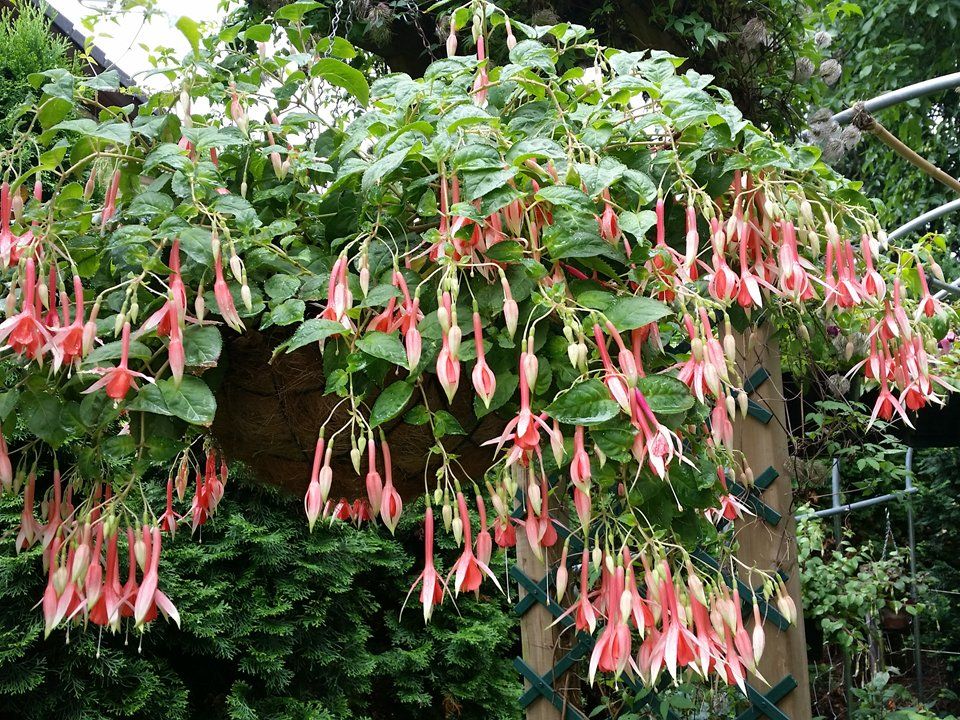
Long Distance
Fuchsia ‘Long Distane’ (De Cooker, 1993) is a floriferous triphylla cultivar.
It originates from the crossing 'Göttingen' x ('Elsie Mitchell' x F. magellanica ‘Alba’).
The name of the cultivar refers to its rather long tube. Given its pedigree it could be expected to have reasonable hardiness, but this has never been tested.

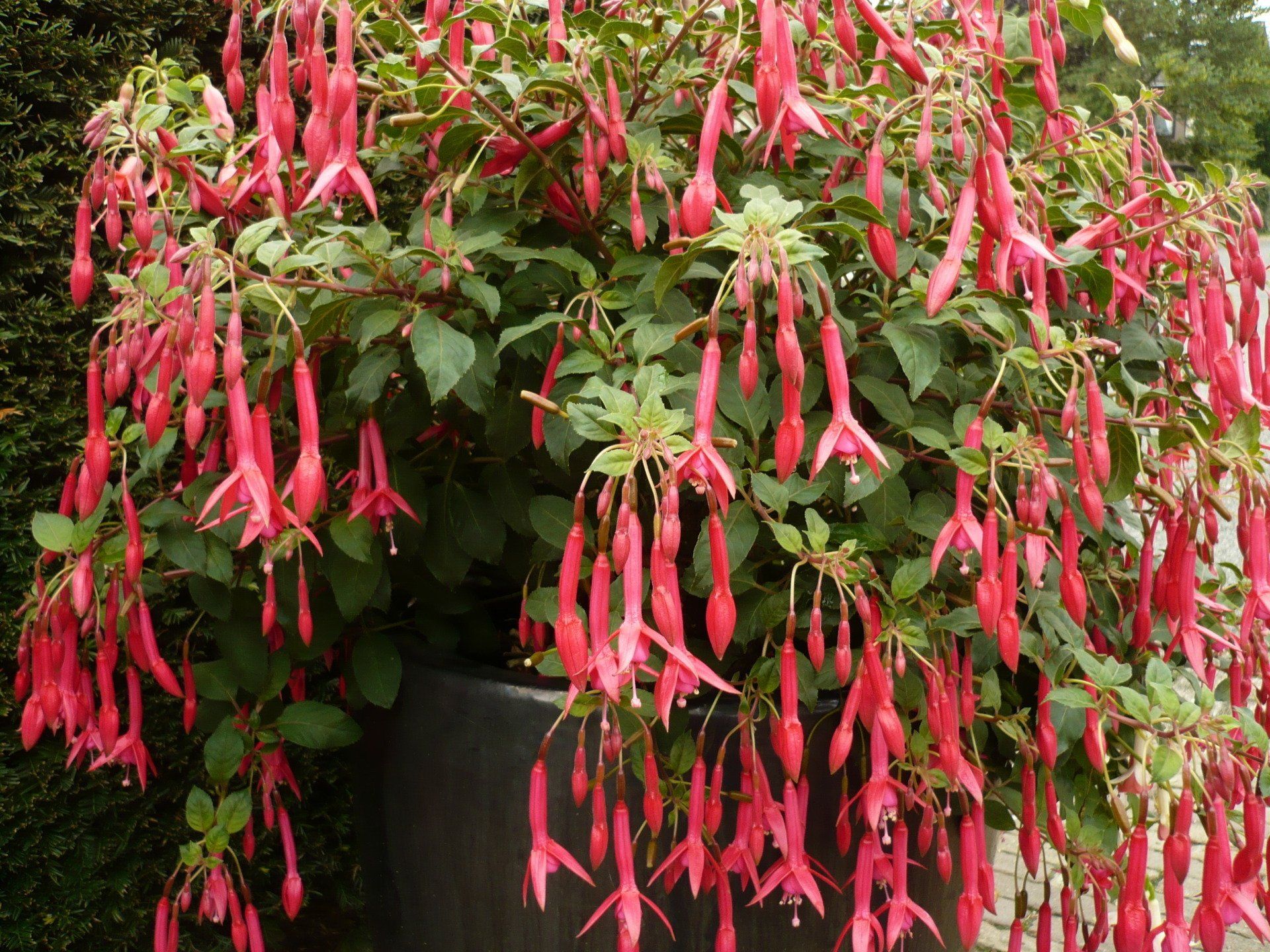
Marble Crepe
Fuchsia ‘Marble Crepe’ (De Cooker, 2014) is a triphylla-type cultivar, originating from the crossing ‘Roger de Cooker’ x tetraploid F. fulgens. Its name is derived from the faint marble-like upper side of the leaves, and the crepe paper-like appearance of the corolla. It ca be grown from young cuttings or as an older plant, semi-trailing or as a bush. 'Marble Crepe' tolerates heat and sun. Overwintering is without any problems. The cultivar produces no pollen, nor seems it to be fertile as the female.
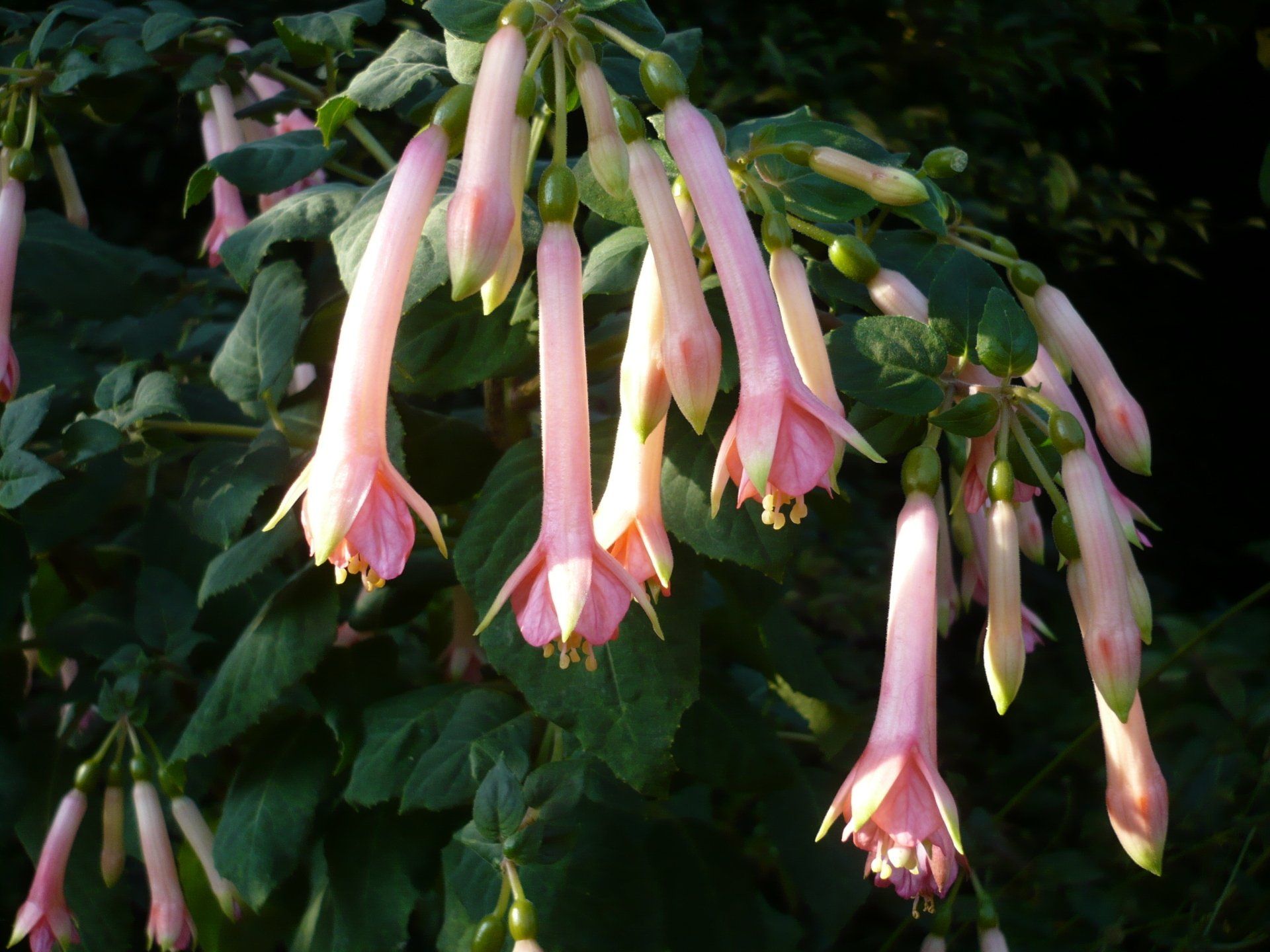
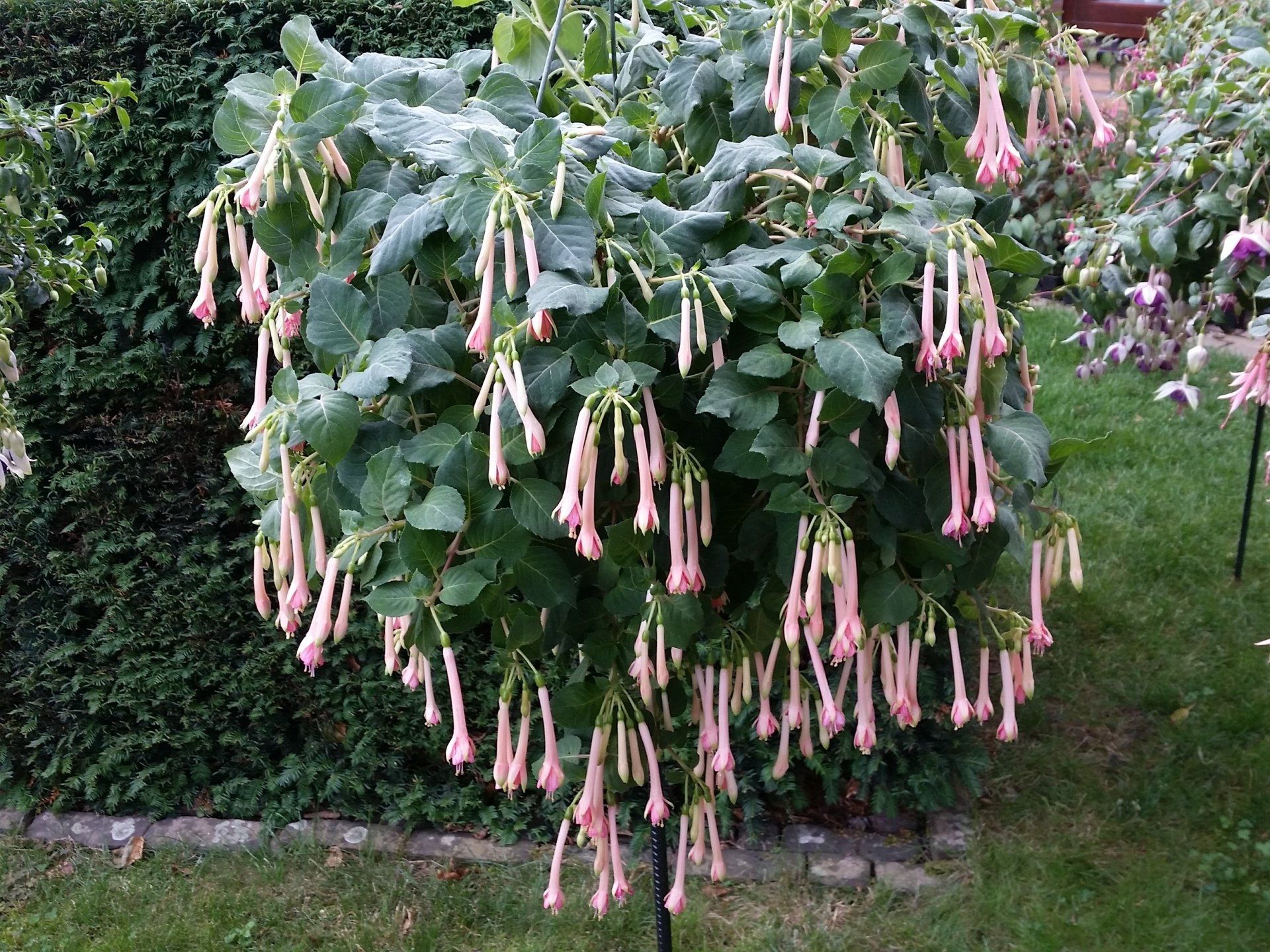
Merry-go-Round
Fuchsia ‘Merry-go-Round’ (De Cooker, 1993) comes from the crossing 'WALZ Tuba' x ('Elsie Mitchell' x
F. magellanica ‘Alba’). It makes an excellent bush or standard, and is an easy fuchsia to grow.
'Merry-go-Round' is probably hardy, but this has not been tested. Overwintering in the cold greenhouse is no problem.

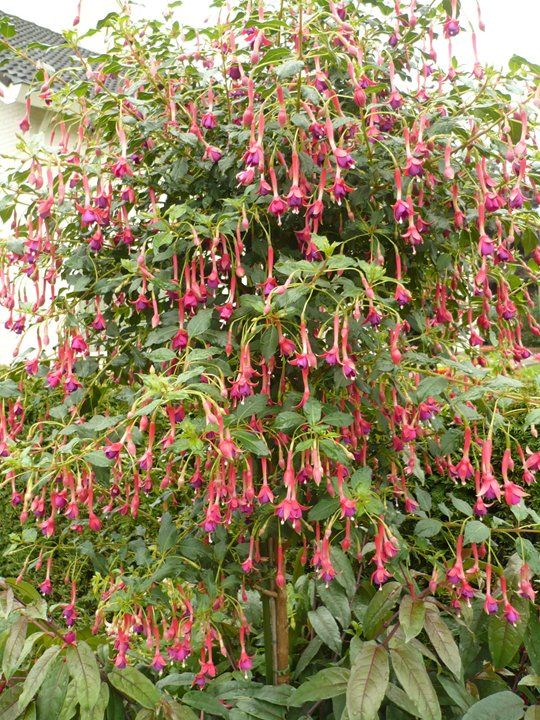
Pavilion Princess
Fuchsia 'Pavilion Princess’ (De Cooker, 2014) is a semi-trailing, very floriferous Fuchsia. Its parentage is [(‘Roger de Cooker’ x (‘Checkerboard’ x ‘Machu Picchu’) x (‘Checkerboard’ x ‘Machu Picchu’)] x ‘Blue Rebel’. Tube and sepals have a white/soft pink colour. The colour of the corolla (which remains virtually closed, also upon ageing) is a subtle mixture if blue, white, pink and gray. It flowers continuously the whole summer through, and from mid August on the plant is literally covered with flowers.
The name of this fuchsia was inspired by the BBC coverage of the Chelsea Flower Show 2014. One of the BBC’s lead presenters in gardening is Carol Klein, who took care of a lot of presentations from the flower displays in the Chelsea’s Great Pavilion. She puts enormous flamboyancy and enthusiasm in her presentation, which makes her one of the most beloved presenters.
One day Carol was announced as "…. our Pavilion Princess...". And what better name could be imagined for this Fuchsia, mimicking Carol with its floriferous flamboyancy.


Petra Pinckaers
Fuchsia 'Petra Pinckaers’ (De Cooker, 2023) originates from the crossing ‘Our Ophelia’ x ‘Spray’. It is easy to grow and flowers profusely throughout the season. It makes its blooms on large terminal racemes.
Fuchsia ‘Petra Pinckaers’ is named after Mrs. Petra Pinckaers, a valued member of our local Fuchsia Society ’Limburgs Belleke’. Petra is our dedicated “Purveyor” with her delicious waffles, cakes and pies on our Society meetings.
The female parent ‘Our Ophelia’ is a semi-trailing triphylla cultivar. The male crossing parent ‘Spray’ was introduced by the late Fuchsia hybridist Jan de Boer in 2017. Attractive genetic trait of ‘Spray’ is the ability of producing multi-flowering progeny.
‘Petra Pinckaers’ can be grown from young cuttings, several cuttings in a basket. If grown as an older plant and pruned in October it can be overwintered in the cold greenhouse without any problems.
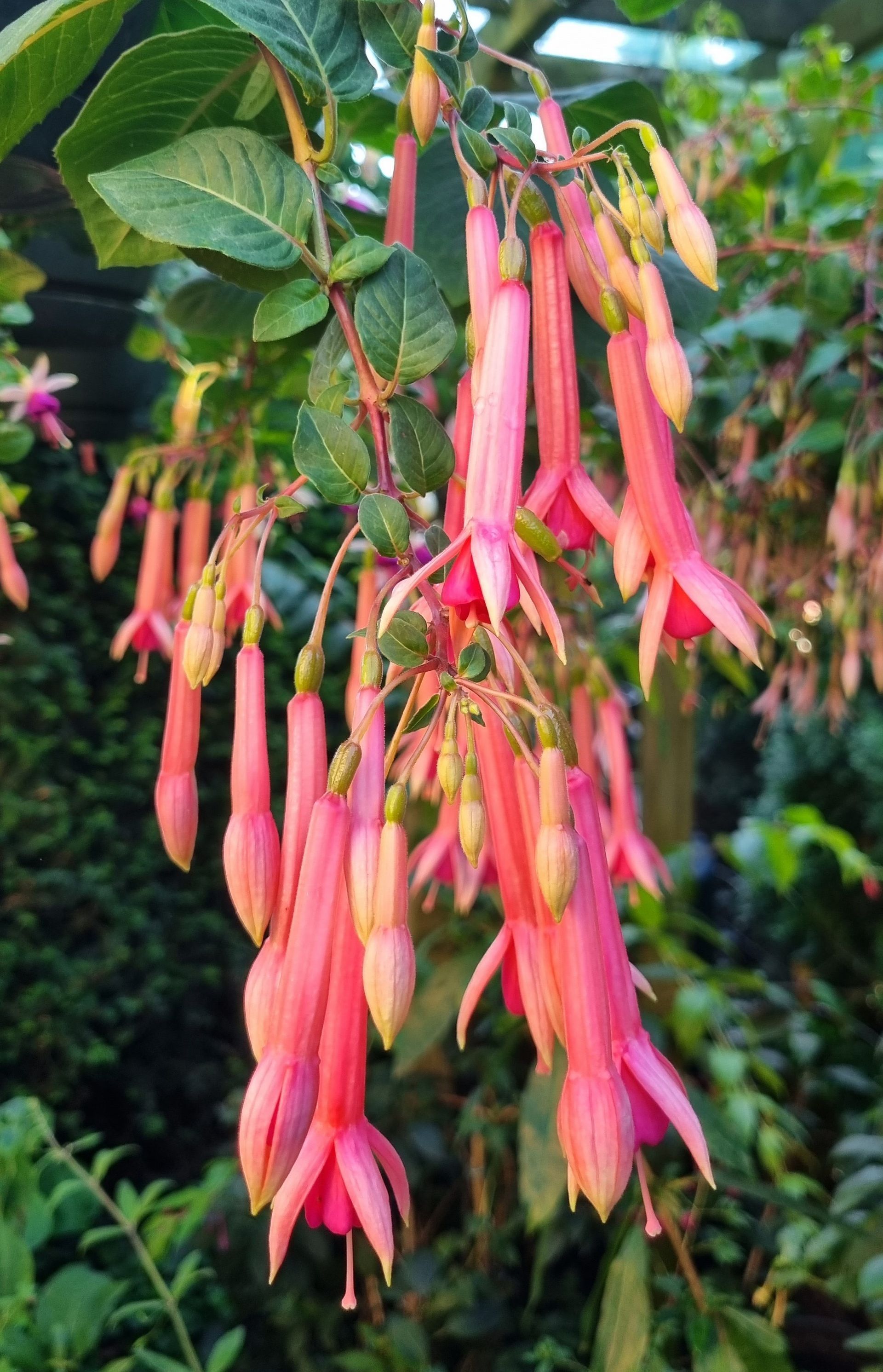
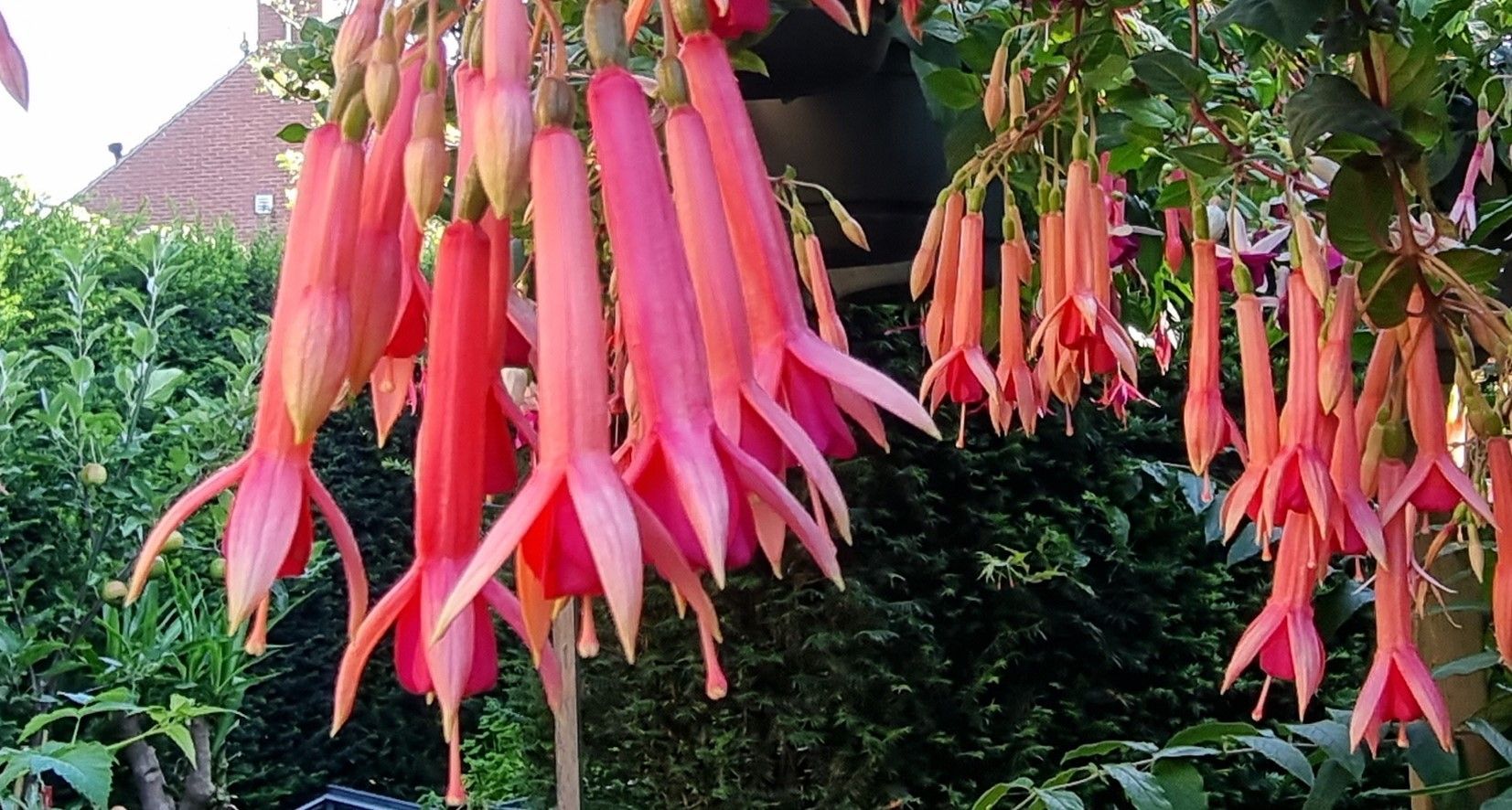
Purple Charm
Fuchsia ‘Purple Charm’ is a triphylla fuchsia cultivar originating from a crossing between two non-introduced seedlings:
N 16-20 x N 11-05.
N 16-20 = ‘Daryn John Woods’ x ‘Purcellian Elegancy’;
N 11-05 = ((F. x colensoi x F. magdalenae) x ‘Delicate White’) x ‘Grasmere’.
‘Purple Charm’ is one of the first of a series of new purple triphyllas originating from seedling N 16-20, which is a hexaploid plant that produces 100% purple triphylla offspring. Several more of such purple triphyllas, having different flower shapes and growth properties, will follow in the coming years.
‘Purple Charm’ has semi-trailing growth properties and excellent high temperature and sun tolerance. Overwintering in the cold greenhouse is without any problems.
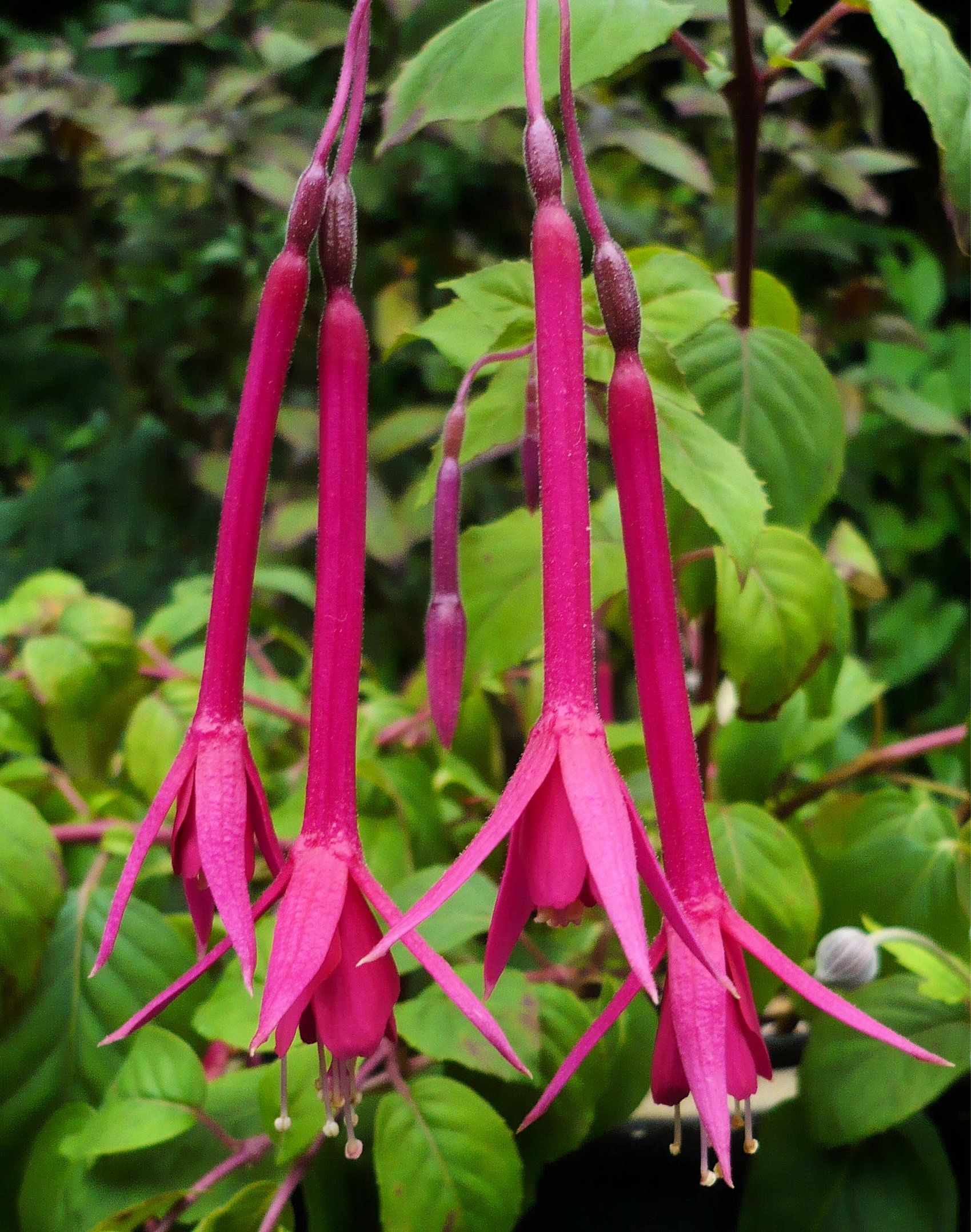
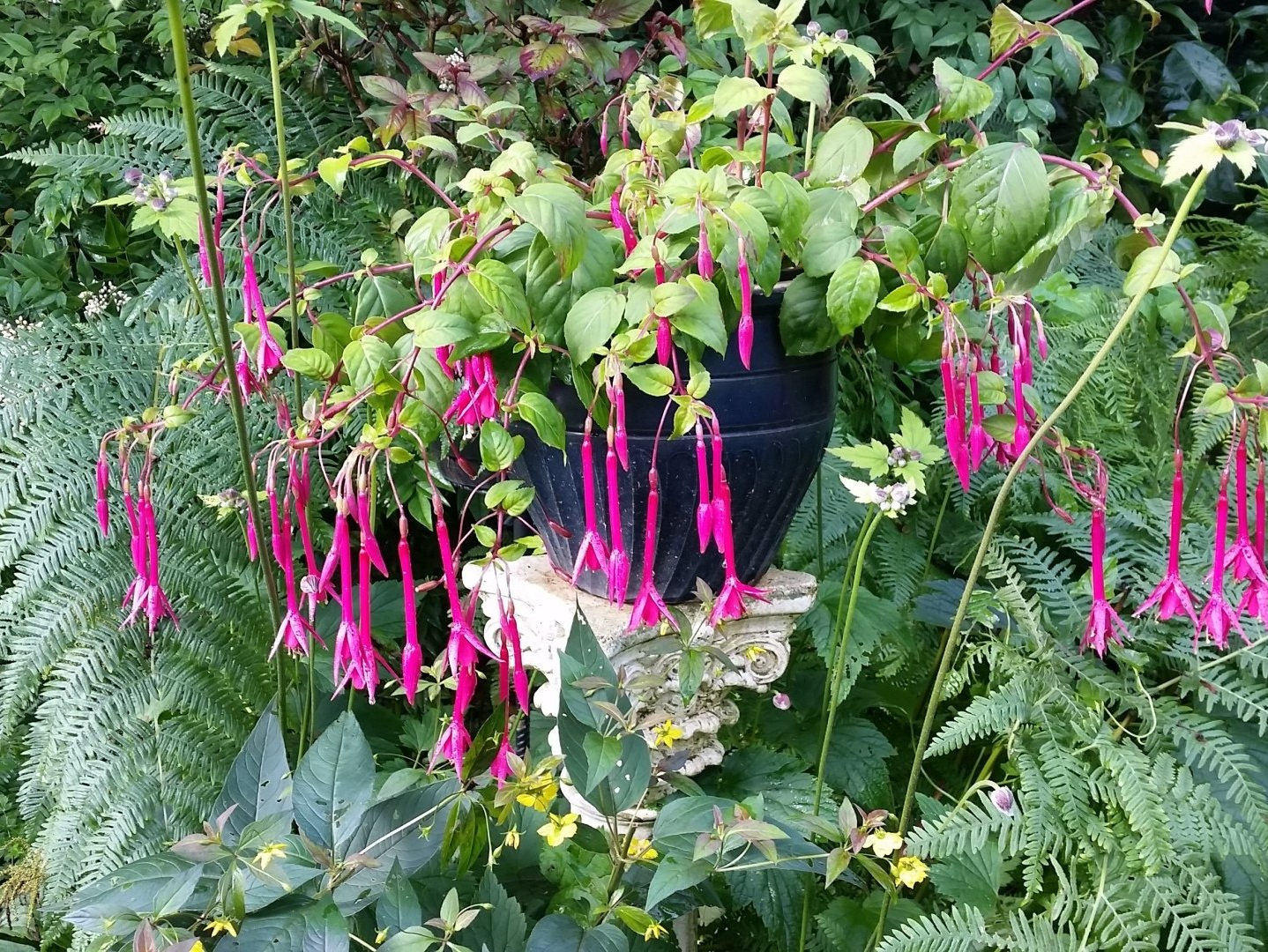
Purple Nettle
Fuchsia ‘Purple Nettle’ (De Cooker, 2020) is a triphylla cultivar with a long red tube and an orange corolla. From the crossing in 2010 ‘Strike The Viol’ x F. splendens (as part of the ‘Göttingen’ x ‘Our Ted’ series) the cultivar ‘Wake The Harp’ has been obtained.The followup crossing ‘Wake The Harp’ x seedling N 05-31 (= (‘Göttingen’ x ‘Our Ted’) x (‘Göttingen’ x ‘Our Ted’)) has produced seedling N 11-34 = 'Purple Nettle' in 2011. This seedling has attractive, nettle-like foliage, exhibiting a dark purple colour at the upper side of the leaves during a large part of the summer season. The colour of the (slightly twisted) tube has been inherited from F. splendens and contrasts beautifully with the purple foliage.
At the extreme temperature conditions of the 2019 summer season it had excellent performance, even if grown at a sunny spot during part of the day.
It can best be grown as a bush fuchsia, preferably at least 3 cuttings in a pot. Overwintering in the cold greenhouse does not cause any problems.
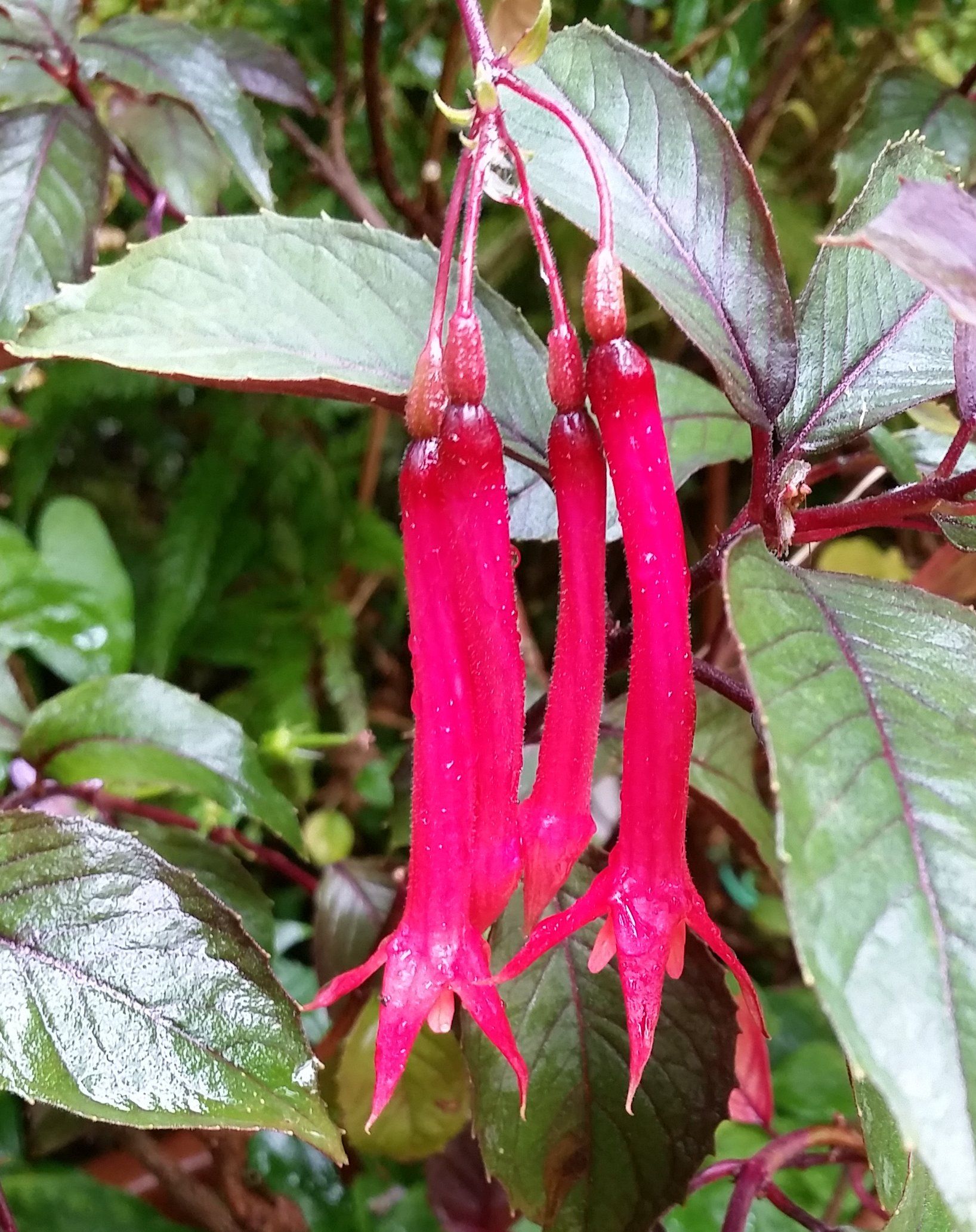
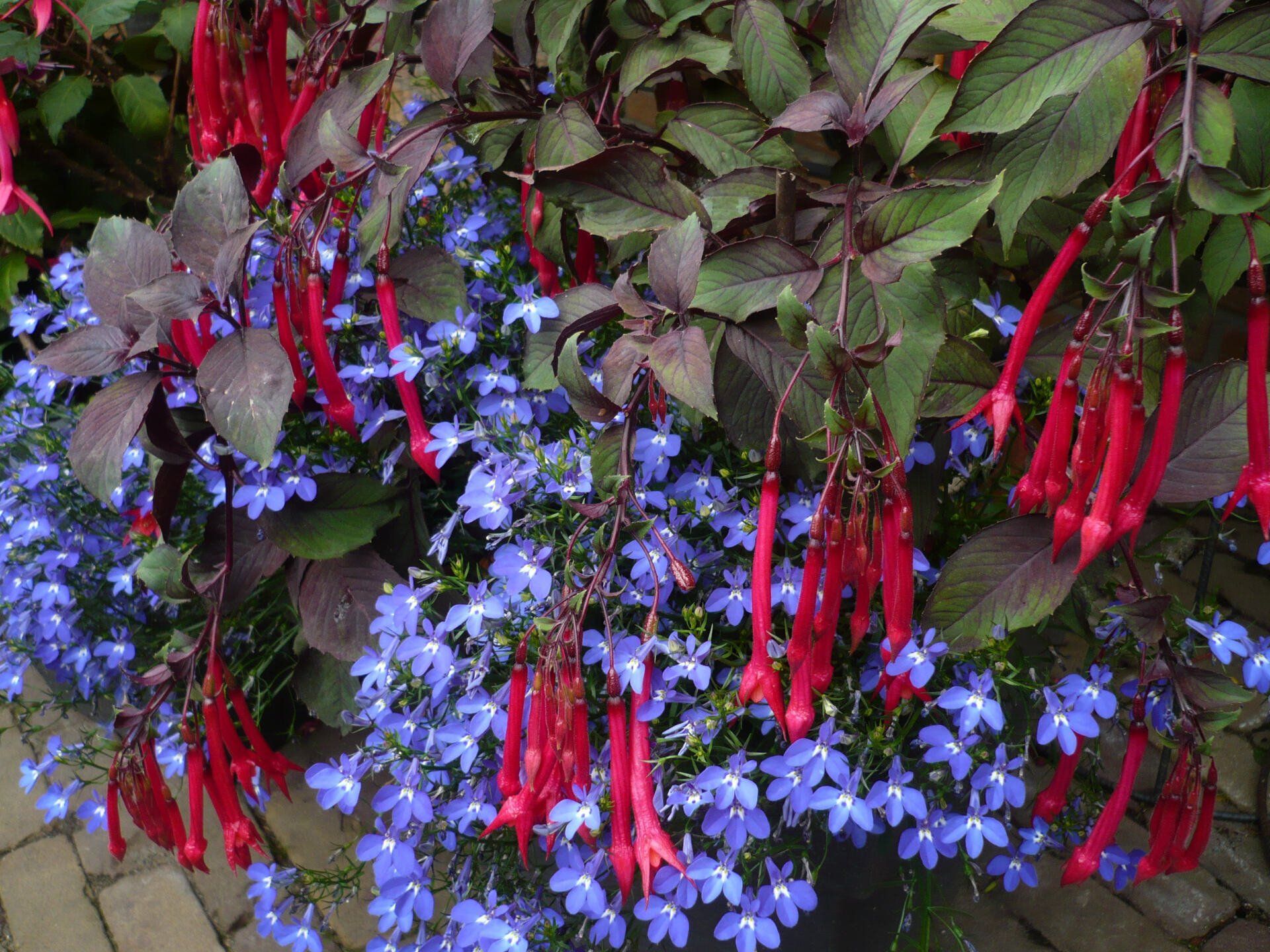
Remembering Claire
Fuchsia ‘Remembering Claire’ (De Cooker, 2008) originates from the crossing {[(F. juntasensis x F. inflata) x F. magdalenae] x [('Checkerboard' x 'Machu Picchu') x ('Checkerboard' x' Machu Picchu')]} x 'Wilson’s Pearls. It's a trailing fuchsia variety with long, single, deep purple flowers. Best result is obtained if grown in dappled shade, although it also tolerates some sun and high temperatures. Overwintering in the cold greenhouse is without any problems.
‘Remembering Claire’ is named after a little pig that once was part of the family.
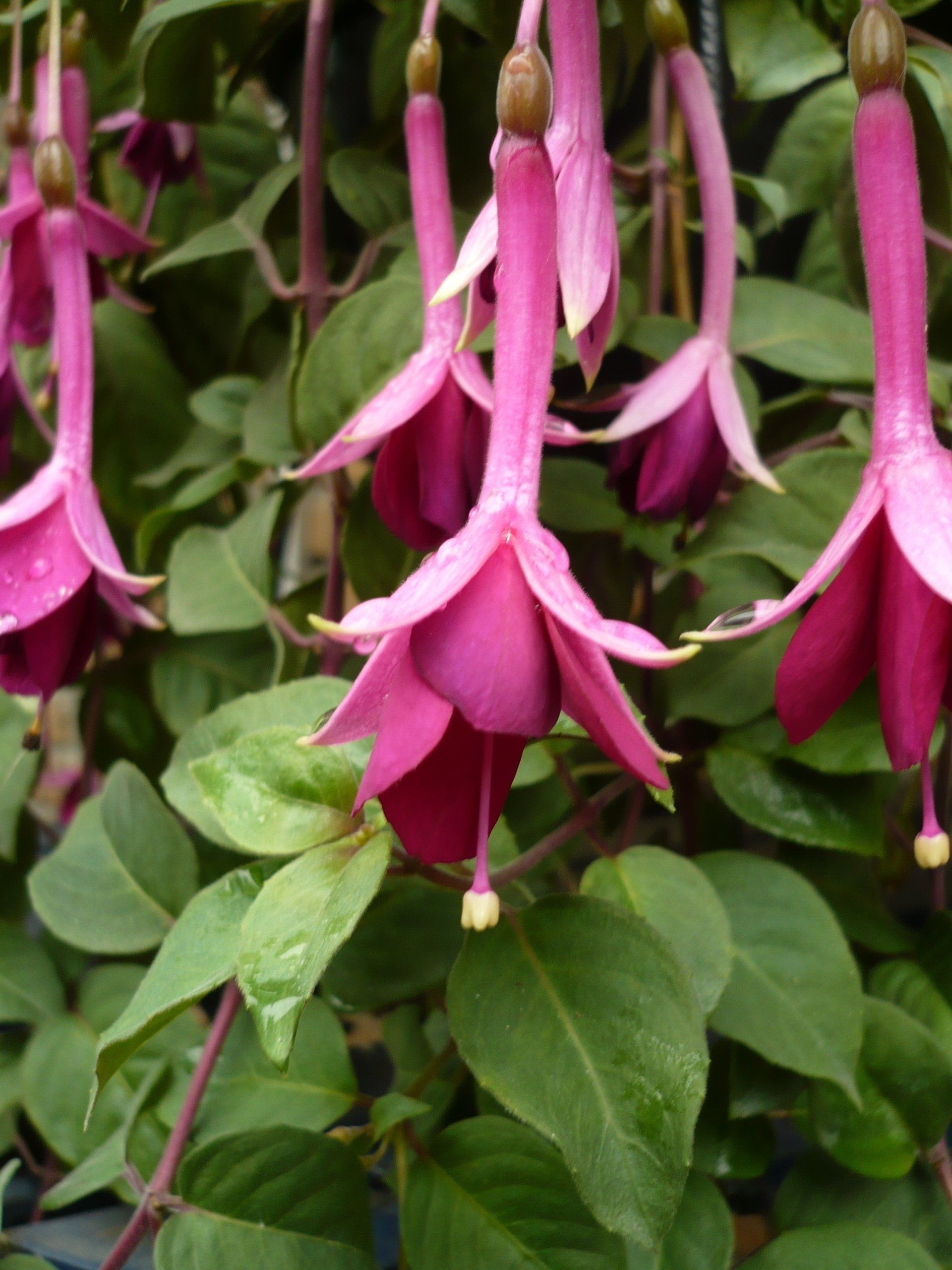
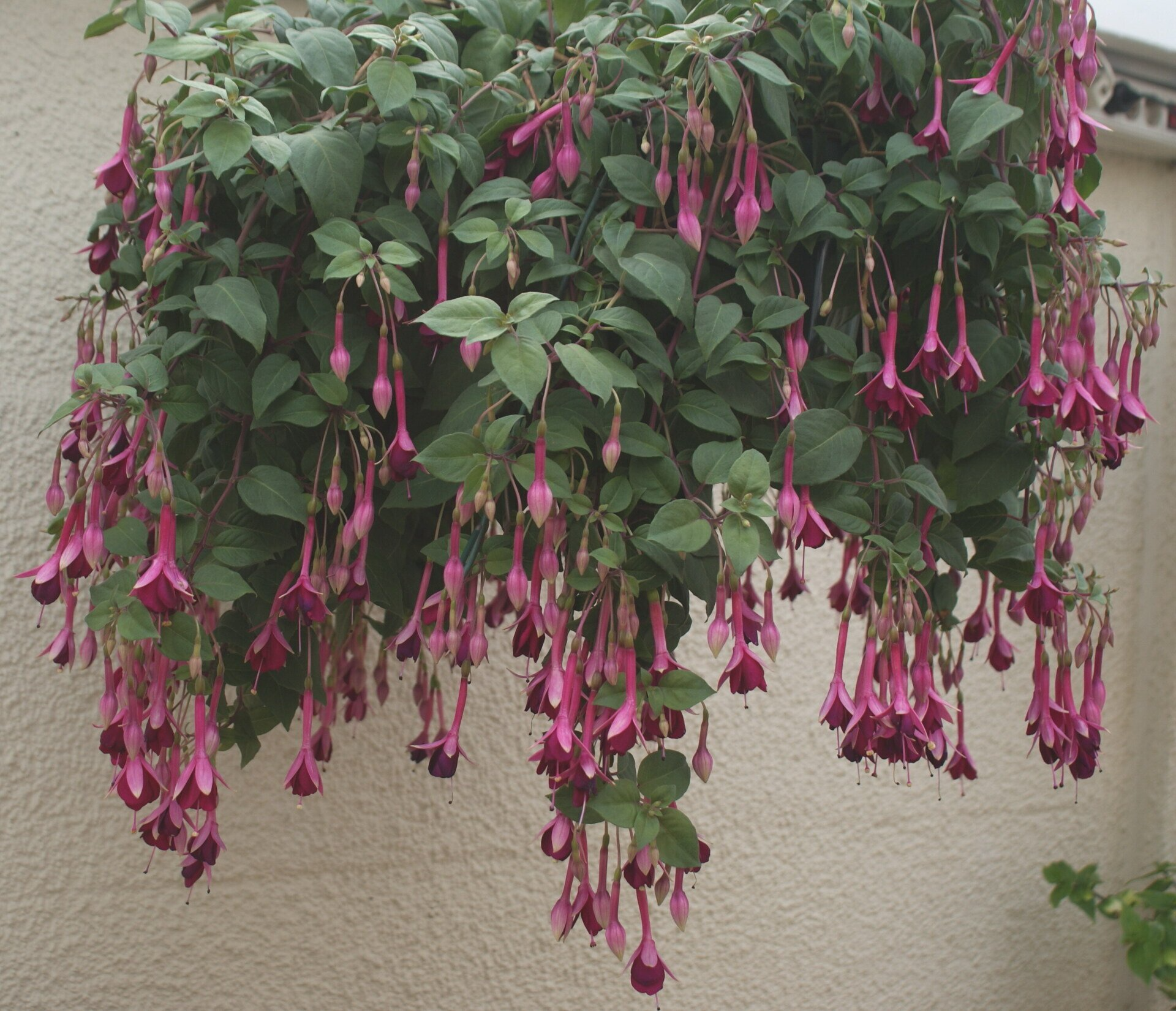
Roman Emperor
Fuchsia ‘Roman Emperor’ (De Cooker, 2022) originates from the crossing of seedlings N 16-47 x N 14-10.
N 16-47 is a triphylla seedling with an excellent purple colour, originating from ’Strike The Viol’ (= (‘Göttingen’ x ‘Our Ted’) x (‘Göttingen’ x ‘Our Ted’); De Cooker, 2012) x F. juntasensis.
N 14-10 has, among others, F. magdalenae, F. x colensoi and 'Jaspers Indestructible' in its ancestors.
'Roman Emperor' is a floriferous Bordeaux-purple triphylla that is best grown as a semi-trailing plant. She does not need any special treatment and blooms all season long. Overwintering is without any problems.
The name of the cultivar refers to the use and significance of the colour purple in ancient times. Purple was the colour worn by Roman magistrates; it became the imperial colour worn by the rulers of the Byzantine Empire and the Holy Roman Empire, and later by Roman Catholic bishops. Similarly in Japan, the colour is traditionally associated with the emperor and aristocracy (source: Wikipedia).
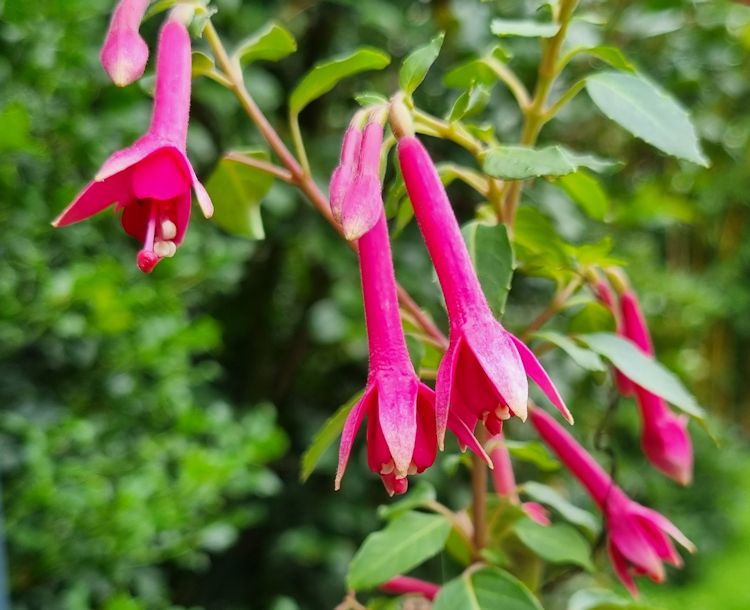
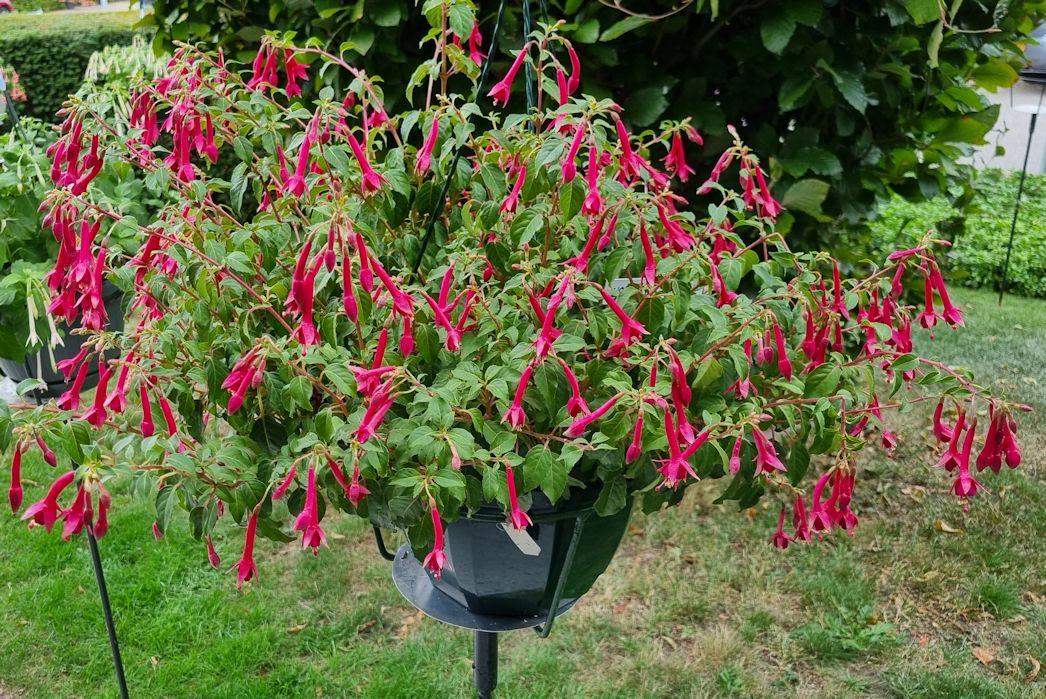
Scarlet Jester
Fuchsia ‘Scarlet Jester’ (De Cooker, 2010) is a triphylla hybrid fuchsia which originates from crossing ('Göttingen' x 'Our Ted') x F. magellanica ‘Alba’, the latter being one of the most hardy fuchsias available. 'Scarlet Jester' has inherited F. magellanica ‘Alba’ ‘s excellent hardiness, but has preserved a clear triphylla type shaped flower. Flowering is proliferously and continues till the start of the winter season. It can be grown in full sun for the whole day at temperatures up to 40 oC.
'Scarlet Jester' can best be grown as a wide semi-upward growing fuchsia, 5 – 10 cuttings in a large container. Growing it as a standard is difficult, and is therefore not recommended because the result will be disappointing. Best performance is as an older plant, which does not need repotting for at least 10 years. It is one of the easiest to grow fuchsias. Best way of growing this fuchsia is cutting back all branches to 1 – 3 cm above ground level at the end of October, and from that moment on leave it growing in the greenhouse on its own, without doing any pinching as it is perfectly self-branching.
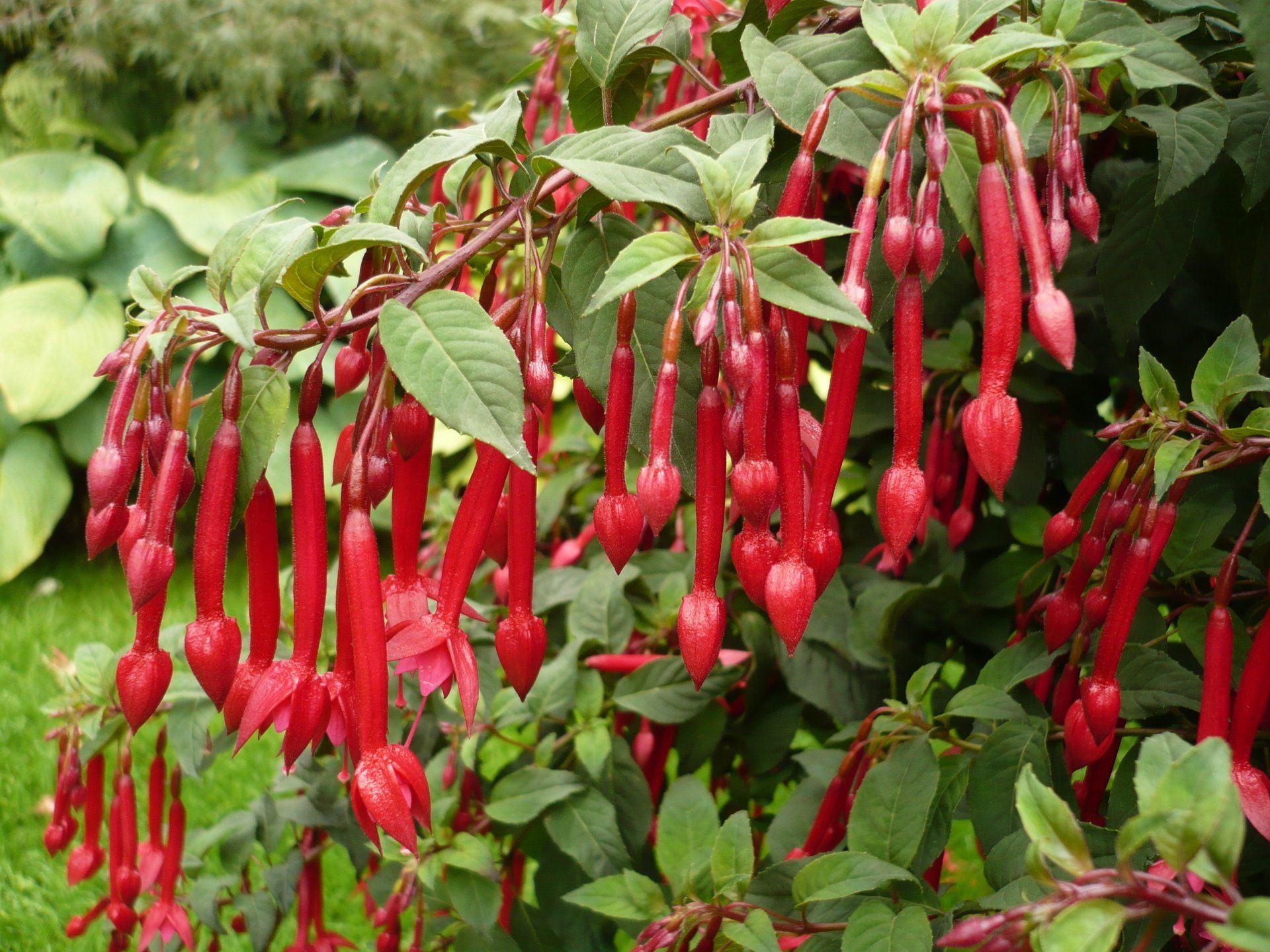
From the end of June onwards, the plant will then be overloaded with literally many hundreds, even thousands of scarlet flowers. For achieving this, some patience will however be required. It can be grown outdoors as a hardy fuchsia, but it is most fit for such garden cultivation in an environment with rather mild winters with an early start of the spring

season (as is customary in, e.g., part of the United Kingdom), because otherwise flowering will start only rather late.
The name ‘Scarlet Jester’ is inspired by the famous English snooker player Mark Selby, also nicknamed ‘The Jester from Leicester’.
Silence is Golden
Fuchsia ‘Silence is Golden’ (De Cooker, 2016) is a mini-Triphylla cultivar originating from the crossing (‘Göttingen’ x ‘Our Ted’) x F. fulgens 'Gesneriana'. This cultivar has been produced in the hybridisation project aimed at investigating the gene silencing effect induced in this crossing, leading to very small flowers. More information on this project can be found in The Fuchsia Breeders Initiative, Issue 7 (July 2016).
The cultivar's name ‘Silence Is Golden’ refers indeed to this gene silencing effect inducing the small blooms in the progeny of this crossing. It brings of course, for many of us, back to mind also the beautiful song Silence is Golden, launched and sung by the English Rock & Roll band The Tremeloes in 1967.
‘Silence Is Golden’ has an extremely small, Encliandra-like pink tube of only 10 mm, a small whitish pink corolla and attractive dark green-brown foliage. It can be grown as a small bush, or mini-standard. Overwintering in the cold greenhouse does not cause any problems.
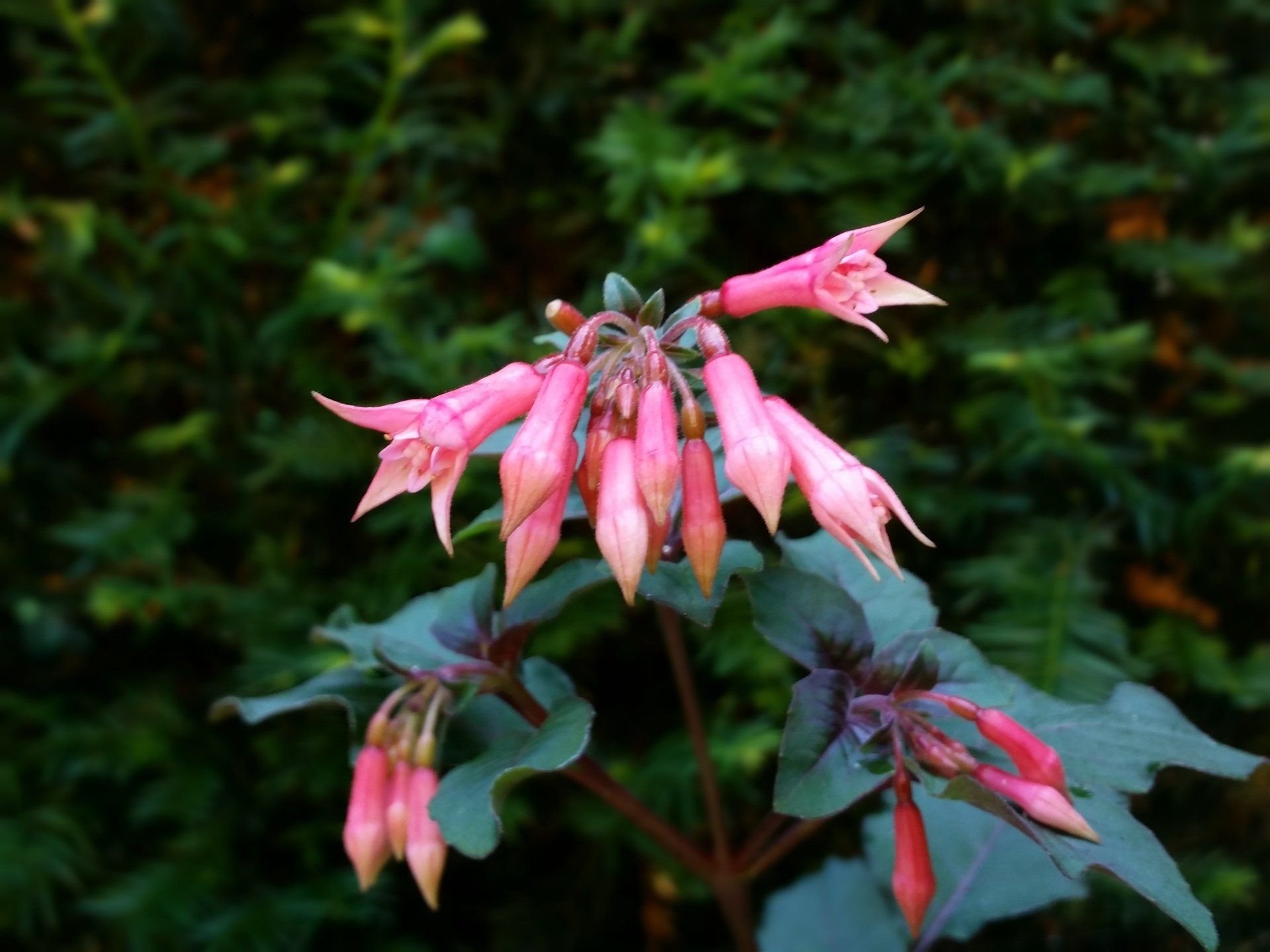
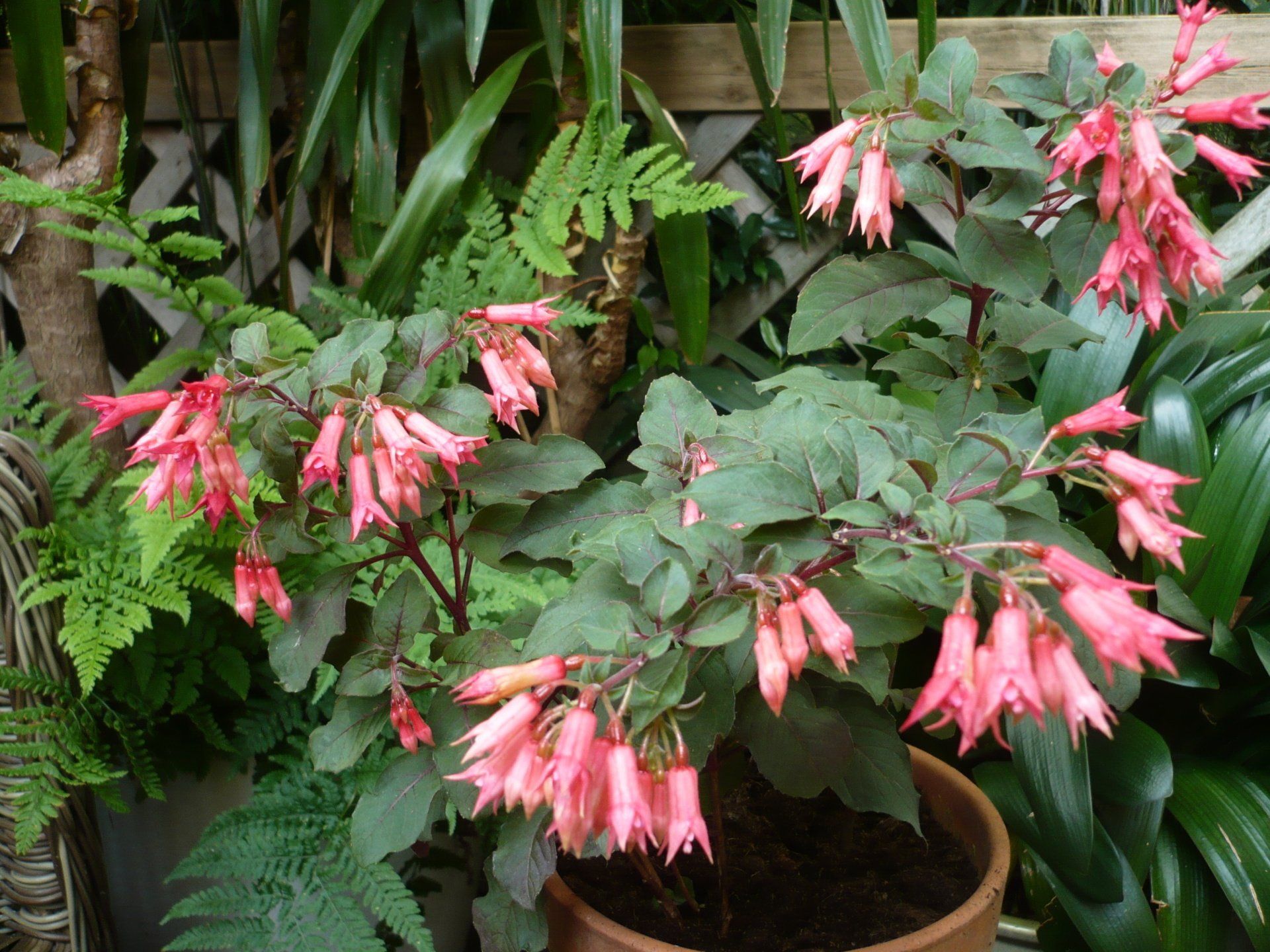
Silver Charm
Fuchsia ‘Silver Charm’ (De Cooker, 2022) is a semi-trailing, floriferous triphylla fuchsia cultivar, originating from the crossing (((‘Göttingen’ x ‘Our Ted’) x (‘Göttingen’ x ‘Our Ted’)) x ‘Purcellian Elegancy’) x ‘Jaspers Indestructible’. It has a slender, white tube and a soft pink corolla. It can be grown as an older plant. However, the best results are obtained by growing it from autumn cuttings, three to five cuttings in a basket. Flowering starts early and continues until the end of summer.
'Silver Charm' cuttings root very easily. Overwintering in the cold greenhouse is without any problems.
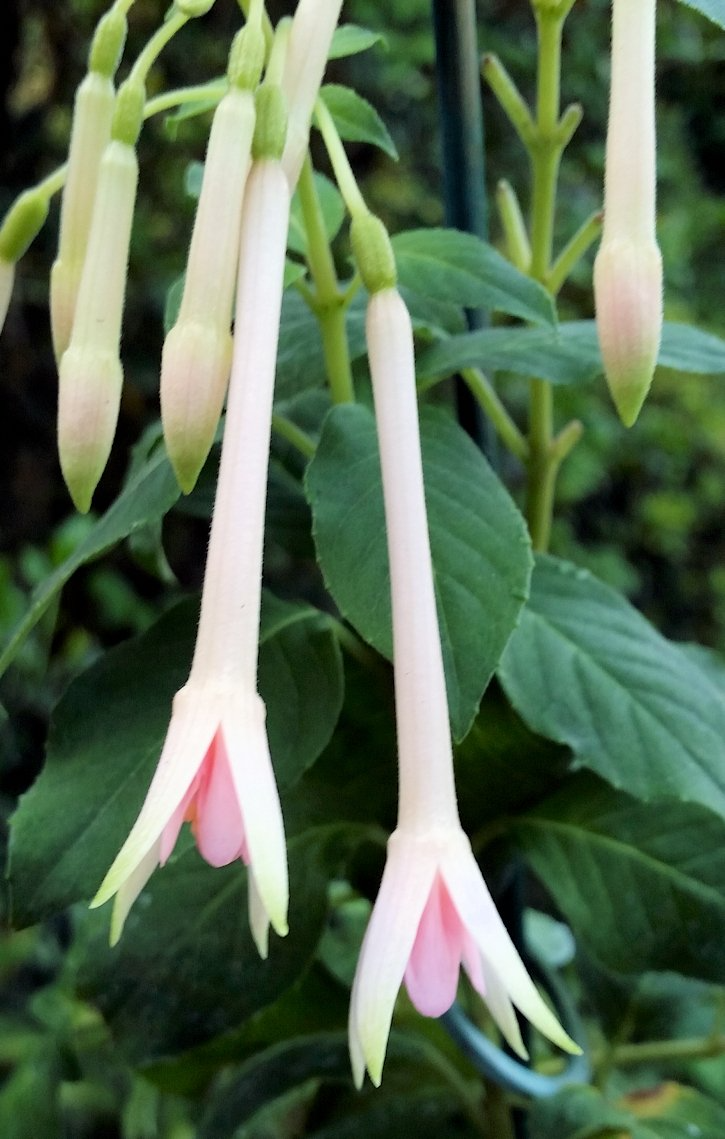

Silver Chime
Fuchsia ‘Silver Chime’ (De Cooker, 2016) originates from the crossing (‘Strike The Viol’ x ‘Delicate White’) x (‘Jaspers Indestructible’). Colour of the rather long tube and the sepals and petals is soft pink to near white, depending on growing conditions. It’s a natural trailer, which apparently is a stroke of luck in making this crossing because such property does not appear in its parentage. The (near) white colour of course is no coincidence, as it is contained in all of its parents, in e.g. ‘Strike The Viol’ via ‘Our Ted’. The name ‘Silver Chime’ reflects the cultivar’s silvery coloured wind chime appearance. It’s rather late flowering, first blooms being produced at the end of June/beginning of July.
‘Silver Chime’ can best be grown from autumn or late winter cuttings, but can also be grown successfully as an older plant. By properly shaping of the plant in the first growing season, the older plant needs no pinching because of its excellent branching properties.
One of the parents, the seedling 'Jaspers Indestructible’ has been produced by the Dutch hybridist Hans van Aspert. This seedling has also been used in producing Fuchsia ‘Ícicles Chandelier’ (De Cooker, 2015).
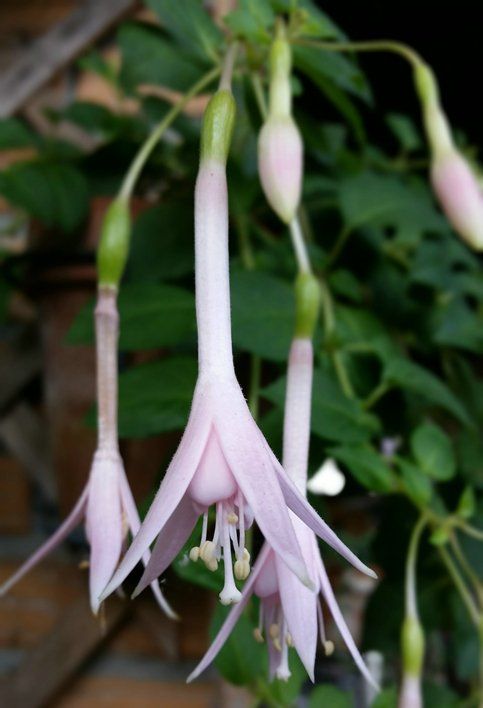

Skyward Dwarf
Fuchsia ‘Skyward Dwarf’ (De Cooker, 2016) is a mini-Triphylla cultivar originating from the crossing (‘Göttingen’ x ‘Our Ted’) x F. fulgens 'Gesneriana'. This cultivar has been produced in the hybridisation project aimed at investigating the gene silencing effect induced in this crossing, leading to very small flowers.
The cultivar's name ‘Skyward Dwarf’ refers to the small upstanding pink blooms, having a tube length of only 11 mm. It has beautifully contrasting dark green-brown foliage.
‘Skyward Dwarf’ can best be grown as a small bush or standard. Overwintering in the cold greenhouse is without any problems.
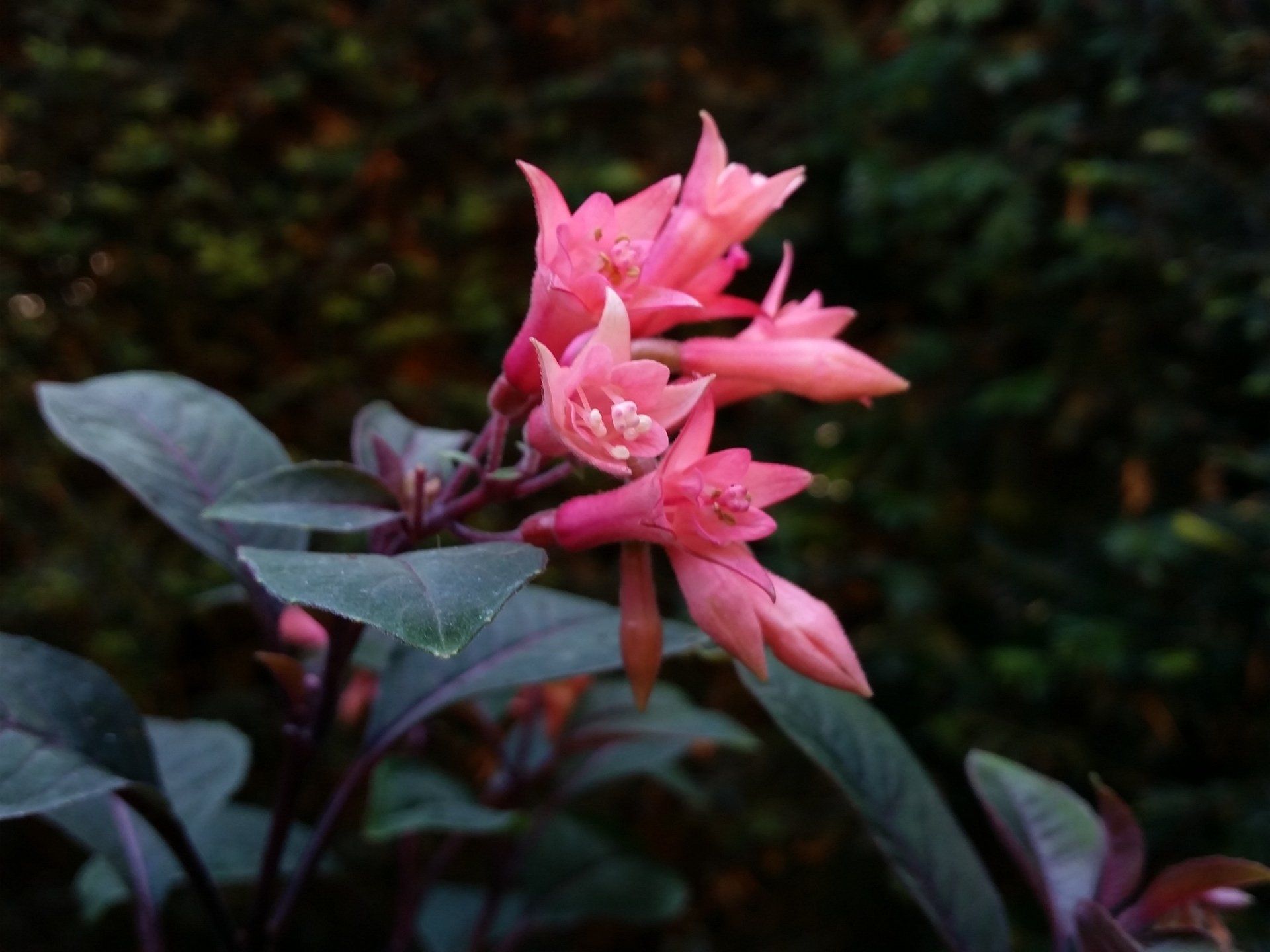
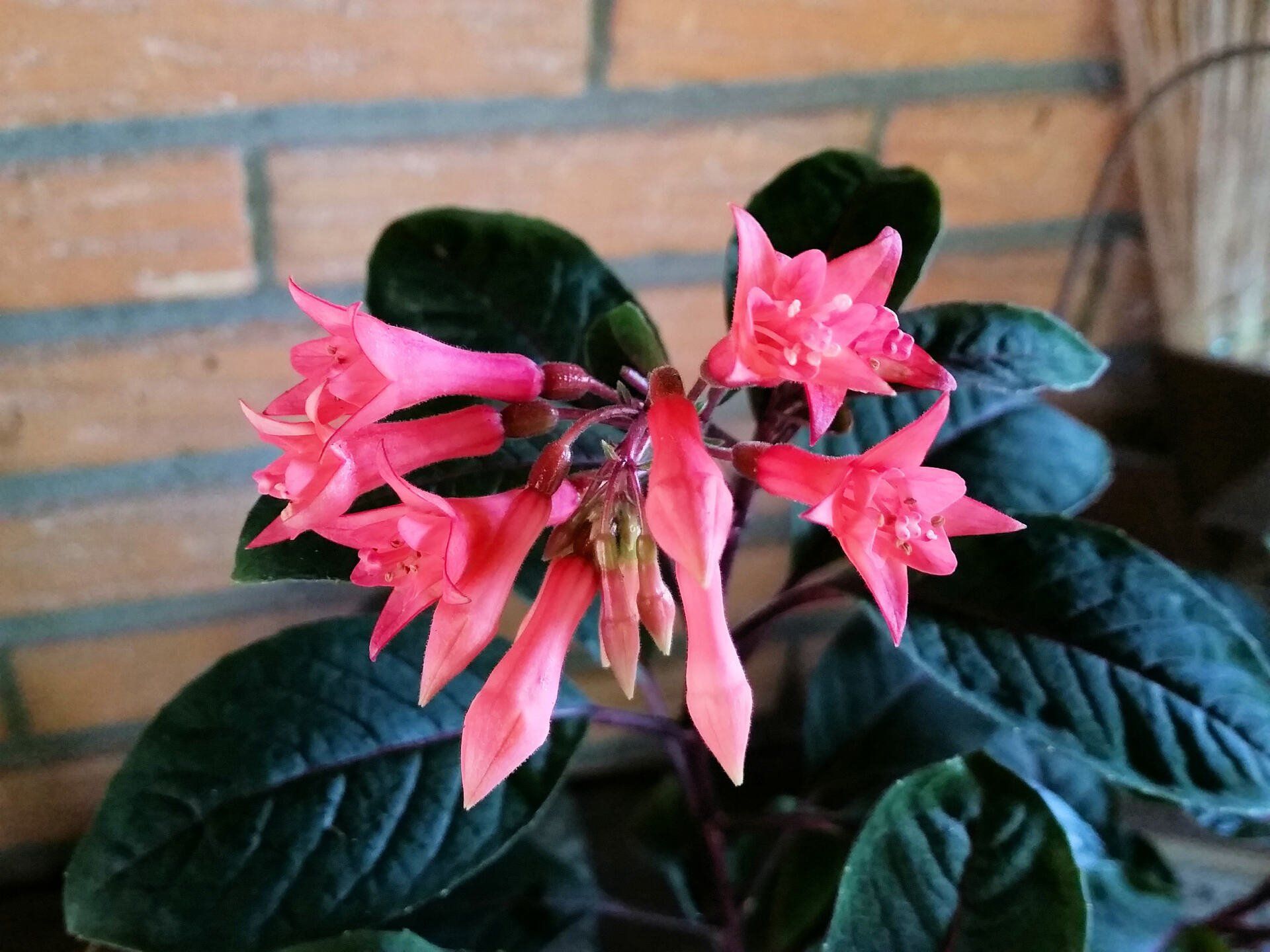
White Twinkle
Triphylla Fuchsia ‘White Twinkle’ (De Cooker, 2020) originates from the crossing (Göttingen’ x ‘Our Ted’) x ‘Purcellian Grace’. It has small, near pure white triphylla blooms and dark green foliage.
‘White Twinkle’ is a compact, real dwarf fuchsia. It’s a slow grower and because of its exceptionally small size at least three cuttings are required for filling a small pot. Making a bonsai standard is also possible.
Flowers are produced all summer through. It tolerates sun and high temperatures, but it prefers to be grown in filtered light. Overwintering in the cold greenhouse does not cause any problems.
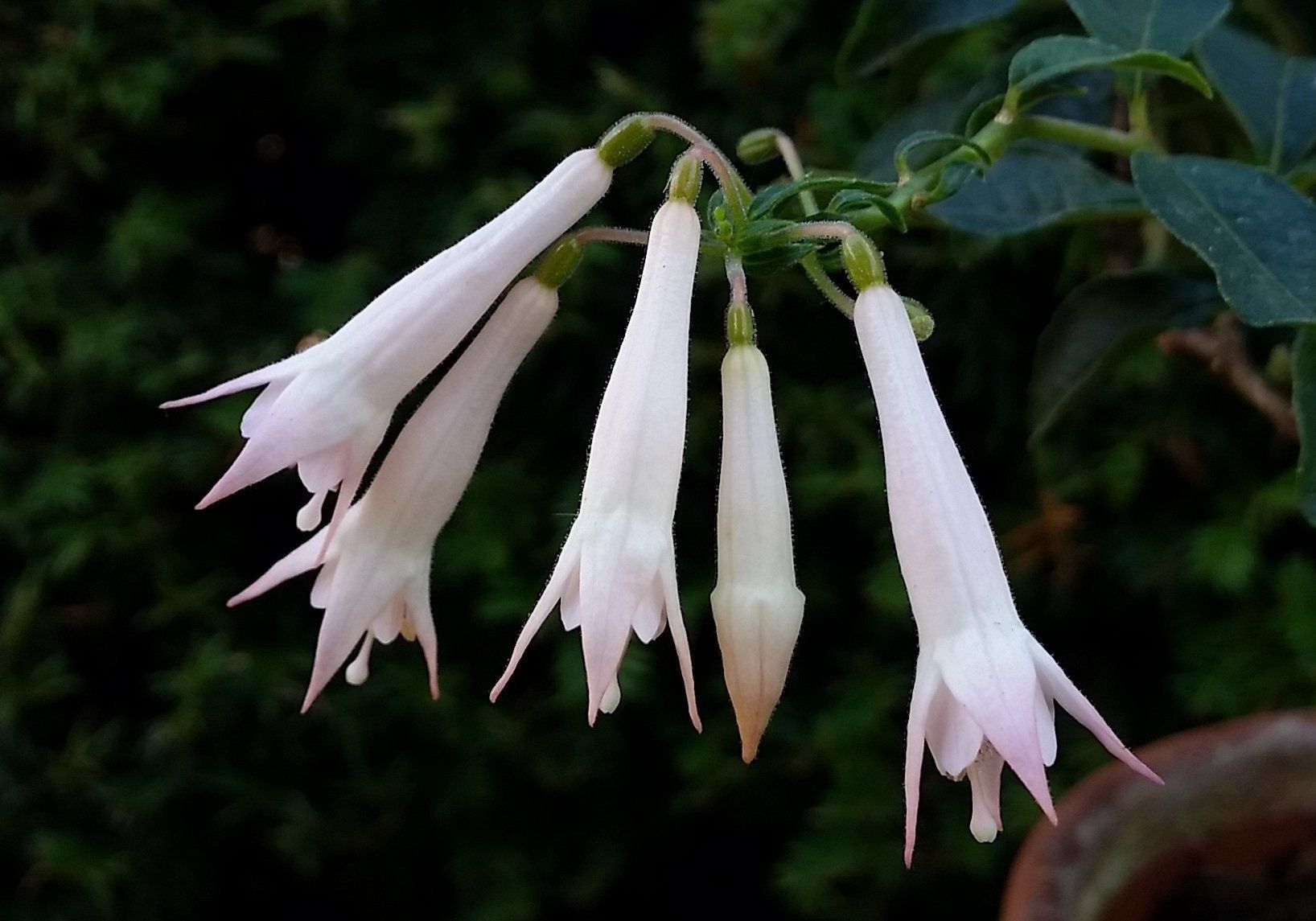
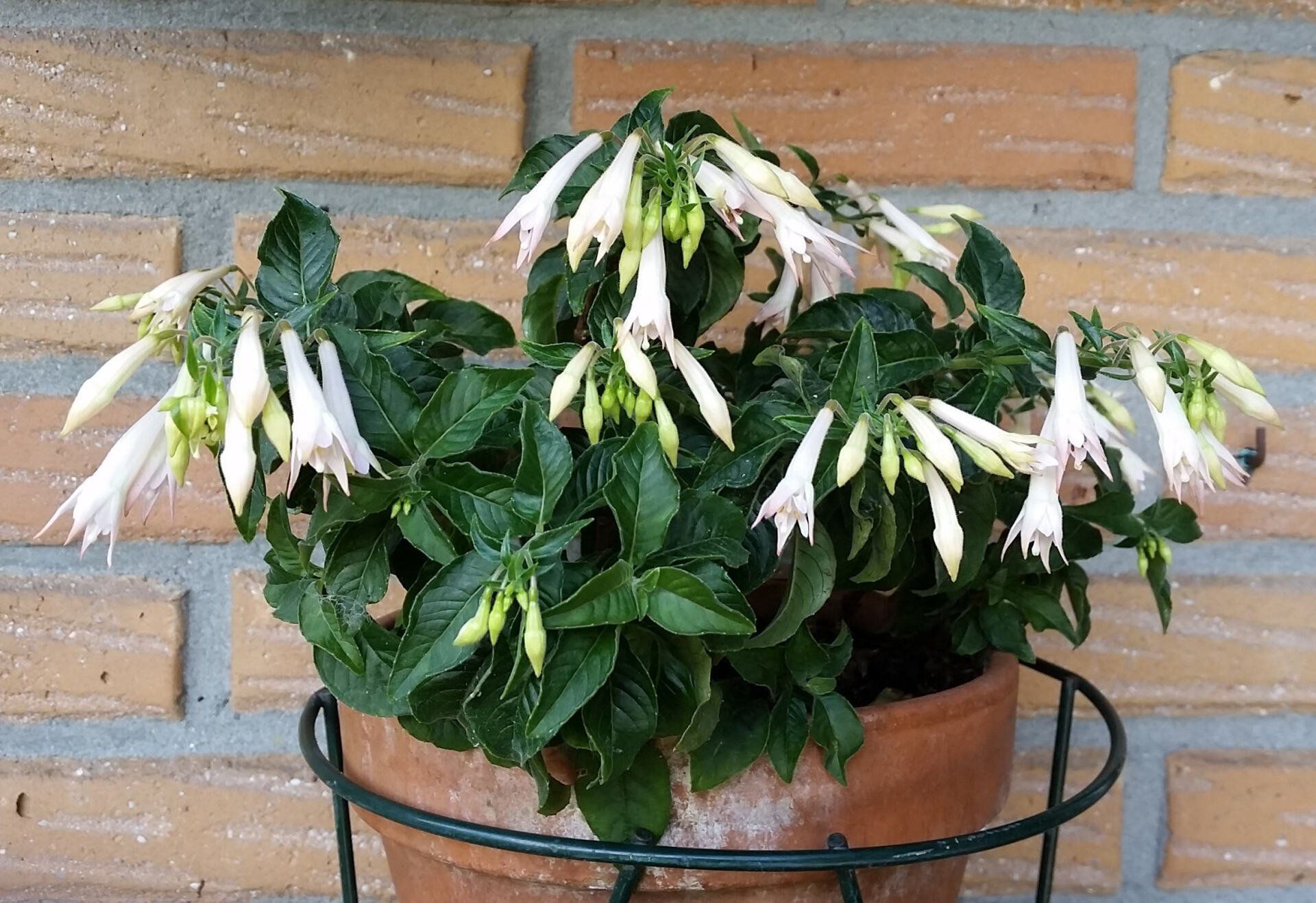
Winter has Passed
Triphylla type Fuchsia ‘Winter has Passed’ (De Cooker, 2016) is a cultivar originating from the crossing (‘Roger de Cooker’ x {(‘Checkerboard’ x ‘Machu Picchu’) x (‘Checkerboard’ x ‘Machu Picchu’)}. It is a seedling dating from 2008 as a spin-off from the program for developing white Triphylla cultivars.
The cultivar’s name ’Winter has Passed’ refers to the first blooms showing up already early in the season, when winter has passed. Best flowers are however obtained during the summer season.
It cannot deny its lineage from ‘Roger de Cooker’. Its blooms have a rather long white tube and a pale pink corolla, but its tube is thinner and sepals are longer than ‘Roger de Cooker’ ‘s.
‘Winter has Passed’ can best be grown as a relatively small semi-trailing plant, both as an older plant or starting from autumn or early season cuttings. Overwintering in the cold greenhouse will not cause any problems.
It has been used a couple of times in the hybridisation programme. It produces not any pollen, but has successfully been used as the female parent for producing ‘Aphaia’ and ’Pavilion Princess’.
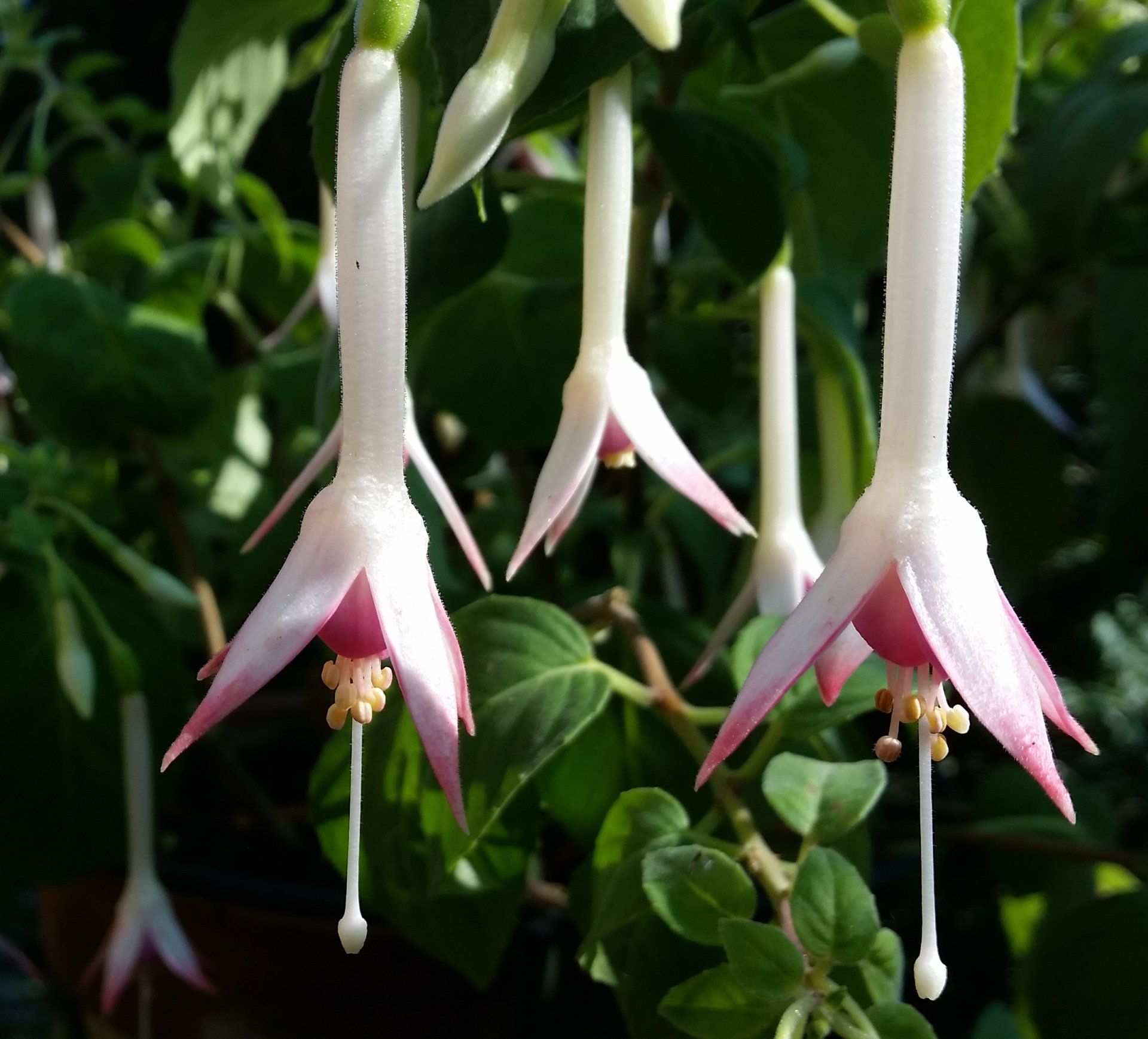
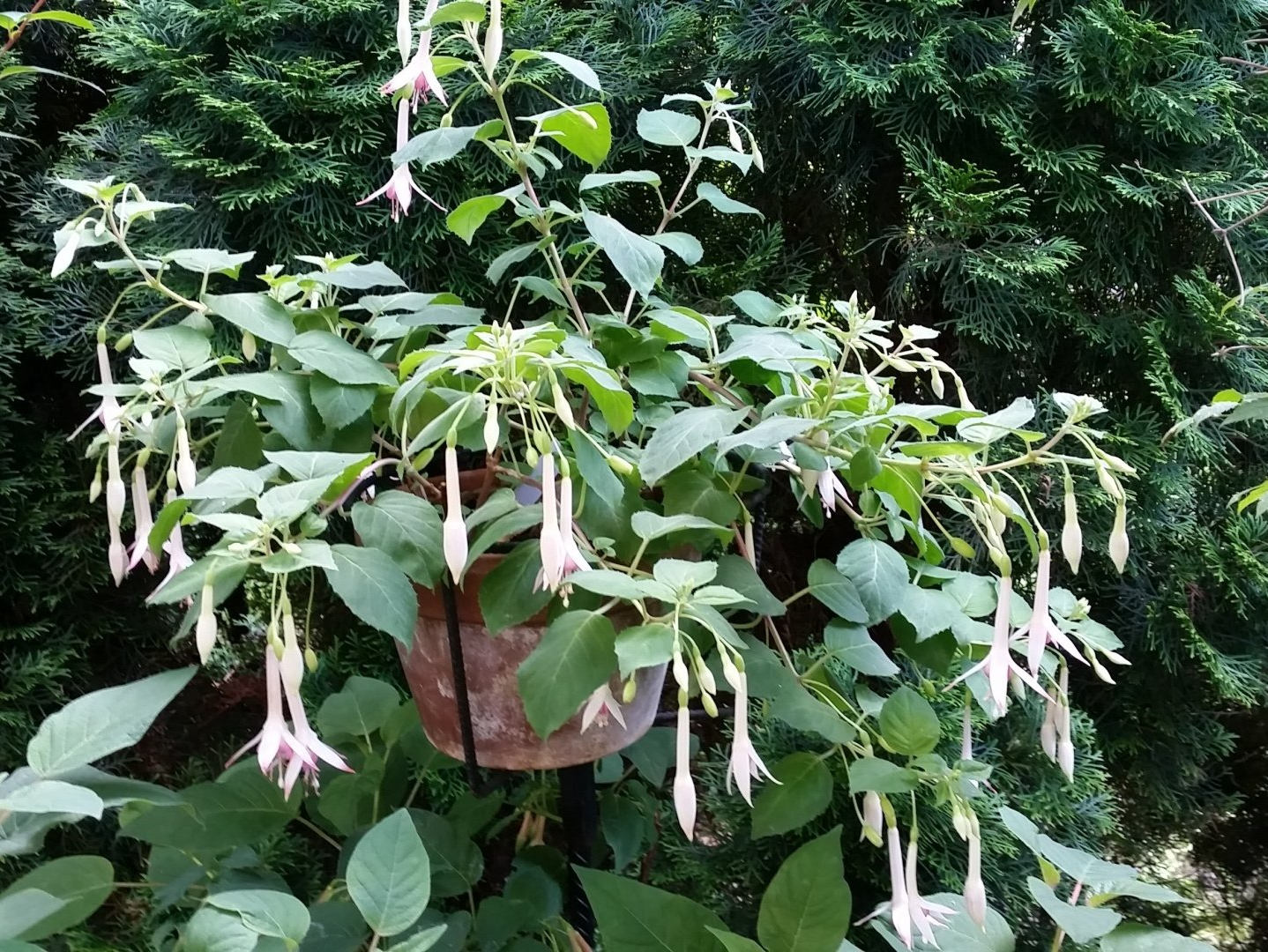
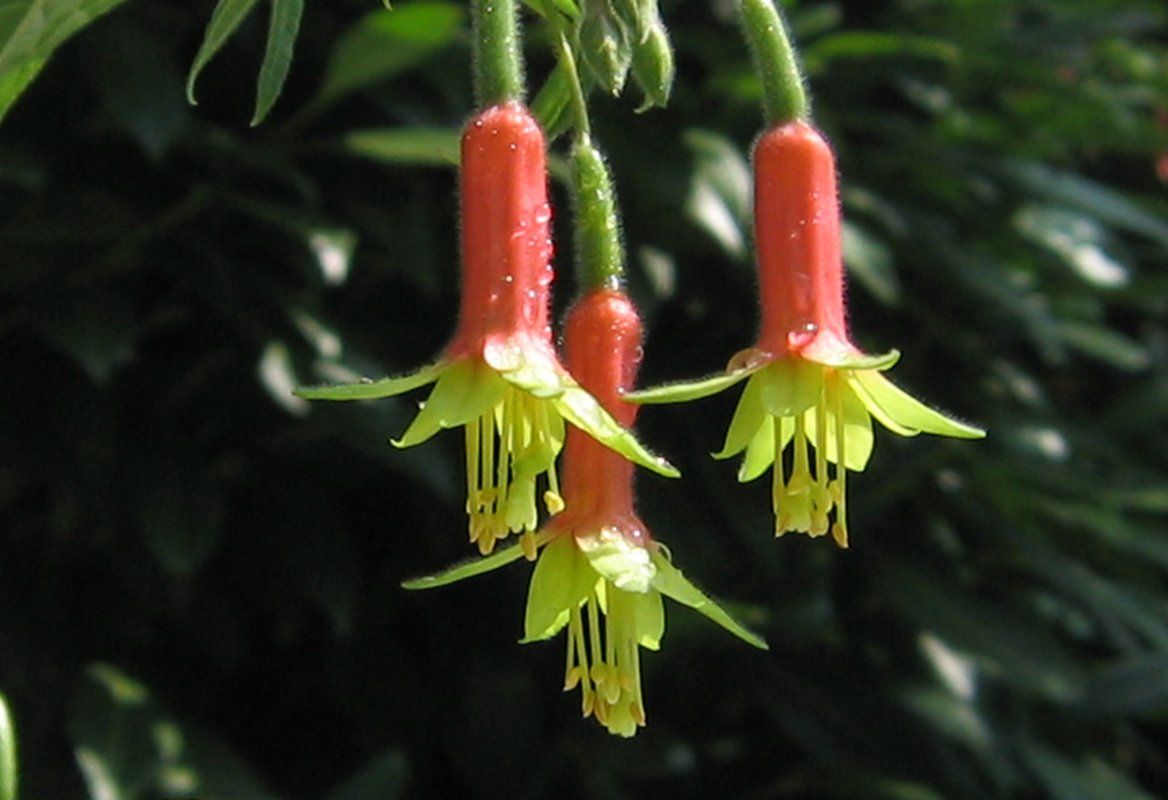
Contact
+31 475 552227
e-mail: fuchsia@decooker.nl
Graaf de Hompeschstraat 9
6109AK Ohé en Laak
The Netherlands
All Rights Reserved
The Fuchsia Breeders Initiative